|
UNITED STATES
SECURITIES AND EXCHANGE COMMISSION
Washington, DC 20549
FORM 10-Q
(Mark One) |
|
☑ | Quarterly report pursuant to Section 13 or 15(d) of the Securities Exchange Act of 1934 |
|
|
| For the quarterly period ended March 31, 2018 |
|
|
or | |
|
|
o | Transition report pursuant to Section 13 or 15(d) of the Securities Exchange Act of 1934 |
|
|
| For the transition period from __________ to __________ |
|
|
| Commission file number 1-3950 |
Ford Motor Company
(Exact name of Registrant as specified in its charter)
Delaware | 38-0549190 |
(State of incorporation) | (I.R.S. Employer Identification No.) |
|
|
One American Road, Dearborn, Michigan | 48126 |
(Address of principal executive offices) | (Zip Code) |
313-322-3000
(Registrant's telephone number, including area code)
Indicate by check mark if the registrant (1) has filed all reports required to be filed by Section 13 or 15(d) of the Securities Exchange Act of 1934 during the preceding 12 months (or for such shorter period that the registrant was required to file such reports), and (2) has been subject to such filing requirements for the past 90 days. Yes ☑ No o
Indicate by check mark whether the registrant has submitted electronically and posted on its corporate Web site, if any, every Interactive Data File required to be submitted and posted pursuant to Rule 405 of Regulation S-T (§232.405 of this chapter) during the preceding 12 months (or for such shorter period that the registrant was required to submit and post such files). Yes ☑ No o
Indicate by check mark whether the registrant is a large accelerated filer, an accelerated filer, a non-accelerated filer, a smaller reporting company, or an emerging growth company. See definitions of "large accelerated filer," "accelerated filer," "smaller reporting company," and "emerging growth company" in Rule 12b-2 of the Exchange Act. Large accelerated filer ☑ Accelerated filer o Non-accelerated filer o Smaller reporting company o Emerging growth company o
If an emerging growth company, indicate by check mark if the registrant has elected not to use the extended transition period for complying with any new or revised financial accounting standards provided pursuant to Section 13(a) of the Exchange Act. o
Indicate by check mark whether the registrant is a shell company (as defined in Rule 12b-2 of the Exchange Act). Yes o No ☑
As of April 20, 2018, Ford had outstanding 3,914,101,588 shares of Common Stock and 70,852,076 shares of Class B Stock.
67 |
|
FORD MOTOR COMPANY
QUARTERLY REPORT ON FORM 10-Q
For the Quarter Ended March 31, 2018
| Table of Contents |
| Page |
| Part I - Financial Information |
|
|
Item 1 | Financial Statements |
| 1 |
| Consolidated Income Statement |
| 1 |
| Consolidated Statement of Comprehensive Income |
| 1 |
| Consolidated Balance Sheet |
| 2 |
| Condensed Consolidated Statement of Cash Flows |
| 3 |
| Consolidated Statement of Equity |
| 4 |
| Notes to the Financial Statements |
| 5 |
| Report of Independent Registered Public Accounting Firm |
| 29 |
Item 2 | Management's Discussion and Analysis of Financial Condition and Results of Operations |
| 30 |
| Overview |
| 30 |
| Results of Operations |
| 32 |
| Automotive Segment |
| 34 |
| Mobility Segment |
| 43 |
| Ford Credit Segment |
| 44 |
| Corporate Other |
| 47 |
| Interest on Debt |
| 47 |
| Special Items |
| 47 |
| Taxes |
| 47 |
| Liquidity and Capital Resources |
| 48 |
| Credit Ratings |
| 55 |
| Outlook |
| 56 |
| Non-GAAP Financial Measure Reconciliations |
| 57 |
| Supplemental Information |
| 60 |
| Cautionary Note on Forward-Looking Statements |
| 64 |
| Accounting Standards Issued But Not Yet Adopted |
| 65 |
| Review by Independent Registered Public Accounting Firm |
| 65 |
Item 3 | Quantitative and Qualitative Disclosures About Market Risk |
| 66 |
Item 4 | Controls and Procedures |
| 66 |
|
|
|
|
| Part II - Other Information |
|
|
Item 2 | Unregistered Sales of Equity Securities and Use of Proceeds |
| 67 |
Item 6 | Exhibits |
| 67 |
| Signature |
| 68 |
i
PART I. FINANCIAL INFORMATION
ITEM 1. Financial Statements.
FORD MOTOR COMPANY AND SUBSIDIARIES
CONSOLIDATED INCOME STATEMENT
(in millions, except per share amounts)
| For the periods ended March 31, | ||||||
| 2017 |
| 2018 | ||||
| First Quarter | ||||||
| (unaudited) | ||||||
Revenues |
|
|
| ||||
Automotive | $ | 36,475 | |
| $ | 39,012 | |
Ford Credit | 2,669 | |
| 2,943 | | ||
Mobility | 2 | |
| 4 | | ||
Total revenues (Note 3) | 39,146 | |
| 41,959 | | ||
|
|
|
| ||||
Costs and expenses |
|
|
| ||||
Cost of sales | 32,700 | |
| 35,753 | | ||
Selling, administrative, and other expenses | 2,764 | |
| 2,747 | | ||
Ford Credit interest, operating, and other expenses | 2,218 | |
| 2,338 | | ||
Total costs and expenses | 37,682 | |
| 40,838 | | ||
|
|
|
| ||||
Interest expense on Automotive debt | 279 | |
| 275 | | ||
Interest expense on Other debt | 14 | |
| 14 | | ||
|
|
|
| ||||
Other income/(loss), net (Note 4) | 734 | |
| 863 | | ||
Equity in net income of affiliated companies | 346 | |
| 224 | | ||
Income before income taxes | 2,251 | | | 1,919 | | ||
Provision for/(Benefit from) income taxes | 652 | |
| 174 | | ||
Net income | 1,599 | |
| 1,745 | | ||
Less: Income/(Loss) attributable to noncontrolling interests | 7 | |
| 9 | | ||
Net income attributable to Ford Motor Company | $ | 1,592 | |
| $ | 1,736 | |
|
|
|
| ||||
EARNINGS PER SHARE ATTRIBUTABLE TO FORD MOTOR COMPANY COMMON AND CLASS B STOCK (Note 6) | |||||||
Basic income | $ | 0.40 | |
| $ | 0.44 | |
Diluted income | 0.40 | |
| 0.43 | | ||
|
|
|
| ||||
Cash dividends declared | 0.20 | |
| 0.28 | | ||
CONSOLIDATED STATEMENT OF COMPREHENSIVE INCOME
(in millions)
| For the periods ended March 31, | ||||||
| 2017 |
| 2018 | ||||
| First Quarter | ||||||
| (unaudited) | ||||||
Net income | $ | 1,599 | |
| $ | 1,745 | |
Other comprehensive income/(loss), net of tax (Note 16) |
|
|
| ||||
Foreign currency translation | 242 | |
| 295 | | ||
Marketable securities | (1 | ) |
| (47 | ) | ||
Derivative instruments | (168 | ) |
| 33 | | ||
Pension and other postretirement benefits | 9 | |
| 8 | | ||
Total other comprehensive income/(loss), net of tax | 82 | |
| 289 | | ||
Comprehensive income | 1,681 | |
| 2,034 | | ||
Less: Comprehensive income/(loss) attributable to noncontrolling interests | 5 | |
| 8 | | ||
Comprehensive income attributable to Ford Motor Company | $ | 1,676 | |
| $ | 2,026 | |
The accompanying notes are part of the financial statements.
1
Item 1. Financial Statements (Continued)
FORD MOTOR COMPANY AND SUBSIDIARIES
CONSOLIDATED BALANCE SHEET
(in millions)
| December 31, |
| March 31, | ||||
| (unaudited) | ||||||
ASSETS |
|
|
| ||||
Cash and cash equivalents (Note 7) | $ | 18,492 | |
| $ | 17,940 | |
Marketable securities (Note 7) | 20,435 | |
| 22,131 | | ||
Ford Credit finance receivables, net (Note 8) | 52,210 | |
| 54,680 | | ||
Trade and other receivables, less allowances of $392 and $411 | 10,599 | |
| 12,386 | | ||
Inventories (Note 10) | 11,176 | |
| 12,371 | | ||
Other assets | 3,889 | |
| 3,756 | | ||
Total current assets | 116,801 | |
| 123,264 | | ||
|
|
|
| ||||
Ford Credit finance receivables, net (Note 8) | 56,182 | |
| 57,121 | | ||
Net investment in operating leases | 28,235 | |
| 28,331 | | ||
Net property | 35,327 | |
| 36,118 | | ||
Equity in net assets of affiliated companies | 3,085 | |
| 3,213 | | ||
Deferred income taxes | 10,762 | |
| 10,637 | | ||
Other assets | 8,104 | |
| 8,546 | | ||
Total assets | $ | 258,496 | |
| $ | 267,230 | |
|
|
|
| ||||
LIABILITIES |
| |
|
| | ||
Payables | $ | 23,282 | |
| $ | 25,480 | |
Other liabilities and deferred revenue (Note 12) | 19,697 | |
| 21,415 | | ||
Automotive debt payable within one year (Note 14) | 3,356 | |
| 3,751 | | ||
Ford Credit debt payable within one year (Note 14) | 48,265 | |
| 49,232 | | ||
Total current liabilities | 94,600 | |
| 99,878 | | ||
|
|
|
| ||||
Other liabilities and deferred revenue (Note 12) | 24,711 | |
| 24,845 | | ||
Automotive long-term debt (Note 14) | 12,575 | |
| 12,071 | | ||
Ford Credit long-term debt (Note 14) | 89,492 | |
| 92,681 | | ||
Other long-term debt (Note 14) | 599 | |
| 599 | | ||
Deferred income taxes | 815 | |
| 622 | | ||
Total liabilities | 222,792 | |
| 230,696 | | ||
|
|
|
| ||||
Redeemable noncontrolling interest | 98 | |
| 98 | | ||
|
|
|
| ||||
EQUITY |
| |
|
| | ||
Common Stock, par value $.01 per share (3,998 million shares issued of 6 billion authorized) | 40 | |
| 40 | | ||
Class B Stock, par value $.01 per share (71 million shares issued of 530 million authorized) | 1 | |
| 1 | | ||
Capital in excess of par value of stock | 21,843 | |
| 21,841 | | ||
Retained earnings | 21,906 | |
| 22,529 | | ||
Accumulated other comprehensive income/(loss) (Note 16) | (6,959 | ) |
| (6,669 | ) | ||
Treasury stock | (1,253 | ) |
| (1,342 | ) | ||
Total equity attributable to Ford Motor Company | 35,578 | |
| 36,400 | | ||
Equity attributable to noncontrolling interests | 28 | |
| 36 | | ||
Total equity | 35,606 | |
| 36,436 | | ||
Total liabilities and equity | $ | 258,496 | |
| $ | 267,230 | |
The following table includes assets to be used to settle liabilities of the consolidated variable interest entities ("VIEs"). These assets and liabilities are included in the consolidated balance sheet above. | |||||||
| December 31, |
| March 31, | ||||
| (unaudited) | ||||||
ASSETS |
|
|
| ||||
Cash and cash equivalents | $ | 3,479 | |
| $ | 2,866 | |
Ford Credit finance receivables, net | 56,250 | |
| 59,145 | | ||
Net investment in operating leases | 11,503 | |
| 11,984 | | ||
Other assets | 64 | |
| 63 | | ||
LIABILITIES |
|
|
| ||||
Other liabilities and deferred revenue | $ | 2 | |
| $ | 5 | |
Debt | 46,437 | |
| 50,366 | | ||
The accompanying notes are part of the financial statements.
2
Item 1. Financial Statements (Continued)
FORD MOTOR COMPANY AND SUBSIDIARIES
CONDENSED CONSOLIDATED STATEMENT OF CASH FLOWS
(in millions)
| For the periods ended March 31, | ||||||
| 2017 |
| 2018 | ||||
| First Quarter | ||||||
| (unaudited) | ||||||
Cash flows from operating activities |
|
|
| ||||
Net cash provided by/(used in) operating activities | $ | 4,336 | |
| $ | 3,514 | |
|
|
|
| ||||
Cash flows from investing activities |
|
|
| ||||
Capital spending | (1,706 | ) |
| (1,779 | ) | ||
Acquisitions of finance receivables and operating leases | (13,467 | ) |
| (15,683 | ) | ||
Collections of finance receivables and operating leases | 10,695 | |
| 12,956 | | ||
Purchases of equity and debt securities | (8,878 | ) |
| (7,867 | ) | ||
Sales and maturities of equity and debt securities | 9,551 | |
| 6,040 | | ||
Settlements of derivatives | 156 | |
| (61 | ) | ||
Other | (3 | ) |
| (150 | ) | ||
Net cash provided by/(used in) investing activities | (3,652 | ) |
| (6,544 | ) | ||
|
|
|
| ||||
Cash flows from financing activities |
| |
|
| | ||
Cash dividends | (795 | ) |
| (1,113 | ) | ||
Purchases of common stock | - | |
| (89 | ) | ||
Net changes in short-term debt | 658 | |
| (909 | ) | ||
Proceeds from issuance of other debt | 13,253 | |
| 16,953 | | ||
Principal payments on other debt | (11,911 | ) |
| (12,360 | ) | ||
Other | (85 | ) |
| (68 | ) | ||
Net cash provided by/(used in) financing activities | 1,120 | |
| 2,414 | | ||
|
|
|
| ||||
Effect of exchange rate changes on cash, cash equivalents, and restricted cash | 101 | |
| 115 | | ||
|
|
|
| ||||
Net increase/(decrease) in cash, cash equivalents, and restricted cash | $ | 1,905 | |
| $ | (501 | ) |
|
|
|
| ||||
Cash, cash equivalents, and restricted cash at January 1 (Note 7) | $ | 16,019 | |
| $ | 18,638 | |
Net increase/(decrease) in cash, cash equivalents, and restricted cash | 1,905 | |
| (501 | ) | ||
Cash, cash equivalents, and restricted cash at March 31 (Note 7) | $ | 17,924 | |
| $ | 18,137 | |
The accompanying notes are part of the financial statements.
3
Item 1. Financial Statements (Continued)
FORD MOTOR COMPANY AND SUBSIDIARIES
CONSOLIDATED STATEMENT OF EQUITY
(in millions, unaudited)
| Equity Attributable to Ford Motor Company |
|
|
|
| ||||||||||||||||||||||||||
| Capital Stock |
| Cap. in Excess of Par Value of Stock |
| Retained Earnings |
| Accumulated Other Comprehensive Income/(Loss) (Note 16) |
| Treasury Stock |
| Total |
| Equity Attributable to Non-controlling Interests |
| Total Equity | ||||||||||||||||
Balance at December 31, 2016 | $ | 41 | |
| $ | 21,630 | |
| $ | 16,193 | |
| $ | (7,013 | ) |
| $ | (1,122 | ) |
| $ | 29,729 | |
| $ | 17 | |
| $ | 29,746 | |
Adoption of accounting standards | - | |
| 6 | |
| 566 | |
| - | |
| - | |
| 572 | |
| - | |
| 572 | | ||||||||
Net income | - | |
| - | |
| 1,592 | |
| - | |
| - | |
| 1,592 | |
| 7 | |
| 1,599 | | ||||||||
Other comprehensive income/(loss), net of tax | - | |
| - | |
| - | |
| 84 | |
| - | |
| 84 | |
| (2 | ) |
| 82 | | ||||||||
Common stock issued (including share-based compensation impacts) | - | |
| 1 | |
| - | |
| - | |
| - | |
| 1 | |
| - | |
| 1 | | ||||||||
Treasury stock/other | - | |
| - | |
| - | |
| - | |
| - | |
| - | |
| - | |
| - | | ||||||||
Cash dividends declared | - | |
| - | |
| (795 | ) |
| - | |
| - | |
| (795 | ) |
| - | |
| (795 | ) | ||||||||
Balance at March 31, 2017 | $ | 41 | |
| $ | 21,637 | |
| $ | 17,556 | |
| $ | (6,929 | ) |
| $ | (1,122 | ) |
| $ | 31,183 | |
| $ | 22 | |
| $ | 31,205 | |
|
|
|
|
|
|
|
|
|
|
|
|
|
|
|
| ||||||||||||||||
Balance at December 31, 2017 | $ | 41 | |
| $ | 21,843 | |
| $ | 21,906 | |
| $ | (6,959 | ) |
| $ | (1,253 | ) |
| $ | 35,578 | |
| $ | 28 | |
| $ | 35,606 | |
Net income | - | |
| - | |
| 1,736 | |
| - | |
| - | |
| 1,736 | |
| 9 | |
| 1,745 | | ||||||||
Other comprehensive income/(loss), net of tax | - | |
| - | |
| - | |
| 290 | |
| - | |
| 290 | |
| (1 | ) |
| 289 | | ||||||||
Common stock issued (including share-based compensation impacts) | - | |
| (2 | ) |
| - | |
| - | |
| - | |
| (2 | ) |
| - | |
| (2 | ) | ||||||||
Treasury stock/other | - | |
| - | |
| - | |
| - | |
| (89 | ) |
| (89 | ) |
| - | |
| (89 | ) | ||||||||
Cash dividends declared | - | |
| - | |
| (1,113 | ) |
| - | |
| - | |
| (1,113 | ) |
| - | |
| (1,113 | ) | ||||||||
Balance at March 31, 2018 | $ | 41 | |
| $ | 21,841 | |
| $ | 22,529 | |
| $ | (6,669 | ) |
| $ | (1,342 | ) |
| $ | 36,400 | |
| $ | 36 | |
| $ | 36,436 | |
The accompanying notes are part of the financial statements.
4
Item 1. Financial Statements (Continued)
FORD MOTOR COMPANY AND SUBSIDIARIES
NOTES TO THE FINANCIAL STATEMENTS
Table of Contents
Footnote |
| Page |
Note 1 | Presentation | 6 |
Note 2 | New Accounting Standards | 7 |
Note 3 | Revenue | 8 |
Note 4 | Other Income/(Loss) | 10 |
Note 5 | Income Taxes | 11 |
Note 6 | Capital Stock and Earnings Per Share | 11 |
Note 7 | Cash, Cash Equivalents, and Marketable Securities | 12 |
Note 8 | Ford Credit Finance Receivables | 15 |
Note 9 | Ford Credit Allowance for Credit Losses | 18 |
Note 10 | Inventories | 19 |
Note 11 | Goodwill | 19 |
Note 12 | Other Liabilities and Deferred Revenue | 19 |
Note 13 | Retirement Benefits | 20 |
Note 14 | Debt | 21 |
Note 15 | Derivative Financial Instruments and Hedging Activities | 22 |
Note 16 | Accumulated Other Comprehensive Income/(Loss) | 24 |
Note 17 | Commitments and Contingencies | 25 |
Note 18 | Segment Information | 27 |
5
Item 1. Financial Statements (Continued)
FORD MOTOR COMPANY AND SUBSIDIARIES
NOTES TO THE FINANCIAL STATEMENTS
NOTE 1. PRESENTATION
For purposes of this report, "Ford," the "Company," "we," "our," "us," or similar references mean Ford Motor Company, our consolidated subsidiaries, and our consolidated VIEs of which we are the primary beneficiary, unless the context requires otherwise. We also make reference to Ford Motor Credit Company LLC, herein referenced to as Ford Credit. Our financial statements are presented in accordance with U.S. generally accepted accounting principles ("GAAP") for interim financial information, instructions to Quarterly Report on Form 10-Q, and Rule 10-01 of Regulation S-X.
In the opinion of management, these unaudited financial statements reflect a fair statement of our results of operations and financial condition for the periods, and at the dates, presented. The results for interim periods are not necessarily indicative of results that may be expected for any other interim period or for the full year. Reference should be made to the financial statements contained in our Annual Report on Form 10-K for the year ended December 31, 2017 (" 2017 Form 10-K Report"). We reclassified certain prior year amounts in our consolidated financial statements to conform to the current year presentation.
Change in Presentation
Effective January 1, 2018, we changed our reportable segments to reflect the manner in which we now manage our business. Based on recent changes to our organization structure and how our Chief Operating Decision Maker (CODM) reviews operating results and makes decisions about resource allocation, we now have three reportable segments that represent the primary businesses reported in our consolidated financial statements: Automotive, Mobility, and Ford Credit. See Note 18 for a description of our new segment presentation.
Change in Accounting
We carry inventory on our consolidated balance sheet that is comprised of finished products, raw materials, work-in-process, and supplies. As of January 1, 2018, we changed our accounting method for U.S. inventories to a first-in, first-out basis from a last-in, first-out basis. We believe this change in accounting method is preferable as it is consistent with how we manage our business, results in a uniform method to value our inventory across all regions in our business, and improves comparability with our peers. The effect of this change was immaterial on our consolidated income statement, balance sheet, and statement of cash flow amounts for the interim period ended March 31, 2018 .
We have retrospectively applied this change in accounting method to all prior periods. As of December 31, 2016, the cumulative effect of the change increased Retained earnings by $559 million .
The effect of this change on our consolidated financial statements was as follows (in millions except for per share amounts):
|
| For the period ended March 31, 2017 | ||||||||||
|
| Previously Reported |
| As Revised |
| Effect of Change Higher/(Lower) | ||||||
Income Statement |
|
|
|
|
|
| ||||||
|
|
|
|
|
|
| ||||||
Cost of Sales |
| $ | 32,708 | |
| $ | 32,700 | |
| $ | (8 | ) |
Income before income taxes |
| 2,243 | |
| 2,251 | |
| 8 | | |||
Provision for/ (Benefit from) income taxes |
| 649 | |
| 652 | |
| 3 | | |||
Net income |
| 1,594 | |
| 1,599 | |
| 5 | | |||
Net income attributable to Ford Motor Company |
| 1,587 | |
| 1,592 | |
| 5 | | |||
Basic earning per share attributable to Ford Motor Company |
| 0.40 | |
| 0.40 | |
| - | | |||
Diluted earning per share attributable to Ford Motor Company |
| 0.40 | |
| 0.40 | |
| - | | |||
|
| December 31, 2017 | ||||||||||
|
| Previously Reported |
| As Revised |
| Effect of Change Higher/(Lower) | ||||||
Balance Sheet |
|
|
|
|
|
| ||||||
|
|
|
|
|
|
| ||||||
Inventories |
| $ | 10,277 | |
| $ | 11,176 | |
| $ | 899 | |
Deferred income taxes (assets) |
| 10,973 | |
| 10,762 | |
| (211 | ) | |||
Retained earnings |
| 21,218 | |
| 21,906 | |
| 688 | | |||
6
Item 1. Financial Statements (Continued)
FORD MOTOR COMPANY AND SUBSIDIARIES
NOTES TO THE FINANCIAL STATEMENTS
NOTE 2. NEW ACCOUNTING STANDARDS
Adoption of New Accounting Standards
ASU 2017-12, Derivatives and Hedging. On January 1, 2018, we adopted the amendments to accounting standard codification 815 which aligns hedge accounting with risk management activities and simplifies the requirements to qualify for hedge accounting. Adoption did not have a material impact on our financial statements. We continue to assess opportunities enabled by the new standard to expand our risk management strategies.
ASU 2016-01, Financial Instruments - Recognition and Measurement of Financial Assets and Financial Liabilities. On January 1, 2018, we adopted ASU 2016-01 and the related amendments. This standard amends various aspects of the recognition, measurement, presentation, and disclosure of financial instruments. We adopted the measurement alternative for equity investments without readily determinable fair values (often referred to as cost method investments) on a prospective basis. As a result, these investments will be revalued upon occurrence of an observable price change for similar investments and for impairments. We anticipate adoption may increase the volatility on our consolidated income statement.
We also adopted the following standards during 2018 , none of which had a material impact to our financial statements or financial statement disclosures:
Standard |
| Effective Date | |
2017-08 | Nonrefundable Fees and Other Costs - Premium Amortization on Purchased Callable Debt Securities |
| January 1, 2018 |
2016-18 | Statement of Cash Flows - Restricted Cash |
| January 1, 2018 |
2016-16 | Income Taxes - Intra-Entity Transfers of Assets Other Than Inventory |
| January 1, 2018 |
2016-15 | Statement of Cash Flows - Classification of Certain Cash Receipts and Cash Payments |
| January 1, 2018 |
Accounting Standards Issued But Not Yet Adopted
The following represent the standards that will, or are expected to, result in a significant change in practice and/or have a significant financial impact to Ford.
ASU 2016-13, Credit Losses - Measurement of Credit Losses on Financial Instruments . In June 2016, the Financial Accounting Standards Board ("FASB") issued a new accounting standard which replaces the current incurred loss impairment method with a method that reflects expected credit losses. The new standard is effective as of January 1, 2020, and early adoption is permitted as of January 1, 2019. We will adopt the new credit loss guidance by recognizing the cumulative effect of initially applying the new standard as an adjustment to the opening balance of Retained earnings . We anticipate adoption will increase the amount of expected credit losses reported in Ford Credit finance receivables, net on our consolidated balance sheet and do not expect a material impact to our consolidated income statement.
7
Item 1. Financial Statements (Continued)
FORD MOTOR COMPANY AND SUBSIDIARIES
NOTES TO THE FINANCIAL STATEMENTS
NOTE 2. NEW ACCOUNTING STANDARDS (Continued)
ASU 2016-02, Leases . In February 2016, the FASB issued a new accounting standard which provides guidance on the recognition, measurement, presentation, and disclosure of leases. The new standard supersedes the present U.S. GAAP standard on leases and requires substantially all leases to be reported on the balance sheet as right-of-use assets and lease obligations. We plan to adopt the new standard on its effective date of January 1, 2019. We anticipate adoption of the standard will add between $1.5 billion and $2 billion in right-of-use assets and lease obligations to our consolidated balance sheet and will not significantly impact results. We plan to elect the practical expedients upon transition that will retain the lease classification and initial direct costs for any leases that exist prior to adoption of the standard. We will not reassess whether any contracts entered into prior to adoption are leases. We are in the process of cataloging our existing lease contracts and implementing changes to our systems.
NOTE 3. REVENUE
The following table disaggregates our revenue by major source for the periods ended March 31 (in millions):
| First Quarter 2017 | ||||||||||||||
| Automotive |
| Mobility |
| Ford Credit |
| Consolidated | ||||||||
Vehicles, parts, and accessories | $ | 34,996 | |
| $ | - | |
| $ | - | |
| $ | 34,996 | |
Used vehicles | 873 | |
| - | |
| - | |
| 873 | | ||||
Extended service contracts | 275 | |
| - | |
| - | |
| 275 | | ||||
Other revenue | 224 | |
| 2 | |
| 49 | |
| 275 | | ||||
Revenues from sales and services | 36,368 | |
| 2 | |
| 49 | |
| 36,419 | | ||||
|
|
|
|
|
|
|
| ||||||||
Leasing income | 107 | |
| - | |
| 1,366 | |
| 1,473 | | ||||
Financing income | - | |
| - | |
| 1,214 | |
| 1,214 | | ||||
Insurance income | - | |
| - | |
| 40 | |
| 40 | | ||||
Total revenues | $ | 36,475 | |
| $ | 2 | |
| $ | 2,669 | |
| $ | 39,146 | |
| First Quarter 2018 | ||||||||||||||
| Automotive |
| Mobility |
| Ford Credit |
| Consolidated | ||||||||
Vehicles, parts, and accessories | $ | 37,417 | |
| $ | - | |
| $ | - | |
| $ | 37,417 | |
Used vehicles | 928 | |
| - | |
| - | |
| 928 | | ||||
Extended service contracts | 329 | |
| - | |
| - | |
| 329 | | ||||
Other revenue | 219 | |
| 4 | |
| 55 | |
| 278 | | ||||
Revenues from sales and services | 38,893 | |
| 4 | |
| 55 | |
| 38,952 | | ||||
|
|
|
|
|
|
|
| ||||||||
Leasing income | 119 | |
| - | |
| 1,415 | |
| 1,534 | | ||||
Financing income | - | |
| - | |
| 1,432 | |
| 1,432 | | ||||
Insurance income | - | |
| - | |
| 41 | |
| 41 | | ||||
Total revenues | $ | 39,012 | |
| $ | 4 | |
| $ | 2,943 | |
| $ | 41,959 | |
8
Item 1. Financial Statements (Continued)
FORD MOTOR COMPANY AND SUBSIDIARIES
NOTES TO THE FINANCIAL STATEMENTS
NOTE 3. REVENUE (Continued)
Revenue is recognized when obligations under the terms of a contract with our customer are satisfied; generally this occurs with the transfer of control of our vehicles, parts, accessories, or services. Revenue is measured as the amount of consideration we expect to receive in exchange for transferring goods or providing services. Sales, value add, and other taxes we collect concurrent with revenue-producing activities are excluded from revenue. Incidental items that are immaterial in the context of the contract are recognized as expense. The expected costs associated with our base warranties continue to be recognized as expense when the products are sold. We recognize revenue for vehicle service contracts that extend mechanical and maintenance coverages beyond our base warranties over the life of the contract. We do not have any material significant payment terms as payment is received at or shortly after the point of sale.
Automotive Segment
Vehicles, Parts, and Accessories. For the majority of vehicles, parts, and accessories, we transfer control and recognize a sale when we ship the product from our manufacturing facility to our customer (dealers and distributors). We receive cash equal to the invoice price for most vehicle sales at the time of wholesale. When the vehicle sale is financed by our wholly-owned subsidiary Ford Credit, the dealer pays Ford Credit when it sells the vehicle to the retail customer. Payment terms on part sales to dealers, distributors, and retailers range from 30 days to 120 days . The amount of consideration we receive and revenue we recognize varies with changes in marketing incentives and returns we offer to our customers and their customers. When we give our dealers the right to return eligible parts and accessories, we estimate the expected returns based on an analysis of historical experience. We adjust our estimate of revenue at the earlier of when the most likely amount of consideration we expect to receive changes or when the consideration becomes fixed. As a result, we recorded a decrease to revenue recognized in prior periods of $610 million and $718 million in the first quarter of 2017 and 2018 , respectively.
Depending on the terms of the arrangement, we may also defer the recognition of a portion of the consideration received because we have to satisfy a future obligation (e.g., free extended service contracts). We use an observable price to determine the stand-alone selling price for separate performance obligations or a cost plus margin approach when one is not available. We have elected to recognize the cost for freight and shipping when control over vehicles, parts, or accessories have transferred to the customer as an expense in Cost of sales .
We sell vehicles to daily rental companies and guarantee that we will pay them the difference between an agreed amount and the value they are able to realize upon resale. At the time of transfer of vehicles to the daily rental companies, we record the probable amount we will pay under the guarantee to Other liabilities and deferred revenue.
Used Vehicles. We sell used vehicles both at auction and through our consolidated dealerships. Proceeds from the sale of these vehicles are recognized in Automotive revenues upon transfer of control of the vehicle to the customer and the related vehicle carrying value is recognized in Cost of sales .
Extended Service Contracts. We sell separately-priced service contracts that extend mechanical and maintenance coverages beyond our base warranty agreements to vehicle owners. The separately priced service contracts range from 12 months to 120 months . We receive payment at contract inception and recognize revenue over the term of the agreement in proportion to the costs we expect to incur in satisfying the contract obligations. At January 1, 2017 and December 31, 2017, $3.5 billion and $3.8 billion , respectively, of unearned revenue associated with outstanding contracts was reported in Other Liabilities and deferred revenue. We recognized $270 million and $298 million of the unearned amounts as revenue during the first quarter of 2017 and 2018 , respectively. At March 31, 2018 , the unearned amount was $3.9 billion . We expect to recognize approximately $900 million of the unearned amount in the remainder of 2018 , $1 billion in 2019 , and $2 billion thereafter.
We record a premium deficiency reserve to the extent we estimate the future costs associated with these contracts exceed the unrecognized revenue. Amounts paid to dealers to obtain these contracts are deferred and recorded as Other assets . These costs are amortized to expense consistent with how the related revenue is recognized. We had a balance of $232 million and $244 million in deferred costs as of December 31, 2017 and March 31, 2018 , respectively, and recognized $15 million and $18 million of amortization during the first quarter of 2017 and 2018 , respectively.
9
Item 1. Financial Statements (Continued)
FORD MOTOR COMPANY AND SUBSIDIARIES
NOTES TO THE FINANCIAL STATEMENTS
NOTE 3. REVENUE (Continued)
Other Revenue. Other revenue consists primarily of net commissions received for serving as the agent in facilitating the sale of a third party's products or services to our customers and payments for vehicle - related design and testing services we perform for others. We have applied the practical expedient to recognize Automotive revenues for vehicle-related design and testing services over the two to three year term of these agreements in proportion to the amount we have the right to invoice.
Leasing Income. We sell vehicles to daily rental companies with an obligation to repurchase the vehicles for a guaranteed amount, exercisable at the option of the customer. The transactions are accounted for as operating leases. Upon the transfer of vehicles to the daily rental companies, we record proceeds received in Other liabilities and deferred revenue. The difference between the proceeds received and the guaranteed repurchase amount is recorded in Automotive revenues over the term of the lease using a straight-line method. The cost of the vehicle is recorded in Net investment in operating leases on our consolidated balance sheet and the difference between the cost of the vehicle and the estimated auction value is depreciated in Cost of sales over the term of the lease.
Ford Credit Segment
Leasing Income. Ford Credit offers leasing plans to retail consumers through Ford and Lincoln brand dealers who originate the leases. Ford Credit records an operating lease upon purchase of a vehicle subject to a lease from the dealer. The retail consumer makes lease payments representing the difference between Ford Credit's purchase price of the vehicle and the contractual residual value of the vehicle, plus lease fees that we recognize on a straight-line basis over the term of the lease agreement. Depreciation and the gain or loss upon disposition of the vehicle is recorded in Ford Credit interest, operating, and other expenses .
Financing Income. Ford Credit originates and purchases finance installment contracts. Financing income represents interest earned on the finance receivables (including direct financing leases). Interest is recognized using the interest method, and includes the amortization of certain direct origination costs.
Insurance Income. Income from insurance contracts is recognized evenly over the term of the agreement. Insurance commission revenue is recognized on a net basis at the time of sale of the third party's product or service to our customer.
NOTE 4. OTHER INCOME/(LOSS)
The amounts included in Other income/(loss), net for the periods ended March 31 were as follows (in millions):
|
| First Quarter | ||||||
|
| 2017 |
| 2018 | ||||
Net periodic pension and OPEB income/(cost), excluding service cost |
| $ | 390 | |
| $ | 477 | |
Investment-related interest income |
| 92 | |
| 146 | | ||
Interest income/(expense) on income taxes |
| 1 | |
| 1 | | ||
Realized and unrealized gains/(losses) on cash equivalents and marketable securities |
| 51 | |
| (5 | ) | ||
Gains/(Losses) on changes in investments in affiliates |
| (1 | ) |
| 58 | | ||
Royalty income |
| 154 | |
| 143 | | ||
Other |
| 47 | |
| 43 | | ||
Total |
| $ | 734 | |
| $ | 863 | |
10
Item 1. Financial Statements (Continued)
FORD MOTOR COMPANY AND SUBSIDIARIES
NOTES TO THE FINANCIAL STATEMENTS
NOTE 5. INCOME TAXES
For interim tax reporting, we estimate one single effective tax rate for tax jurisdictions not subject to a valuation allowance, which is applied to the year-to-date ordinary income/(loss). Tax effects of significant unusual or infrequently occurring items are excluded from the estimated annual effective tax rate calculation and recognized in the interim period in which they occur.
For the first quarter of 2018 , our effective tax rate was 9.1% . During the first quarter of 2018 , we recognized $235 million of benefit for non-U.S. capital loss carryforwards expected to be realized in the foreseeable future.
NOTE 6. CAPITAL STOCK AND EARNINGS PER SHARE
Earnings Per Share Attributable to Ford Motor Company Common and Class B Stock
Basic and diluted income per share were calculated using the following (in millions):
| First Quarter | ||||||
| 2017 |
| 2018 | ||||
Basic and Diluted Income Attributable to Ford Motor Company |
|
|
| ||||
Basic income | $ | 1,592 | |
| $ | 1,736 | |
Diluted income | 1,592 | |
| 1,736 | | ||
|
|
|
| ||||
Basic and Diluted Shares |
|
|
| ||||
Basic shares (average shares outstanding) | 3,976 | |
| 3,974 | | ||
Net dilutive options, unvested restricted stock units, and restricted stock | 23 | |
| 23 | | ||
Diluted shares | 3,999 | |
| 3,997 | | ||
11
Item 1. Financial Statements (Continued)
FORD MOTOR COMPANY AND SUBSIDIARIES
NOTES TO THE FINANCIAL STATEMENTS
NOTE 7. CASH, CASH EQUIVALENTS, AND MARKETABLE SECURITIES
The fair values of cash, cash equivalents, and marketable securities measured at fair value on a recurring basis on our balance sheet were as follows (in millions):
|
|
| December 31, 2017 | ||||||||||||||
| Fair Value Level |
| Automotive |
| Mobility |
| Ford Credit |
| Consolidated | ||||||||
Cash and cash equivalents |
|
|
|
|
|
|
|
|
| ||||||||
U.S. government | 1 |
| $ | 913 | |
| $ | - | |
| $ | - | |
| $ | 913 | |
U.S. government agencies | 2 |
| 433 | |
| - | |
| 300 | |
| 733 | | ||||
Non-U.S. government and agencies | 2 |
| - | |
| - | |
| 703 | |
| 703 | | ||||
Corporate debt | 2 |
| 55 | |
| - | |
| 25 | |
| 80 | | ||||
Total marketable securities classified as cash equivalents |
|
| 1,401 | |
| - | |
| 1,028 | |
| 2,429 | | ||||
Cash, time deposits, and money market funds |
|
| 7,529 | |
| 4 | |
| 8,530 | |
| 16,063 | | ||||
Total cash and cash equivalents |
|
| $ | 8,930 | |
| $ | 4 | |
| $ | 9,558 | |
| $ | 18,492 | |
|
|
|
|
|
|
|
|
|
| ||||||||
Marketable securities |
|
|
|
|
|
|
|
|
| ||||||||
U.S. government | 1 |
| $ | 5,580 | |
| $ | - | |
| $ | 966 | |
| $ | 6,546 | |
U.S. government agencies | 2 |
| 2,484 | |
| - | |
| 384 | |
| 2,868 | | ||||
Non-U.S. government and agencies | 2 |
| 5,270 | |
| - | |
| 660 | |
| 5,930 | | ||||
Corporate debt | 2 |
| 4,031 | |
| - | |
| 848 | |
| 4,879 | | ||||
Equities | 1 |
| 138 | |
| - | |
| - | |
| 138 | | ||||
Other marketable securities | 2 |
| 51 | |
| - | |
| 23 | |
| 74 | | ||||
Total marketable securities |
|
| $ | 17,554 | |
| $ | - | |
| $ | 2,881 | |
| $ | 20,435 | |
|
|
|
|
|
|
|
|
|
| ||||||||
|
|
| March 31, 2018 | ||||||||||||||
| Fair Value Level |
| Automotive |
| Mobility |
| Ford Credit |
| Consolidated | ||||||||
Cash and cash equivalents |
|
|
|
|
|
|
|
|
| ||||||||
U.S. government | 1 |
| $ | 55 | |
| $ | - | |
| $ | 44 | |
| $ | 99 | |
U.S. government agencies | 2 |
| 150 | |
| - | |
| 50 | |
| 200 | | ||||
Non-U.S. government and agencies | 2 |
| 225 | |
| - | |
| 556 | |
| 781 | | ||||
Corporate debt | 2 |
| 54 | |
| - | |
| 274 | |
| 328 | | ||||
Total marketable securities classified as cash equivalents |
|
| 484 | |
| - | |
| 924 | |
| 1,408 | | ||||
Cash, time deposits, and money market funds |
|
| 8,675 | |
| 15 | |
| 7,842 | |
| 16,532 | | ||||
Total cash and cash equivalents |
|
| $ | 9,159 | |
| $ | 15 | |
| $ | 8,766 | |
| $ | 17,940 | |
|
|
|
|
|
|
|
|
|
| ||||||||
Marketable securities |
|
|
|
|
|
|
|
|
| ||||||||
U.S. government | 1 |
| $ | 4,808 | |
| $ | - | |
| $ | 1,116 | |
| $ | 5,924 | |
U.S. government agencies | 2 |
| 2,511 | |
| - | |
| 265 | |
| 2,776 | | ||||
Non-U.S. government and agencies | 2 |
| 5,548 | |
| - | |
| 1,517 | |
| 7,065 | | ||||
Corporate debt | 2 |
| 5,198 | |
| - | |
| 680 | |
| 5,878 | | ||||
Equities | 1 |
| 154 | |
| - | |
| - | |
| 154 | | ||||
Other marketable securities | 2 |
| 204 | |
| - | |
| 130 | |
| 334 | | ||||
Total marketable securities |
|
| $ | 18,423 | |
| $ | - | |
| $ | 3,708 | |
| $ | 22,131 | |
12
Item 1. Financial Statements (Continued)
FORD MOTOR COMPANY AND SUBSIDIARIES
NOTES TO THE FINANCIAL STATEMENTS
NOTE 7. CASH, CASH EQUIVALENTS, AND MARKETABLE SECURITIES (Continued)
The cash equivalents and marketable securities accounted for as available-for-sale ("AFS") debt securities on our balance sheet were as follows (in millions):
| December 31, 2017 | ||||||||||||||||||||||||||
|
|
|
|
|
|
|
|
| Fair Value of Securities with Contractual Maturities | ||||||||||||||||||
| Amortized Cost |
| Gross Unrealized Gains |
| Gross Unrealized Losses |
| Fair Value |
| Within 1 Year |
| After 1 Year through 5 Years |
| After 5 Years through 10 Years | ||||||||||||||
Automotive |
|
|
|
|
|
|
|
|
|
|
|
|
| ||||||||||||||
U.S. government | $ | 3,669 | |
| $ | - | |
| $ | (18 | ) |
| $ | 3,651 | |
| $ | 1,377 | |
| $ | 2,274 | |
| $ | - | |
U.S. government agencies | 1,915 | |
| - | |
| (15 | ) |
| 1,900 | |
| 265 | |
| 1,620 | |
| 15 | | |||||||
Non-U.S. government and agencies | 4,021 | |
| - | |
| (28 | ) |
| 3,993 | |
| 197 | |
| 3,771 | |
| 25 | | |||||||
Corporate debt | 1,716 | |
| 1 | |
| (8 | ) |
| 1,709 | |
| 194 | |
| 1,509 | |
| 6 | | |||||||
Other marketable securities | 17 | |
| - | |
| - | |
| 17 | |
| - | |
| 16 | |
| 1 | | |||||||
Total | $ | 11,338 | |
| $ | 1 | |
| $ | (69 | ) |
| $ | 11,270 | |
| $ | 2,033 | |
| $ | 9,190 | |
| $ | 47 | |
|
|
|
|
|
|
|
| |
|
|
|
|
|
| |||||||||||||
| March 31, 2018 | ||||||||||||||||||||||||||
|
|
|
|
|
|
|
|
| Fair Value of Securities with Contractual Maturities | ||||||||||||||||||
| Amortized Cost |
| Gross Unrealized Gains |
| Gross Unrealized Losses |
| Fair Value |
| Within 1 Year |
| After 1 Year through 5 Years |
| After 5 Years through 10 Years | ||||||||||||||
Automotive |
|
|
|
|
|
|
|
|
|
|
|
|
| ||||||||||||||
U.S. government | $ | 3,120 | |
| $ | - | |
| $ | (23 | ) |
| $ | 3,097 | |
| $ | 2,168 | |
| $ | 929 | |
| $ | - | |
U.S. government agencies | 2,010 | |
| - | |
| (24 | ) |
| 1,986 | |
| 385 | |
| 1,583 | |
| 18 | | |||||||
Non-U.S. government and agencies | 4,047 | |
| - | |
| (56 | ) |
| 3,991 | |
| 2 | |
| 3,989 | |
| - | | |||||||
Corporate debt | 2,189 | |
| 1 | |
| (29 | ) |
| 2,161 | |
| 198 | |
| 1,954 | |
| 9 | | |||||||
Other marketable securities | 168 | |
| - | |
| (1 | ) |
| 167 | |
| - | |
| 110 | |
| 57 | | |||||||
Total | $ | 11,534 | |
| $ | 1 | |
| $ | (133 | ) |
| $ | 11,402 | |
| $ | 2,753 | |
| $ | 8,565 | |
| $ | 84 | |
Sales proceeds and gross realized gains/(losses) from the sale of AFS debt securities prior to maturity, recorded in the income statement for the periods ended March 31 were as follows (in millions):
| First Quarter | ||||||
| 2017 |
| 2018 | ||||
Automotive |
|
|
| ||||
Sales proceeds | $ | 1,301 | |
| $ | 1,339 | |
Gross realized gains | 1 | |
| - | | ||
Gross realized losses | 2 | |
| 6 | | ||
13
Item 1. Financial Statements (Continued)
FORD MOTOR COMPANY AND SUBSIDIARIES
NOTES TO THE FINANCIAL STATEMENTS
NOTE 7. CASH, CASH EQUIVALENTS, AND MARKETABLE SECURITIES (Continued)
The present fair values and gross unrealized losses for cash equivalents and marketable securities accounted for as AFS debt securities that were in an unrealized loss position, aggregated by investment category and the length of time that individual securities have been in a continuous loss position, were as follows (in millions):
| December 31, 2017 | ||||||||||||||||||||||
| Less than 1 year |
| 1 Year or Greater |
| Total | ||||||||||||||||||
| Fair Value |
| Unrealized Losses |
| Fair Value |
| Unrealized Losses |
| Fair Value |
| Unrealized Losses | ||||||||||||
|
|
|
|
|
|
|
|
|
|
|
| ||||||||||||
Automotive |
|
|
|
|
|
|
|
|
|
|
| ||||||||||||
U.S. government | $ | 2,382 | |
| $ | (9 | ) |
| $ | 903 | |
| $ | (9 | ) |
| $ | 3,285 | |
| $ | (18 | ) |
U.S. government agencies | 1,625 | |
| (12 | ) |
| 260 | |
| (3 | ) |
| 1,885 | |
| (15 | ) | ||||||
Non-U.S. government and agencies | 3,148 | |
| (20 | ) |
| 510 | |
| (8 | ) |
| 3,658 | |
| (28 | ) | ||||||
Corporate debt | 1,396 | |
| (8 | ) |
| - | |
| - | |
| 1,396 | |
| (8 | ) | ||||||
Total | $ | 8,551 | |
| $ | (49 | ) |
| $ | 1,673 | |
| $ | (20 | ) |
| $ | 10,224 | |
| $ | (69 | ) |
|
| |
|
|
|
|
|
|
|
|
|
| |||||||||||
| March 31, 2018 | ||||||||||||||||||||||
| Less than 1 year |
| 1 Year or Greater |
| Total | ||||||||||||||||||
| Fair Value |
| Unrealized Losses |
| Fair Value |
| Unrealized Losses |
| Fair Value |
| Unrealized Losses | ||||||||||||
Automotive |
|
|
|
|
|
|
|
|
|
|
| ||||||||||||
U.S. government | $ | 2,065 | |
| $ | (13 | ) |
| $ | 976 | |
| $ | (10 | ) |
| $ | 3,041 | |
| $ | (23 | ) |
U.S. government agencies | 1,384 | |
| (16 | ) |
| 538 | |
| (8 | ) |
| 1,922 | |
| (24 | ) | ||||||
Non-U.S. government and agencies | 3,345 | |
| (46 | ) |
| 483 | |
| (10 | ) |
| 3,828 | |
| (56 | ) | ||||||
Corporate debt | 1,956 | |
| (29 | ) |
| - | |
| - | |
| 1,956 | |
| (29 | ) | ||||||
Other marketable securities | 148 | |
| (1 | ) |
| - | |
| - | |
| 148 | |
| (1 | ) | ||||||
Total | $ | 8,898 | |
| $ | (105 | ) |
| $ | 1,997 | |
| $ | (28 | ) |
| $ | 10,895 | |
| $ | (133 | ) |
We determine other-than-temporary impairments on cash equivalents and marketable securities using a specific identification method. During the three months ended March 31, 2017 and 2018 , we did not recognize any other-than-temporary impairment loss.
Cash, Cash Equivalents, and Restricted Cash
Cash, cash equivalents, and restricted cash as reported in the consolidated statement of cash flows are presented separately on our consolidated balance sheet as follows (in millions):
| December 31, |
| March 31, | ||||
Cash and cash equivalents | $ | 18,492 | |
| $ | 17,940 | |
Restricted cash (a) | 146 | |
| 197 | | ||
Total cash, cash equivalents, and restricted cash | $ | 18,638 | |
| $ | 18,137 | |
__________
(a) | Included in Other assets in the non-current assets section of our consolidated balance sheet. |
Other Securities
We have investments in entities for which we do not have the ability to exercise significant influence and fair values are not readily available. We have elected to record these investments at cost (less impairment, if any), adjusted for changes resulting from observable price changes in orderly transactions for the identical or a similar investment of the same issuer. We report the carrying value of these investments in Other assets in the non-current assets section of our consolidated balance sheet. These investments were $363 million and $369 million at December 31, 2017 and March 31, 2018 , respectively. There were no material adjustments to the fair values of these investments during the period ended March 31, 2018 .
14
Item 1. Financial Statements (Continued)
FORD MOTOR COMPANY AND SUBSIDIARIES
NOTES TO THE FINANCIAL STATEMENTS
NOTE 8. FORD CREDIT FINANCE RECEIVABLES
Ford Credit manages finance receivables as "consumer" and "non-consumer" portfolios. The receivables are generally secured by the vehicles, inventory, or other property being financed.
Finance receivables, net were as follows (in millions):
| December 31, |
| March 31, | ||||
Consumer |
|
|
| ||||
Retail financing, gross | $ | 78,331 | |
| $ | 79,484 | |
Unearned interest supplements | (3,280 | ) |
| (3,258 | ) | ||
Consumer finance receivables | 75,051 | |
| 76,226 | | ||
Non-Consumer |
| |
|
| | ||
Dealer financing | 33,938 | |
| 36,175 | | ||
Non-Consumer finance receivables | 33,938 | |
| 36,175 | | ||
Total recorded investment | $ | 108,989 | |
| $ | 112,401 | |
|
|
|
| ||||
Recorded investment in finance receivables | $ | 108,989 | |
| $ | 112,401 | |
Allowance for credit losses | (597 | ) |
| (600 | ) | ||
Finance receivables, net | $ | 108,392 | |
| $ | 111,801 | |
|
|
|
| ||||
Current portion | $ | 52,210 | |
| $ | 54,680 | |
Non-current portion | 56,182 | |
| 57,121 | | ||
Finance receivables, net | $ | 108,392 | |
| $ | 111,801 | |
|
|
|
| ||||
Net finance receivables subject to fair value (a) | $ | 105,106 | |
| $ | 108,297 | |
Fair value | 104,521 | |
| 107,650 | | ||
__________
(a) | At December 31, 2017 and March 31, 2018 , Finance receivables, net includes $3.3 billion and $3.5 billion , respectively, of direct financing leases that are not subject to fair value disclosure requirements. The fair value of finance receivables is categorized within Level 3 of the fair value hierarchy. |
Excluded from finance receivables at December 31, 2017 and March 31, 2018 , was $240 million and $243 million , respectively, of accrued uncollected interest, which is reported as Other assets in the current assets section of our consolidated balance sheet.
Included in the recorded investment in finance receivables at December 31, 2017 and March 31, 2018 , were consumer receivables of $38.9 billion and $39.3 billion , respectively, and non-consumer receivables of $24.5 billion and $26.6 billion , respectively, that have been sold for legal purposes in securitization transactions but continue to be reported in our consolidated financial statements. The receivables are available only for payment of the debt issued by, and other obligations of, the securitization entities that are parties to those securitization transactions; they are not available to pay the other obligations or the claims of Ford Credit's other creditors. Ford Credit holds the right to receive the excess cash flows not needed to pay the debt issued by, and other obligations of, the securitization entities that are parties to those securitization transactions.
15
Item 1. Financial Statements (Continued)
FORD MOTOR COMPANY AND SUBSIDIARIES
NOTES TO THE FINANCIAL STATEMENTS
NOTE 8. FORD CREDIT FINANCE RECEIVABLES (Continued)
Aging
For all finance receivables, we define "past due" as any payment, including principal and interest, that is at least 31 days past the contractual due date. The recorded investment of consumer receivables greater than 90 days past due and still accruing interest was $24 million and $23 million at December 31, 2017 and March 31, 2018 , respectively. The recorded investment of non-consumer receivables greater than 90 days past due and still accruing interest was $1 million and de minimus at December 31, 2017 and March 31, 2018 , respectively.
The aging analysis of our finance receivables balances was as follows (in millions):
| December 31, |
| March 31, | ||||
Consumer |
|
|
| ||||
31-60 days past due | $ | 748 | |
| $ | 667 | |
61-90 days past due | 113 | |
| 85 | | ||
91-120 days past due | 36 | |
| 33 | | ||
Greater than 120 days past due | 37 | |
| 41 | | ||
Total past due | 934 | |
| 826 | | ||
Current | 74,117 | |
| 75,400 | | ||
Consumer finance receivables | 75,051 | |
| 76,226 | | ||
|
|
|
| ||||
Non-Consumer |
|
|
| ||||
Total past due | 122 | |
| 95 | | ||
Current | 33,816 | |
| 36,080 | | ||
Non-Consumer finance receivables | 33,938 | |
| 36,175 | | ||
Total recorded investment | $ | 108,989 | |
| $ | 112,401 | |
Credit Quality
Consumer Portfolio. Credit quality ratings for consumer receivables are based on aging. Refer to the aging table above.
Consumer receivables credit quality ratings are as follows:
• | Pass – current to 60 days past due; |
• | Special Mention – 61 to 120 days past due and in intensified collection status; and |
• | Substandard – greater than 120 days past due and for which the uncollectible portion of the receivables has already been charged off, as measured using the fair value of collateral less costs to sell. |
Non-Consumer Portfolio. Dealers are assigned to one of four groups according to risk ratings as follows:
• | Group I – strong to superior financial metrics; |
• | Group II – fair to favorable financial metrics; |
• | Group III – marginal to weak financial metrics; and |
• | Group IV – poor financial metrics, including dealers classified as uncollectible. |
16
Item 1. Financial Statements (Continued)
FORD MOTOR COMPANY AND SUBSIDIARIES
NOTES TO THE FINANCIAL STATEMENTS
NOTE 8. FORD CREDIT FINANCE RECEIVABLES (Continued)
The credit quality analysis of our dealer financing receivables was as follows (in millions):
| December 31, |
| March 31, | ||||
Dealer Financing |
|
|
| ||||
Group I | $ | 26,252 | |
| $ | 27,533 | |
Group II | 5,908 | |
| 6,690 | | ||
Group III | 1,640 | |
| 1,844 | | ||
Group IV | 138 | |
| 108 | | ||
Total recorded investment | $ | 33,938 | |
| $ | 36,175 | |
Impaired Receivables. Impaired consumer receivables include accounts that have been rewritten or modified in reorganization proceedings pursuant to the U.S. Bankruptcy Code that are considered to be Troubled Debt Restructurings ("TDRs"), as well as all accounts greater than 120 days past due. Impaired non-consumer receivables represent accounts with dealers that have weak or poor financial metrics or dealer financing that has been modified in TDRs. The recorded investment of consumer receivables that were impaired at December 31, 2017 and March 31, 2018 was $386 million , or 0.5% of consumer receivables, and $380 million , or 0.5% of consumer receivables, respectively. The recorded investment of non-consumer receivables that were impaired at December 31, 2017 and March 31, 2018 was $138 million , or 0.4% of non-consumer receivables, and $108 million , or 0.3% of non-consumer receivables, respectively. Impaired finance receivables are evaluated both collectively and specifically.
17
Item 1. Financial Statements (Continued)
FORD MOTOR COMPANY AND SUBSIDIARIES
NOTES TO THE FINANCIAL STATEMENTS
NOTE 9. FORD CREDIT ALLOWANCE FOR CREDIT LOSSES
An analysis of the allowance for credit losses related to finance receivables for the periods ended March 31 was as follows (in millions):
| First Quarter 2017 | ||||||||||
| Consumer |
| Non-Consumer |
| Total | ||||||
Allowance for credit losses |
|
|
|
|
| ||||||
Beginning balance | $ | 469 | |
| $ | 15 | |
| $ | 484 | |
Charge-offs | (123 | ) |
| (2 | ) |
| (125 | ) | |||
Recoveries | 34 | |
| - | |
| 34 | | |||
Provision for credit losses | 121 | |
| - | |
| 121 | | |||
Other (a) | 3 | |
| - | |
| 3 | | |||
Ending balance (b) | $ | 504 | |
| $ | 13 | |
| $ | 517 | |
|
|
|
|
|
| ||||||
Analysis of ending balance of allowance for credit losses | |||||||||||
Collective impairment allowance | $ | 483 | |
| $ | 13 | |
| $ | 496 | |
Specific impairment allowance | 21 | |
| - | |
| 21 | | |||
Ending balance (b) | 504 | |
| 13 | |
| 517 | | |||
|
|
|
|
|
| ||||||
Analysis of ending balance of finance receivables |
|
|
|
|
| ||||||
Collectively evaluated for impairment | 65,950 | |
| 33,317 | |
| 99,267 | | |||
Specifically evaluated for impairment | 385 | |
| 164 | |
| 549 | | |||
Recorded investment | 66,335 | |
| 33,481 | |
| 99,816 | | |||
|
|
|
|
|
| ||||||
Ending balance, net of allowance for credit losses | $ | 65,831 | |
| $ | 33,468 | |
| $ | 99,299 | |
__________
(a) | Primarily represents amounts related to translation adjustments. |
(b) | Total allowance, including reserves for operating leases, was $584 million . |
| First Quarter 2018 | ||||||||||
| Consumer |
| Non-Consumer |
| Total | ||||||
Allowance for credit losses |
|
|
|
|
| ||||||
Beginning balance | $ | 582 | |
| $ | 15 | |
| $ | 597 | |
Charge-offs | (131 | ) |
| (2 | ) |
| (133 | ) | |||
Recoveries | 39 | |
| 1 | |
| 40 | | |||
Provision for credit losses | 92 | |
| 2 | |
| 94 | | |||
Other (a) | 2 | |
| - | |
| 2 | | |||
Ending balance (b) | $ | 584 | |
| $ | 16 | |
| $ | 600 | |
|
|
|
|
|
| ||||||
Analysis of ending balance of allowance for credit losses | |||||||||||
Collective impairment allowance | $ | 563 | |
| $ | 15 | |
| $ | 578 | |
Specific impairment allowance | 21 | |
| 1 | |
| 22 | | |||
Ending balance (b) | 584 | |
| 16 | |
| 600 | | |||
|
|
|
|
|
| ||||||
Analysis of ending balance of finance receivables |
|
|
|
|
| ||||||
Collectively evaluated for impairment | 75,846 | |
| 36,067 | |
| 111,913 | | |||
Specifically evaluated for impairment | 380 | |
| 108 | |
| 488 | | |||
Recorded investment | 76,226 | |
| 36,175 | |
| 112,401 | | |||
|
|
|
|
|
| ||||||
Ending balance, net of allowance for credit losses | $ | 75,642 | |
| $ | 36,159 | |
| $ | 111,801 | |
__________
(a) | Primarily represents amounts related to translation adjustments. |
(b) | Total allowance, including reserves for operating leases, was $671 million . |
18
Item 1. Financial Statements (Continued)
FORD MOTOR COMPANY AND SUBSIDIARIES
NOTES TO THE FINANCIAL STATEMENTS
NOTE 10. INVENTORIES
Inventories were as follows (in millions):
| December 31, |
| March 31, | ||||
Raw materials, work-in-process, and supplies | $ | 4,397 | |
| $ | 4,710 | |
Finished products | 6,779 | |
| 7,661 | | ||
Total inventories | $ | 11,176 | |
| $ | 12,371 | |
NOTE 11. GOODWILL
The net carrying amount of goodwill was $75 million and $274 million at December 31, 2017 and March 31, 2018, respectively, and is reported in Other Assets in the non-current section of our consolidated balance sheet . In the first quarter of 2018 , Mobility completed the acquisition of Autonomic and TransLoc which resulted in $199 million of goodwill.
NOTE 12. OTHER LIABILITIES AND DEFERRED REVENUE
| December 31, |
| March 31, | ||||
Current |
|
|
| ||||
Dealer and dealers' customer allowances and claims | $ | 10,902 | |
| $ | 12,496 | |
Deferred revenue | 2,107 | |
| 2,336 | | ||
Employee benefit plans | 1,661 | |
| 1,352 | | ||
Accrued interest | 1,057 | |
| 924 | | ||
OPEB (a) | 348 | |
| 347 | | ||
Pension (a) | 229 | |
| 232 | | ||
Other | 3,393 | |
| 3,728 | | ||
Total current other liabilities and deferred revenue | $ | 19,697 | |
| $ | 21,415 | |
Non-current |
| |
|
| | ||
Pension (a) | $ | 9,932 | |
| $ | 9,980 | |
OPEB (a) | 5,821 | |
| 5,755 | | ||
Dealer and dealers' customer allowances and claims | 2,471 | |
| 2,286 | | ||
Deferred revenue | 3,829 | |
| 3,895 | | ||
Employee benefit plans | 1,139 | |
| 1,156 | | ||
Other | 1,519 | |
| 1,773 | | ||
Total non-current other liabilities and deferred revenue | $ | 24,711 | |
| $ | 24,845 | |
__________
(a) | Balances at March 31, 2018 reflect pension and OPEB liabilities at December 31, 2017 , updated (where applicable) for service and interest cost, expected return on assets, separation expense, interim remeasurement expense, actual benefit payments, and cash contributions. The discount rate and rate of expected return assumptions are unchanged from year-end 2017 . Included in Other assets are pension assets of $3.5 billion and $3.9 billion at December 31, 2017 and March 31, 2018 , respectively. |
19
Item 1. Financial Statements (Continued)
FORD MOTOR COMPANY AND SUBSIDIARIES
NOTES TO THE FINANCIAL STATEMENTS
NOTE 13. RETIREMENT BENEFITS
Defined Benefit Plans - Expense
| First Quarter | ||||||||||||||||||||||
| Pension Benefits |
|
|
|
| ||||||||||||||||||
| U.S. Plans |
| Non-U.S. Plans |
| Worldwide OPEB | ||||||||||||||||||
| 2017 |
| 2018 |
| 2017 |
| 2018 |
| 2017 |
| 2018 | ||||||||||||
Service cost | $ | 133 | |
| $ | 136 | |
| $ | 134 | |
| $ | 152 | |
| $ | 12 | |
| $ | 14 | |
Interest cost | 381 | |
| 367 | |
| 159 | |
| 176 | |
| 49 | |
| 49 | | ||||||
Expected return on assets | (683 | ) |
| (722 | ) |
| (330 | ) |
| (334 | ) |
| - | |
| - | | ||||||
Amortization of prior service costs/(credits) | 36 | |
| 36 | |
| 9 | |
| 6 | |
| (30 | ) |
| (27 | ) | ||||||
Net remeasurement (gain)/loss | - | |
| (26 | ) |
| - | |
| - | |
| - | |
| - | | ||||||
Separation programs/other | 3 | |
| 11 | |
| 16 | |
| 2 | |
| - | |
| - | | ||||||
Settlements and curtailments | - | |
| (15 | ) |
| - | |
| - | |
| - | |
| - | | ||||||
Net periodic benefit cost/(income) | $ | (130 | ) |
| $ | (213 | ) |
| $ | (12 | ) |
| $ | 2 | |
| $ | 31 | |
| $ | 36 | |
The service cost component is included in Cost of sales and Selling, administrative, and other expenses . Other components of net periodic benefit cost/(income) are included in Other income/(loss), net of our consolidated income statement.
In the first quarter of 2018 , we recognized both a remeasurement gain and a curtailment gain related to amendments to our U.S. defined benefit plans for senior management. Effective December 31, 2019, the plans will have a 35-year limit for service and pay for purposes of determining the pension benefits.
Pension Plan Contributions
During 2018 , we expect to contribute about $500 million (most of which are mandatory contributions) from cash and cash equivalents to our global funded pension plans, and to make about $350 million of benefit payments to participants in unfunded plans, for a total of about $850 million . In the first quarter of 2018 , we contributed about $90 million to our global funded pension plans and made about $90 million of benefit payments to participants in unfunded plans.
20
Item 1. Financial Statements (Continued)
FORD MOTOR COMPANY AND SUBSIDIARIES
NOTES TO THE FINANCIAL STATEMENTS
NOTE 14. DEBT
The carrying value of Automotive, Ford Credit, and Other debt was as follows (in millions):
Automotive | December 31, |
| March 31, | ||||
Debt payable within one year |
|
|
| ||||
Short-term | $ | 1,396 | |
| $ | 1,260 | |
Long-term payable within one year |
| |
|
| | ||
Public unsecured debt securities | 361 | |
| 361 | | ||
U.S. Department of Energy Advanced Technology Vehicles Manufacturing ("DOE ATVM") Incentive Program | 591 | |
| 591 | | ||
Other debt | 1,031 | |
| 1,563 | | ||
Unamortized (discount)/premium | (23 | ) |
| (24 | ) | ||
Total debt payable within one year | 3,356 | |
| 3,751 | | ||
Long-term debt payable after one year |
| |
|
| | ||
Public unsecured debt securities | 9,033 | |
| 9,033 | | ||
DOE ATVM Incentive Program | 2,060 | |
| 1,913 | | ||
Other debt | 1,848 | |
| 1,469 | | ||
Adjustments |
|
|
| ||||
Unamortized (discount)/premium | (290 | ) |
| (269 | ) | ||
Unamortized issuance costs | (76 | ) |
| (75 | ) | ||
Total long-term debt payable after one year | 12,575 | |
| 12,071 | | ||
Total Automotive | $ | 15,931 | |
| $ | 15,822 | |
|
|
|
| ||||
Fair value of Automotive debt (a) | $ | 17,976 | |
| $ | 17,046 | |
|
|
|
| ||||
Ford Credit |
| |
|
| | ||
Debt payable within one year |
| |
|
| | ||
Short-term | $ | 17,153 | |
| $ | 16,604 | |
Long-term payable within one year |
| |
|
| | ||
Unsecured debt | 13,298 | |
| 14,195 | | ||
Asset-backed debt | 17,817 | |
| 18,461 | | ||
Adjustments |
|
|
| ||||
Unamortized (discount)/premium | 1 | |
| - | | ||
Unamortized issuance costs | (16 | ) |
| (18 | ) | ||
Fair value adjustments (b) | 12 | |
| (10 | ) | ||
Total debt payable within one year | 48,265 | |
| 49,232 | | ||
Long-term debt payable after one year |
|
|
| ||||
Unsecured debt | 55,687 | |
| 56,504 | | ||
Asset-backed debt | 34,052 | |
| 36,744 | | ||
Adjustments |
|
|
| ||||
Unamortized (discount)/premium | (2 | ) |
| 1 | | ||
Unamortized issuance costs | (212 | ) |
| (218 | ) | ||
Fair value adjustments (b) | (33 | ) |
| (350 | ) | ||
Total long-term debt payable after one year | 89,492 | |
| 92,681 | | ||
Total Ford Credit | $ | 137,757 | |
| $ | 141,913 | |
|
|
|
| ||||
Fair value of Ford Credit debt (a) | $ | 139,605 | |
| $ | 142,891 | |
|
|
|
| ||||
Other |
|
|
| ||||
Long-term debt payable after one year |
|
|
| ||||
Unsecured debt | $ | 604 | |
| $ | 604 | |
Adjustments |
|
|
| ||||
Unamortized (discount)/premium | (3 | ) |
| (3 | ) | ||
Unamortized issuance costs | (2 | ) |
| (2 | ) | ||
Total Other | $ | 599 | |
| $ | 599 | |
|
|
|
| ||||
Fair value of Other debt | $ | 801 | |
| $ | 763 | |
__________
(a) | The fair value of debt includes $1.1 billion and $1 billion of Automotive segment short-term debt and $16.4 billion and $15.5 billion of Ford Credit segment short-term debt at December 31, 2017 and March 31, 2018 , respectively, carried at cost, which approximates fair value. All other debt is categorized within Level 2 of the fair value hierarchy. |
(b) | Adjustments related to designated fair value hedges of unsecured debt. |
21
Item 1. Financial Statements (Continued)
FORD MOTOR COMPANY AND SUBSIDIARIES
NOTES TO THE FINANCIAL STATEMENTS
NOTE 15. DERIVATIVE FINANCIAL INSTRUMENTS AND HEDGING ACTIVITIES
In the normal course of business, our operations are exposed to global market risks, including the effect of changes in foreign currency exchange rates, certain commodity prices, and interest rates. To manage these risks, we enter into highly effective derivative contracts. We have elected to apply hedge accounting to certain derivatives. Derivatives that are designated in hedging relationships are evaluated for effectiveness using regression analysis at the time they are designated and throughout the hedge period. Some derivatives do not qualify for hedge accounting; for others, we elect not to apply hedge accounting.
Income Effect of Derivative Financial Instruments
The gains/(losses), by hedge designation, recorded in income for the periods ended March 31 were as follows (in millions):
| First Quarter | ||||||
| 2017 |
| 2018 | ||||
Cash flow hedges (a) |
|
|
| ||||
Reclassified from AOCI to Cost of sales | $ | 118 | |
| $ | 17 | |
Fair value hedges |
|
|
| ||||
Interest rate contracts |
|
|
| ||||
Net interest settlements and accruals on hedging instruments | 70 | |
| 26 | | ||
Fair value changes on hedging instruments (b) | (89 | ) |
| (339 | ) | ||
Fair value changes on hedged debt (b) | 85 | |
| 329 | | ||
Derivatives not designated as hedging instruments |
|
|
| ||||
Foreign currency exchange contracts (c) | (208 | ) |
| (116 | ) | ||
Cross-currency interest rate swap contracts | 58 | |
| (58 | ) | ||
Interest rate contracts | 7 | |
| (17 | ) | ||
Commodity contracts | 42 | |
| (46 | ) | ||
Total | $ | 83 | |
| $ | (204 | ) |
__________
(a) | For the first quarter of 2017 and 2018 , a $112 million loss and a $61 million gain , respectively, were recorded in Other comprehensive income. |
(b) | For the first quarter of 2017 , the fair value changes on hedging instruments and on hedged debt were recorded in Other income/(loss), net; effective first quarter 2018, these amounts were recorded in Ford Credit interest, operating, and other expenses. |
(c) | For the first quarter of 2017 and 2018 , a $29 million loss and a $12 million loss were recorded in Other income/(loss), net and a $179 million loss and a $104 million loss were recorded in Cost of sales , respectively. |
22
Item 1. Financial Statements (Continued)
FORD MOTOR COMPANY AND SUBSIDIARIES
NOTES TO THE FINANCIAL STATEMENTS
NOTE 15. DERIVATIVE FINANCIAL INSTRUMENTS AND HEDGING ACTIVITIES (Continued)
Balance Sheet Effect of Derivative Financial Instruments
Derivative assets and liabilities are recorded on our consolidated balance sheet at fair value and are presented on a gross basis. The notional amounts of the derivative instruments do not necessarily represent amounts exchanged by the parties and are not a direct measure of our financial exposure. We also enter into master agreements with counterparties that may allow for netting of exposures in the event of default or breach of the counterparty agreement. Collateral represents cash received or paid under reciprocal arrangements that we have entered into with our derivative counterparties which we do not use to offset our derivative assets and liabilities.
The fair value of our derivative instruments and the associated notional amounts, presented gross, were as follows (in millions):
| December 31, 2017 |
| March 31, 2018 | ||||||||||||||||||||
| Notional |
| Fair Value of Assets |
| Fair Value of Liabilities |
| Notional |
| Fair Value of Assets |
| Fair Value of Liabilities | ||||||||||||
Cash flow hedges |
|
|
|
|
|
|
|
|
|
|
| ||||||||||||
Foreign currency exchange contracts | $ | 19,595 | |
| $ | 407 | |
| $ | 306 | |
| $ | 19,355 | |
| $ | 376 | |
| $ | 232 | |
Fair value hedges |
| |
|
| |
|
| |
|
|
|
|
|
| |||||||||
Interest rate contracts | 28,008 | |
| 248 | |
| 135 | |
| 30,250 | |
| 139 | |
| 516 | | ||||||
Derivatives not designated as hedging instruments |
|
|
|
|
|
|
|
|
|
| |||||||||||||
Foreign currency exchange contracts | 20,679 | |
| 172 | |
| 302 | |
| 21,202 | |
| 150 | |
| 196 | | ||||||
Cross-currency interest rate swap contracts | 4,006 | |
| 408 | |
| 28 | |
| 5,712 | |
| 305 | |
| 60 | | ||||||
Interest rate contracts | 60,504 | |
| 276 | |
| 137 | |
| 60,453 | |
| 282 | |
| 184 | | ||||||
Commodity contracts | 660 | |
| 37 | |
| 4 | |
| 645 | |
| 3 | |
| 24 | | ||||||
Total derivative financial instruments, gross (a) (b) | $ | 133,452 | |
| $ | 1,548 | |
| $ | 912 | |
| $ | 137,617 | |
| $ | 1,255 | |
| $ | 1,212 | |
|
|
|
|
|
|
|
|
|
|
|
| ||||||||||||
Current portion |
|
| $ | 802 | |
| $ | 568 | |
|
|
| $ | 647 | |
| $ | 578 | | ||||
Non-current portion |
|
| 746 | |
| 344 | |
|
|
| 608 | |
| 634 | | ||||||||
Total derivative financial instruments, gross |
|
| $ | 1,548 | |
| $ | 912 | |
|
|
| $ | 1,255 | |
| $ | 1,212 | | ||||
__________
(a) | At December 31, 2017 and March 31, 2018 , we held collateral of $15 million and $22 million , and we posted collateral of $38 million and $55 million , respectively. |
(b) | At December 31, 2017 and March 31, 2018 , the fair value of assets and liabilities available for counterparty netting was $618 million and $494 million , respectively . All derivatives are categorized within Level 2 of the fair value hierarchy. |
Fair Value Hedges
The carrying value of and fair value adjustments to our hedged debt were as follows (in millions):
|
| December 31, 2017 |
| March 31, 2018 | ||||||||||||
|
| Carrying Value |
| Fair Value Adjustments (a) |
| Carrying Value |
| Fair Value Adjustments (a) | ||||||||
Ford Credit debt payable within one year |
| $ | 5,186 | |
| $ | 12 | |
| $ | 5,899 | |
| $ | (10 | ) |
Ford Credit long-term debt |
| 33,790 | |
| (33 | ) |
| 33,834 | |
| (350 | ) | ||||
Total |
| $ | 38,976 | |
| $ | (21 | ) |
| $ | 39,733 | |
| $ | (360 | ) |
__________
(a) | At December 31, 2017 and March 31, 2018 , the balance includes unfavorable adjustments of $77 million and $66 million , respectively, related to discontinued hedging relationships. |
23
Item 1. Financial Statements (Continued)
FORD MOTOR COMPANY AND SUBSIDIARIES
NOTES TO THE FINANCIAL STATEMENTS
NOTE 16. ACCUMULATED OTHER COMPREHENSIVE INCOME/(LOSS)
The changes in the balances for each component of accumulated other comprehensive income/(loss) attributable to Ford Motor Company for the periods ended March 31 were as follows (in millions):
| First Quarter | ||||||
| 2017 |
| 2018 | ||||
Foreign currency translation |
|
|
| ||||
Beginning balance | $ | (4,593 | ) |
| $ | (4,277 | ) |
Gains/(Losses) on foreign currency translation | 189 | |
| 244 | | ||
Less: Tax/(Tax benefit) | (54 | ) |
| (50 | ) | ||
Net gains/(losses) on foreign currency translation | 243 | |
| 294 | | ||
(Gains)/Losses reclassified from AOCI to net income (a) | - | |
| 2 | | ||
Other comprehensive income/(loss), net of tax | 243 | |
| 296 | | ||
Ending balance | $ | (4,350 | ) |
| $ | (3,981 | ) |
|
|
|
| ||||
Marketable securities |
|
|
| ||||
Beginning balance | $ | (14 | ) |
| $ | (48 | ) |
Gains/(Losses) on available for sale securities | 1 | |
| (69 | ) | ||
Less: Tax/(Tax benefit) | 3 | |
| (17 | ) | ||
Net gains/(losses) on available for sale securities | (2 | ) |
| (52 | ) | ||
(Gains)/Losses reclassified from AOCI to net income | 1 | |
| 6 | | ||
Less: Tax/(Tax benefit) | - | |
| 1 | | ||
Net (gains)/losses reclassified from AOCI to net income | 1 | |
| 5 | | ||
Other comprehensive income/(loss), net of tax | (1 | ) |
| (47 | ) | ||
Ending balance | $ | (15 | ) |
| $ | (95 | ) |
|
|
|
| ||||
Derivative instruments |
|
|
| ||||
Beginning balance | $ | 283 | |
| $ | 18 | |
Gains/(Losses) on derivative instruments | (112 | ) |
| 61 | | ||
Less: Tax/(Tax benefit) | (34 | ) |
| 15 | | ||
Net gains/(losses) on derivative instruments | (78 | ) |
| 46 | | ||
(Gains)/Losses reclassified from AOCI to net income | (118 | ) |
| (17 | ) | ||
Less: Tax/(Tax benefit) | (29 | ) |
| (4 | ) | ||
Net (gains)/losses reclassified from AOCI to net income (b) | (89 | ) |
| (13 | ) | ||
Other comprehensive income/(loss), net of tax | (167 | ) |
| 33 | | ||
Ending balance | $ | 116 | |
| $ | 51 | |
|
|
|
| ||||
Pension and other postretirement benefits |
|
|
| ||||
Beginning balance | $ | (2,689 | ) |
| $ | (2,652 | ) |
Amortization and recognition of prior service costs/(credits) | 15 | |
| 15 | | ||
Less: Tax/(Tax benefit) | 5 | |
| 3 | | ||
Net prior service costs/(credits) reclassified from AOCI to net income | 10 | |
| 12 | | ||
Translation impact on non-U.S. plans | (1 | ) |
| (4 | ) | ||
Other comprehensive income/(loss), net of tax | 9 | |
| 8 | | ||
Ending balance | $ | (2,680 | ) |
| $ | (2,644 | ) |
|
|
|
| ||||
Total AOCI ending balance at March 31 | $ | (6,929 | ) |
| $ | (6,669 | ) |
__________
(a) | Reclassified to Other income/(loss), net. |
(b) | Reclassified to Cost of sales . During the next twelve months we expect to reclassify existing net gains on cash flow hedges of $65 million . See Note 15 for additional information. |
24
Item 1. Financial Statements (Continued)
FORD MOTOR COMPANY AND SUBSIDIARIES
NOTES TO THE FINANCIAL STATEMENTS
NOTE 17. COMMITMENTS AND CONTINGENCIES
Commitments and contingencies primarily consist of guarantees and indemnifications, litigation and claims, and warranty.
Guarantees and Indemnifications
The maximum potential payments and the carrying value of recorded liabilities related to guarantees and limited indemnities were as follows (in millions):
| December 31, |
| March 31, | ||||
Maximum potential payments | $ | 1,397 | |
| $ | 1,558 | |
Carrying value of recorded liabilities related to guarantees and limited indemnities | 408 | |
| 447 | | ||
Guarantees and indemnifications are recorded at fair value at their inception. We regularly review our performance risk under these arrangements, and in the event it becomes probable we will be required to perform under a guarantee or indemnity, the amount of probable payment is recorded.
We guarantee the resale value of vehicles sold in certain arrangements to daily rental companies. The maximum potential payment of $1.4 billion as of March 31, 2018 included in the table above represents the total proceeds we guarantee the rental company will receive on re-sale. Reflecting our present estimate of proceeds the rental companies will receive on resale from third parties, we have recorded $435 million as our best estimate of the amount we will have to pay under the guarantee.
We also guarantee debt and lease obligations of certain joint ventures, as well as certain financial obligations of outside third parties, including suppliers, to support our business and economic growth. Expiration dates vary through 2033, and guarantees will terminate on payment and/or cancellation of the underlying obligation. A payment by us would be triggered by failure of the joint venture or other third party to fulfill its obligation covered by the guarantee. In some circumstances, we are entitled to recover from a third party amounts paid by us under the guarantee. However, our ability to enforce these rights is sometimes stayed until the guaranteed party is paid in full, and may be limited in the event of insolvency of the third party or other circumstances.
In the ordinary course of business, we execute contracts involving indemnifications standard in the industry and indemnifications specific to a transaction, such as the sale of a business. These indemnifications might include and are not limited to claims relating to any of the following: environmental, tax, and shareholder matters; intellectual property rights; power generation contracts; governmental regulations and employment-related matters; dealer, supplier, and other commercial contractual relationships; and financial matters, such as securitizations. Performance under these indemnities generally would be triggered by a breach of terms of the contract or by a third-party claim. While some of these indemnifications are limited in nature, many of them do not limit potential payment. Therefore, we are unable to estimate a maximum amount of future payments that could result from claims made under these unlimited indemnities.
Litigation and Claims
Various legal actions, proceedings, and claims (generally, "matters") are pending or may be instituted or asserted against us. These include but are not limited to matters arising out of alleged defects in our products; product warranties; governmental regulations relating to safety, emissions, and fuel economy or other matters; government incentives; tax matters; alleged illegal acts resulting in fines or penalties; financial services; employment-related matters; dealer, supplier, and other contractual relationships; intellectual property rights; environmental matters; shareholder or investor matters; and financial reporting matters. Certain of the pending legal actions are, or purport to be, class actions. Some of the matters involve or may involve claims for compensatory, punitive, or antitrust or other treble damages in very large amounts, or demands for field service actions, environmental remediation programs, sanctions, loss of government incentives, assessments, or other relief, which, if granted, would require very large expenditures.
The extent of our financial exposure to these matters is difficult to estimate. Many matters do not specify a dollar amount for damages, and many others specify only a jurisdictional minimum. To the extent an amount is asserted, our historical experience suggests that in most instances the amount asserted is not a reliable indicator of the ultimate outcome.
25
Item 1. Financial Statements (Continued)
FORD MOTOR COMPANY AND SUBSIDIARIES
NOTES TO THE FINANCIAL STATEMENTS
NOTE 17. COMMITMENTS AND CONTINGENCIES (Continued)
We accrue for matters when losses are deemed probable and reasonably estimable. In evaluating matters for accrual and disclosure purposes, we take into consideration factors such as our historical experience with matters of a similar nature, the specific facts and circumstances asserted, the likelihood that we will prevail, and the severity of any potential loss. We reevaluate and update our accruals as matters progress over time.
For the majority of matters, which generally arise out of alleged defects in our products, we establish an accrual based on our extensive historical experience with similar matters. We do not believe there is a reasonably possible outcome materially in excess of our accrual for these matters.
For the remaining matters, where our historical experience with similar matters is of more limited value (i.e., "non-pattern matters"), we evaluate the matters primarily based on the individual facts and circumstances. For non-pattern matters, we evaluate whether there is a reasonable possibility of a material loss in excess of any accrual that can be estimated. Our estimate of reasonably possible loss in excess of our accruals for all material matters currently reflects indirect tax and customs matters, for which we estimate the aggregate risk to be a range of up to a bout $700 million .
As noted, the litigation process is subject to many uncertainties, and the outcome of individual matters is not predictable with assurance. Our assessments are based on our knowledge and experience, but the ultimate outcome of any matter could require payment substantially in excess of the amount that we have accrued and/or disclosed.
Warranty and Field Service Actions
We accrue an amount for estimated cost associated with warranty and field service actions (i.e., safety recalls, emission recalls, and customer satisfaction actions) at the time of sale using a patterned estimation model that includes historical information regarding the nature, frequency, and average cost of claims for each vehicle line by model year. Warranty and field service action obligations are reported in Other liabilities and deferred revenue . We reevaluate the adequacy of our accruals on a regular basis.
We recognize the benefit from a recovery of the costs associated with our warranty and field service actions when specifics of the recovery have been agreed with our supplier and the collection of the recovery is virtually certain. Recoveries are reported in Trade and other receivables and Other assets.
The estimate of our future warranty and field service action costs, net of supplier recoveries, for the periods ended March 31 was as follows (in millions):
| First Quarter | ||||||
| 2017 |
| 2018 | ||||
Beginning balance | $ | 4,960 | |
| $ | 5,296 | |
Payments made during the period | (840 | ) |
| (963 | ) | ||
Changes in accrual related to warranties issued during the period | 608 | |
| 629 | | ||
Changes in accrual related to pre-existing warranties | 475 | |
| 185 | | ||
Foreign currency translation and other | 34 | |
| 9 | | ||
Ending balance | $ | 5,237 | |
| $ | 5,156 | |
Revisions to our estimated costs are reported as changes in accrual related to pre-existing warranties in the table above.
26
Item 1. Financial Statements (Continued)
FORD MOTOR COMPANY AND SUBSIDIARIES
NOTES TO THE FINANCIAL STATEMENTS
NOTE 18. SEGMENT INFORMATION
Effective January 1, 2018, we changed our reportable segments to reflect the manner in which we now manage our business. Based on recent changes to our organization structure and how our Chief Operating Decision Maker (CODM) reviews operating results and makes decisions about resource allocation, we now have three reportable segments that represent the primary businesses reported in our consolidated financial statements: Automotive, Mobility, and Ford Credit.
In addition to the change in reportable segments, consistent with how our CODM now assesses performance of the segments, we changed the measurement of our segment profits and losses as described below:
• | Global governance costs, which were previously reported as part of our Automotive segment, will now be reported as part of Corporate Other |
• | Autonomous vehicle development costs, which were previously reported as part of our Automotive segment, will now be reported in Mobility |
• | Interest income and portfolio gains and losses, which were previously reported in our segment results, will now be reported in Corporate Other. Interest expense (other than interest expense incurred by Ford Credit) will now be reported as a separate reconciling item |
Prior period amounts were adjusted retrospectively to reflect the segment and measurement changes.
Below is a description of our reportable segments and other activities.
Automotive Segment
Our Automotive segment primarily includes the sale of Ford and Lincoln vehicles, service parts, and accessories worldwide, together with the associated costs to develop, manufacture, distribute, and service the vehicles, parts, and accessories. This segment includes revenues and costs related to our electrification vehicle programs. The segment includes five regional business units: North America, South America, Europe, Middle East & Africa, and Asia Pacific.
Mobility Segment
Our Mobility segment primarily includes development costs related to our autonomous vehicles and our investment in emerging mobility services through Ford Smart Mobility LLC ("FSM"). FSM designs and builds mobility services on its own, and collaborates with start-ups and tech companies.
Ford Credit Segment
The Ford Credit segment is comprised of the Ford Credit business on a consolidated basis, which is primarily vehicle-related financing and leasing activities.
Corporate Other
Corporate Other primarily includes corporate governance costs, interest income (excluding interest earned on our extended service contract portfolio that is included in our Automotive segment) and portfolio gains and losses from our cash, cash equivalents, and marketable securities, and foreign exchange derivatives gains and losses associated with intercompany lending. Corporate governance costs are primarily administrative expenses supporting oversight or stewardship on behalf of the global enterprise and not allocated to specific business units or segments. This includes setting and directing global policy, establishment of global systems and processes, and promotion of the Company as a whole. The underlying assets and liabilities associated with these financial results remain with the respective Automotive and Mobility segments.
Interest on Debt
Interest on Debt is presented as a separate reconciling item and consists of interest expense on Automotive and other debt. The underlying liability is reported in the Automotive segment and in Corporate Other.
27
Item 1. Financial Statements (Continued)
FORD MOTOR COMPANY AND SUBSIDIARIES
NOTES TO THE FINANCIAL STATEMENTS
NOTE 18. SEGMENT INFORMATION (Continued)
Special Items
Special Items are presented as a separate reconciling item. They consist of (i) pension and other postretirement employee benefits ("OPEB") remeasurement gains and losses, (ii) significant personnel and dealer-related costs stemming from our efforts to match production capacity and cost structure to market demand and changing model mix, and (iii) certain infrequent significant items that we generally do not consider to be indicative of our ongoing operating activities. Our management excludes these items from its review of the results of the operating segments for purposes of measuring segment profitability and allocating resources. We also report these special items separately to help investors track amounts related to these activities and to allow investors analyzing our results to identify certain infrequent significant items that they may wish to exclude when considering the trend of ongoing operating results.
Key financial information for the periods ended or at March 31 was as follows (in millions):
| Automotive |
| Mobility |
| Ford Credit |
| Corporate Other |
| Interest on Debt |
| Special Items |
| Adjustments |
| Total | ||||||||||||||||
First Quarter 2017 |
| |
|
| |
|
| |
|
|
|
|
|
|
|
| |
|
| | |||||||||||
Revenues | $ | 36,475 | |
| $ | 2 | |
| $ | 2,669 | |
| $ | - | |
| $ | - | |
| $ | - | |
| $ | - | |
| $ | 39,146 | |
Income/(loss) before income taxes | 2,175 | |
| (64 | ) |
| 481 | |
| (72 | ) |
| (293 | ) |
| 24 | |
| - | |
| 2,251 | | ||||||||
Equity in net income/(loss) of affiliated companies | 340 | |
| (1 | ) |
| 7 | |
| - | |
| - | |
| - | |
| - | |
| 346 | | ||||||||
Cash, cash equivalents, and marketable securities | 28,028 | |
| 6 | |
| 11,955 | |
| - | |
| - | |
| - | |
| - | |
| 39,989 | | ||||||||
Total assets | 101,656 | |
| 76 | |
| 149,900 | |
| - | |
| - | |
| - | |
| (6,974 | ) | (a) | 244,658 | | ||||||||
|
|
|
|
|
|
|
|
|
|
|
|
|
|
|
| ||||||||||||||||
First Quarter 2018 |
| |
|
| |
|
| |
|
|
|
|
|
|
|
| |
|
| | |||||||||||
Revenues | $ | 39,012 | |
| $ | 4 | |
| $ | 2,943 | |
| $ | - | |
| $ | - | |
| $ | - | |
| $ | - | |
| $ | 41,959 | |
Income/(loss) before income taxes | 1,732 | |
| (102 | ) |
| 641 | |
| (86 | ) |
| (289 | ) |
| 23 | |
| - | |
| 1,919 | | ||||||||
Equity in net income/(loss) of affiliated companies | 218 | |
| - | |
| 6 | |
| - | |
| - | |
| - | |
| - | |
| 224 | | ||||||||
Cash, cash equivalents, and marketable securities | 27,582 | |
| 15 | |
| 12,474 | |
| - | |
| - | |
| - | |
| - | |
| 40,071 | | ||||||||
Total assets | 107,091 | |
| 452 | |
| 164,582 | |
| - | |
| - | |
| - | |
| (4,895 | ) | (a) | 267,230 | | ||||||||
__________
(a) | Includes eliminations of intersegment transactions occurring in the ordinary course of business and deferred tax netting. |
28
Report of Independent Registered Public Accounting Firm
To the Board of Directors and Stockholders of
Ford Motor Company
Results of Review of Financial Statements
We have reviewed the accompanying consolidated balance sheet of Ford Motor Company and its subsidiaries (the "Company") as of March 31, 2018, and the related consolidated statements of income, comprehensive income, and equity for the three-month periods ended March 31, 2018 and 2017 and the condensed consolidated statement of cash flows for the three-month periods ended March 31, 2018 and 2017, including the related notes (collectively referred to as the "interim financial statements"). Based on our reviews, we are not aware of any material modifications that should be made to the accompanying interim financial statements for them to be in conformity with accounting principles generally accepted in the United States of America.
We have previously audited, in accordance with the standards of the Public Company Accounting Oversight Board (United States) ("PCAOB"), the consolidated balance sheet of the Company as of December 31, 2017, and the related consolidated statements of income, comprehensive income, equity, and cash flows for the year then ended (not presented herein), and in our report dated February 8, 2018, we expressed an unqualified opinion on those consolidated financial statements. As discussed in Note 1 to the accompanying interim financial statements, the Company changed its method of accounting for U.S. inventories to a first-in, first-out basis from a last-in, first-out basis. The accompanying December 31, 2017 consolidated balance sheet reflects this change.
Basis for Review Results
These interim financial statements are the responsibility of the Company's management. We are a public accounting firm registered with the PCAOB and are required to be independent with respect to the Company in accordance with the U.S. federal securities laws and the applicable rules and regulations of the Securities and Exchange Commission and the PCAOB. We conducted our review in accordance with the standards of the PCAOB. A review of interim financial information consists principally of applying analytical procedures and making inquiries of persons responsible for financial and accounting matters. It is substantially less in scope than an audit conducted in accordance with the standards of the PCAOB, the objective of which is the expression of an opinion regarding the financial statements taken as a whole. Accordingly, we do not express such an opinion.
/s/ PricewaterhouseCoopers LLP
PricewaterhouseCoopers LLP
Detroit, Michigan
April 25, 2018
29
ITEM 2. Management's Discussion and Analysis of Financial Condition and Results of Operations.
OVERVIEW
Non-GAAP Financial Measures That Supplement GAAP Measures
We use both generally accepted accounting principles ("GAAP") and non-GAAP financial measures for operational and financial decision making, and to assess Company and segment business performance. The non-GAAP measures listed below are intended to be considered by users as supplemental information to their equivalent GAAP measures, to aid investors in better understanding our financial results. We believe that these non-GAAP measures provide useful perspective on underlying business results and trends, and a means to assess our period-over-period results. These non-GAAP measures should not be considered as a substitute for, or superior to, measures of financial performance prepared in accordance with GAAP. These non-GAAP measures may not be the same as similarly titled measures used by other companies due to possible differences in method and in items or events being adjusted.
• | Company Adjusted EBIT (Most Comparable GAAP Measure: Net Income Attributable to Ford) – Earnings before interest and taxes (EBIT) includes non-controlling interests and excludes interest on debt (excl. Ford Credit Debt), taxes, and pre-tax special items. This non-GAAP measure is useful to management and investors because it allows users to evaluate our operating results aligned with industry reporting. Pre-tax special items consist of (i) pension and OPEB remeasurement gains and losses that are not reflective of our underlying business results, (ii) significant restructuring actions related to our efforts to match production capacity and cost structure to market demand and changing model mix, and (iii) other items that we do not necessarily consider to be indicative of earnings from ongoing operating activities. When we provide guidance for adjusted EBIT, we do not provide guidance on a net income basis because the GAAP measure will include potentially significant special items that have not yet occurred and are difficult to predict with reasonable certainty prior to year-end, including pension and OPEB remeasurement gains and losses. |
• | Company Adjusted EBIT Margin (Most Comparable GAAP Measure: Net Income Attributable to Ford divided by Company Revenue) – Company Adjusted EBIT margin is Company adjusted EBIT divided by Company revenue. This non-GAAP measure is useful to management and investors because it allows users to evaluate our operating results aligned with industry reporting. |
• | Adjusted Earnings Per Share (Most Comparable GAAP Measure: Earnings Per Share) – Measure of Company's diluted net earnings per share adjusted for impact of pre-tax special items (described above) and tax special items. The measure provides investors with useful information to evaluate performance of our business excluding items not indicative of the underlying run rate of our business. When we provide guidance for adjusted earnings per share, we do not provide guidance on an earnings per share basis because the GAAP measure will include potentially significant special items that have not yet occurred and are difficult to predict with reasonable certainty prior to year-end, including pension and OPEB remeasurement gains and losses. |
• | Adjusted Effective Tax Rate (Most Comparable GAAP Measure: Effective Tax Rate) – Measure of Company's tax rate excluding pre-tax special items (described above) and tax special items. The measure provides an ongoing effective rate which investors find useful for historical comparisons and for forecasting. When we provide guidance for adjusted effective tax rate, we do not provide guidance on an effective tax rate basis because the GAAP measure will include potentially significant special items that have not yet occurred and are difficult to predict with reasonable certainty prior to year-end, including pension and OPEB remeasurement gains and losses. |
• | Company Operating Cash Flow (Most Comparable GAAP Measure: Net Cash Provided By / (Used In) Operating Activities) – Measure of Company's operating cash flow excluding Ford Credit's operating cash flows. The measure contains elements management considers operating activities, including Automotive and Mobility capital spending, Ford Credit distributions to its parent, and settlement of derivatives. The measure excludes cash outflows for funded pension contributions, separation payments, and other items that are considered operating cash outflows under U.S. GAAP. This measure is useful to management and investors because it is consistent with management's assessment of the Company's operating cash flow performance. |
• | Ford Credit Managed Receivables (Most Comparable GAAP Measure: Net Finance Receivables plus Net Investment in Operating Leases) – Measure of Ford Credit's total net receivables, excluding unearned interest supplements and residual support, allowance for credit losses, and other (primarily accumulated supplemental depreciation). The measure is useful to management and investors as it closely approximates the customer's outstanding balance on the receivables, which is the basis for earning revenue. |
30
Item 2. Management's Discussion and Analysis of Financial Condition and Results of Operations (Continued)
• | Ford Credit Managed Leverage (Most Comparable GAAP Measure: Financial Statement Leverage) – Ford Credit's debt-to-equity ratio adjusted (i) to exclude cash, cash equivalents, and marketable securities (other than amounts related to insurance activities), and (ii) for derivative accounting. The measure is useful to investors because it reflects the way Ford Credit manages its business. Cash, cash equivalents, and marketable securities are deducted because they generally correspond to excess debt beyond the amount required to support operations and on-balance sheet securitization transactions. Derivative accounting adjustments are made to asset, debt, and equity positions to reflect the impact of interest rate instruments used with Ford Credit's term-debt issuances and securitization transactions. Ford Credit generally repays its debt obligations as they mature, so the interim effects of changes in market interest rates are excluded in the calculation of managed leverage. |
31
Item 2. Management's Discussion and Analysis of Financial Condition and Results of Operations (Continued)
RESULTS OF OPERATIONS
Company
The chart below shows our first quarter 2018 key metrics for the Company.
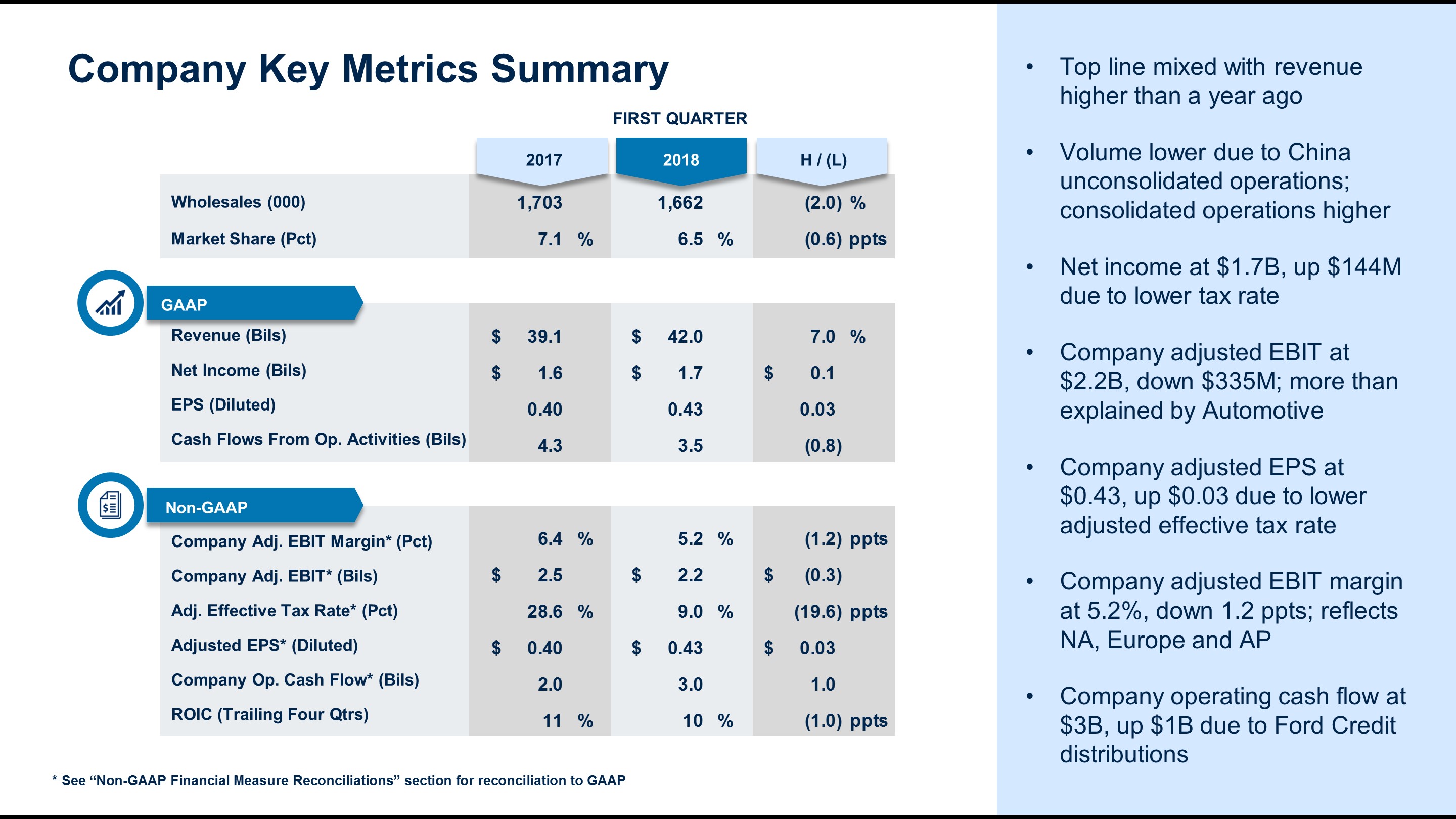
Company revenue in the first quarter of 2018 was $42 billion, up 7% from a year ago, driven by higher volume from consolidated operations, favorable exchange-related effects, and higher net pricing. Revenue was up across all parts of the business except Middle East and Africa, with Europe delivering the greatest increase due to exchange and higher pricing on new products and to recover Brexit-related effects, with incentives holding flat year over year.
Wholesale volumes, at 1.7 million units, were down 2% compared with first quarter 2017, driven by lower volume at our unconsolidated China joint ventures. Volumes at consolidated operations were up about 3%.
Industry SAARs were up globally and in each region, with the largest growth coming from Asia Pacific, mainly China. Ford's global market share was 6.5%, down 60 basis points year over year with declines in each region. This reflects mainly lower market share in China, the United States, and the United Kingdom.
Net income in the first quarter of 2018 was $1.7 billion or $0.43 diluted earnings per share of Common and Class B Stock, an increase of $144 million or $0.03 per share from a year ago. The increase was more than explained by a lower effective tax rate.
Company adjusted EBIT for the first quarter of 2018 was $2.2 billion, down $335 million year over year. This was driven by Automotive, which delivered an EBIT of $1.7 billion, down $443 million. Adjusted EPS in the quarter was $0.43, up $0.03 from a year ago, driven by a lower adjusted effective tax rate.
Company adjusted EBIT margin was 5.2% in the first quarter of 2018, down 1.2 percentage points from a year ago, reflecting Asia Pacific, North America, and Europe performance.
Company operating cash flow in the quarter was $3 billion, up $1 billion from a year ago due to higher distributions from Ford Credit, and our balance sheet remained strong, with cash and marketable securities of $27.6 billion and ample liquidity of more than $38 billion.
32
Item 2. Management's Discussion and Analysis of Financial Condition and Results of Operations (Continued)
The chart below shows our first quarter 2018 net income attributable to Ford and Company adjusted EBIT by segment.
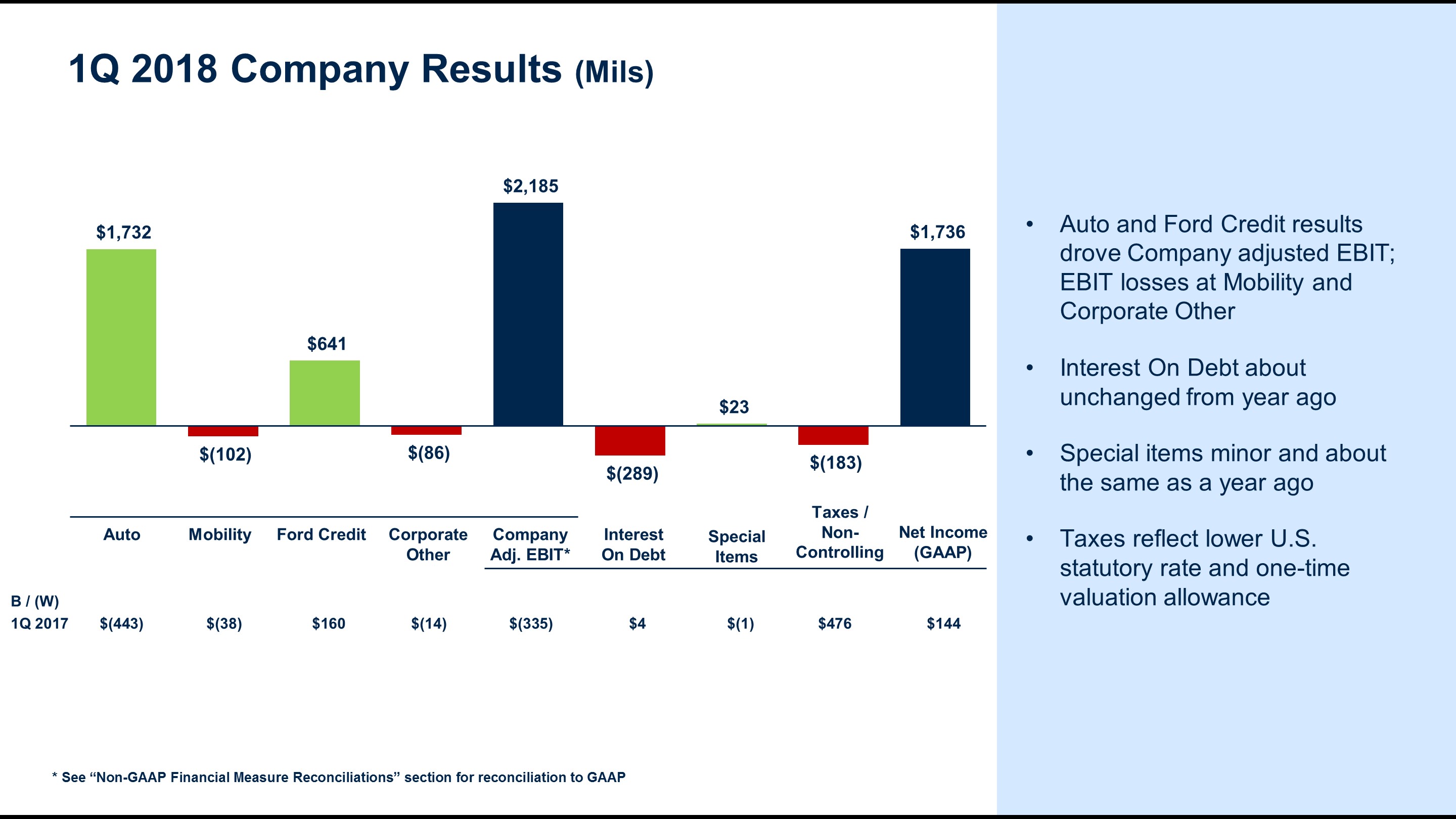
Our Automotive segment's EBIT in the first quarter of 2018 was $1.7 billion. The lower year-over-year EBIT was caused by commodity cost increases of about $480 million, along with adverse exchange effects of about $240 million. These impacts were offset partially by higher net pricing, particularly in Europe, and higher volume from favorable stock changes in North America. The North America stock changes reflect pipeline fill for the newly launched EcoSport and a stock build for Focus. Importantly, total cost excluding commodities was about flat compared to a year ago.
The increase in commodity cost was largely metals, driven, in part, by the market's reaction to potential increases in U.S. tariffs. Nearly one-half of our full year exposure to commodity price changes was locked in as of the end of the first quarter of 2018 due to fixed contracts or hedges in place.
In our Mobility segment, we incurred a loss of $102 million driven by autonomous vehicle development costs. These results benefited from a one-time gain on investments in Smart Mobility of about $58 million. The quarterly loss was $38 million worse than a year ago, more than explained by increased investment in autonomy.
Our Ford Credit segment turned in a strong quarter, earning $641 million, $160 million higher than a year ago. The improvement was broad-based, including growth in receivables globally. In the quarter, Ford Credit's portfolio remained robust with healthy U.S. consumer credit metrics, including an improved loss-to-receivables ratio. Auction values improved versus a year ago by about 1% at constant mix, and we now expect full year average auction values to decline just 1% to 2%. At March 31, 2018, Ford Credit's managed leverage was 8.4 to 1, in line with our target of 8:1 to 9:1.
For the foreseeable future, Ford Credit plans to maintain its managed receivables at about the same level as at the end of first quarter 2018. Our focus is to maintain a strong risk profile for Ford and Ford Credit, balancing receivables, funding requirements, liquidity, profitability, and distributions. This will allow us to continue supporting auto sales while preserving capacity for future mobility initiatives. It will also enable relatively consistent distributions to Ford approximately equal to Ford Credit's annual net income.
33
Item 2. Management's Discussion and Analysis of Financial Condition and Results of Operations (Continued)
Automotive Segment
The chart below shows our first quarter 2018 Automotive segment EBIT by region.
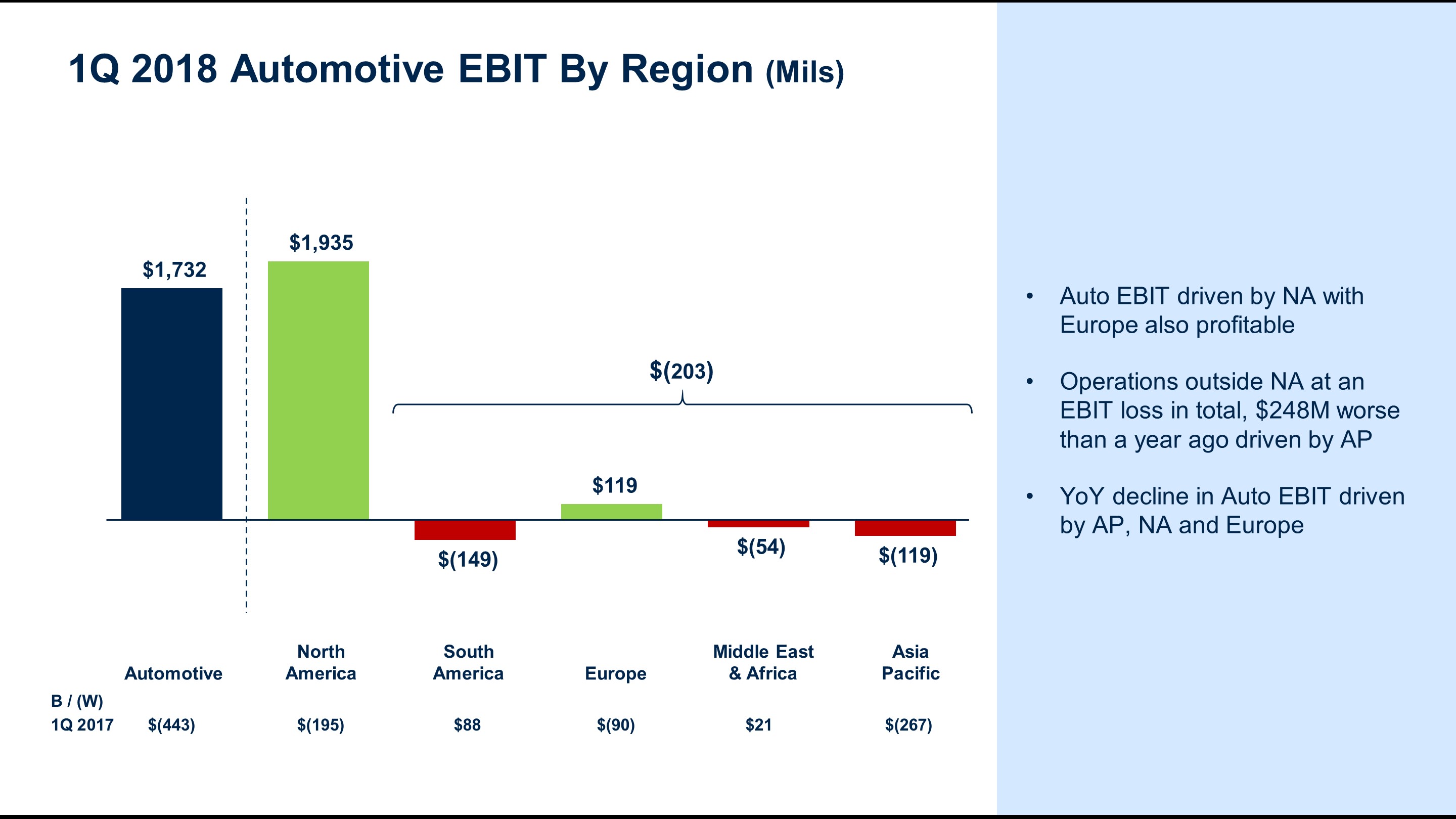
In our Automotive segment, North America was the largest EBIT contributor earning $1.9 billion, down $195 million from a year ago, with an EBIT margin of 7.8%, down 1.1 percentage points. The year-over-year declines were more than explained by higher commodity cost. Market factors (volume, mix, and net pricing) were positive, and total cost was flat excluding commodities.
Outside North America in the Automotive segment, results were a combined loss of $203 million, with each region incurring a loss except Europe. The combined loss was $248 million worse than a year ago more than explained by Asia Pacific. Asia Pacific's loss of $119 million was driven by a loss in Ford China. While we earned China equity income of $138 million, this was more than offset by engineering costs incurred by Ford for future products, including for newly localized entries, including Lincoln, as well as a loss for Lincoln as we continue to establish and grow the brand and the network. The China loss was offset partially by a profit in the rest of Asia Pacific. This includes a substantial improvement in India, although it still incurred a small loss. We also benefited in the quarter from record first quarter sales in the Asia Pacific markets outside of China.
In Europe, we earned an EBIT of $119 million, $90 million lower than a year ago. We delivered strong net pricing increases in the quarter. This was more than offset, however, by lower volume and unfavorable mix, adverse exchange due to sterling, and higher commodity cost. The adverse volume and mix were due mainly to a weaker industry and lower Ford market share in the United Kingdom as well as lower demand for diesel passenger vehicle derivatives in the region.
34
Item 2. Management's Discussion and Analysis of Financial Condition and Results of Operations (Continued)
In general, we measure year-over-year change in Automotive segment EBIT using the causal factors listed below, with net pricing and cost variances calculated at present-year volume and mix and exchange:
• | Market Factors : |
◦ | Volume and Mix – primarily measures EBIT variance from changes in wholesale volumes (at prior-year average contribution margin per unit) driven by changes in industry volume, market share, and dealer stocks, as well as the profit variance resulting from changes in product mix, including mix among vehicle lines and mix of trim levels and options within a vehicle line |
◦ | Net Pricing – primarily measures EBIT variance driven by changes in wholesale prices to dealers and marketing incentive programs such as rebate programs, low-rate financing offers, special lease offers, and stock adjustments on dealer inventory |
• | Cost: |
◦ | Contribution Costs – primarily measures EBIT variance driven by per-unit changes in cost categories that typically vary with volume, such as material costs (including commodity and component costs), warranty expense, and freight and duty costs |
◦ | Structural Costs – primarily measures EBIT variance driven by absolute change in cost categories that typically do not have a directly proportionate relationship to production volume. Structural costs include the following cost categories: |
▪ | Manufacturing, Including Volume Related – consists primarily of costs for hourly and salaried manufacturing personnel, plant overhead (such as utilities and taxes), and new product launch expense. |
These costs could be affected by volume for operating pattern actions such as overtime, line-speed, and shift schedules
▪ | Engineering – consists primarily of costs for engineering personnel, prototype materials, testing, and outside engineering services |
▪ | Spending-Related – consists primarily of depreciation and amortization of our manufacturing and engineering assets, but also includes asset retirements and operating leases |
▪ | Advertising and Sales Promotions – includes costs for advertising, marketing programs, brand promotions, customer mailings and promotional events, and auto shows |
▪ | Administrative and Selling – includes primarily costs for salaried personnel and purchased services related to our staff activities and selling functions, as well as associated information technology costs |
▪ | Pension and OPEB – consists primarily of past service pension costs and other postretirement employee benefit costs |
• | Other – includes a variety of items, such as parts and services profits, royalties, government incentives, and compensation-related changes. Other also includes: |
◦ | Exchange – primarily measures EBIT variance driven by one or more of the following: (i) transactions denominated in currencies other than the functional currencies of the relevant entities, (ii) effects of converting functional currency income to U.S. dollars, (iii) effects of remeasuring monetary assets and liabilities of the relevant entities in currencies other than their functional currency, or (iv) results of our foreign currency hedging |
◦ | Beginning in 2018, in our discussion of Asia Pacific EBIT, Other includes the equity income from our China JVs. In prior periods, the impact of our equity income from our China JVs was spread across each causal factor |
35
Item 2. Management's Discussion and Analysis of Financial Condition and Results of Operations (Continued)
In addition, definitions and calculations used in this report include:
• | Wholesales and Revenue – wholesale unit volumes include all Ford and Lincoln badged units (whether produced by Ford or by an unconsolidated affiliate) that are sold to dealerships, units manufactured by Ford that are sold to other manufacturers, units distributed by Ford for other manufacturers, and local brand units produced by our China joint venture, Jiangling Motors Corporation, Ltd. ("JMC"), that are sold to dealerships. Vehicles sold to daily rental car companies that are subject to a guaranteed repurchase option (i.e., rental repurchase), as well as other sales of finished vehicles for which the recognition of revenue is deferred (e.g., consignments), also are included in wholesale unit volumes. Revenue from certain vehicles in wholesale unit volumes (specifically, Ford badged vehicles produced and distributed by our unconsolidated affiliates, as well as JMC brand vehicles) are not included in our revenue |
• | Automotive Segment EBIT Margin – defined as Automotive segment EBIT divided by Automotive segment revenue |
• | Industry Volume and Market Share – based, in part, on estimated vehicle registrations; includes medium and heavy duty trucks |
• | SAAR – seasonally adjusted annual rate |
References to Automotive records for EBIT margin and business units are since at least 2009.
36
Item 2. Management's Discussion and Analysis of Financial Condition and Results of Operations (Continued)
The charts on the following pages detail first quarter 2018 key metrics and the change in first quarter 2018 EBIT compared with first quarter 2017 by causal factor for our Automotive segment and its regions - North America, South America, Europe, Middle East & Africa, and Asia Pacific.
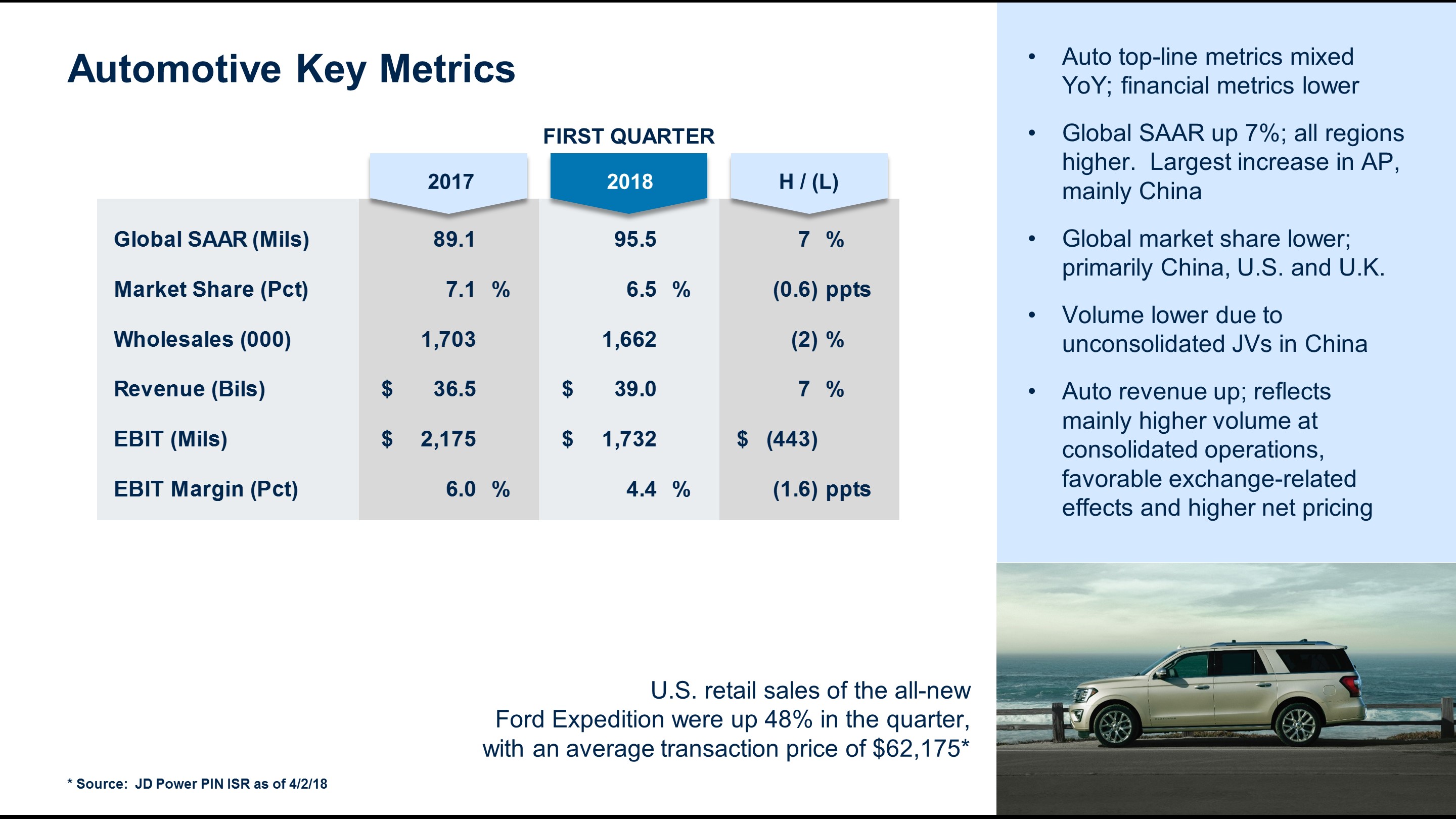
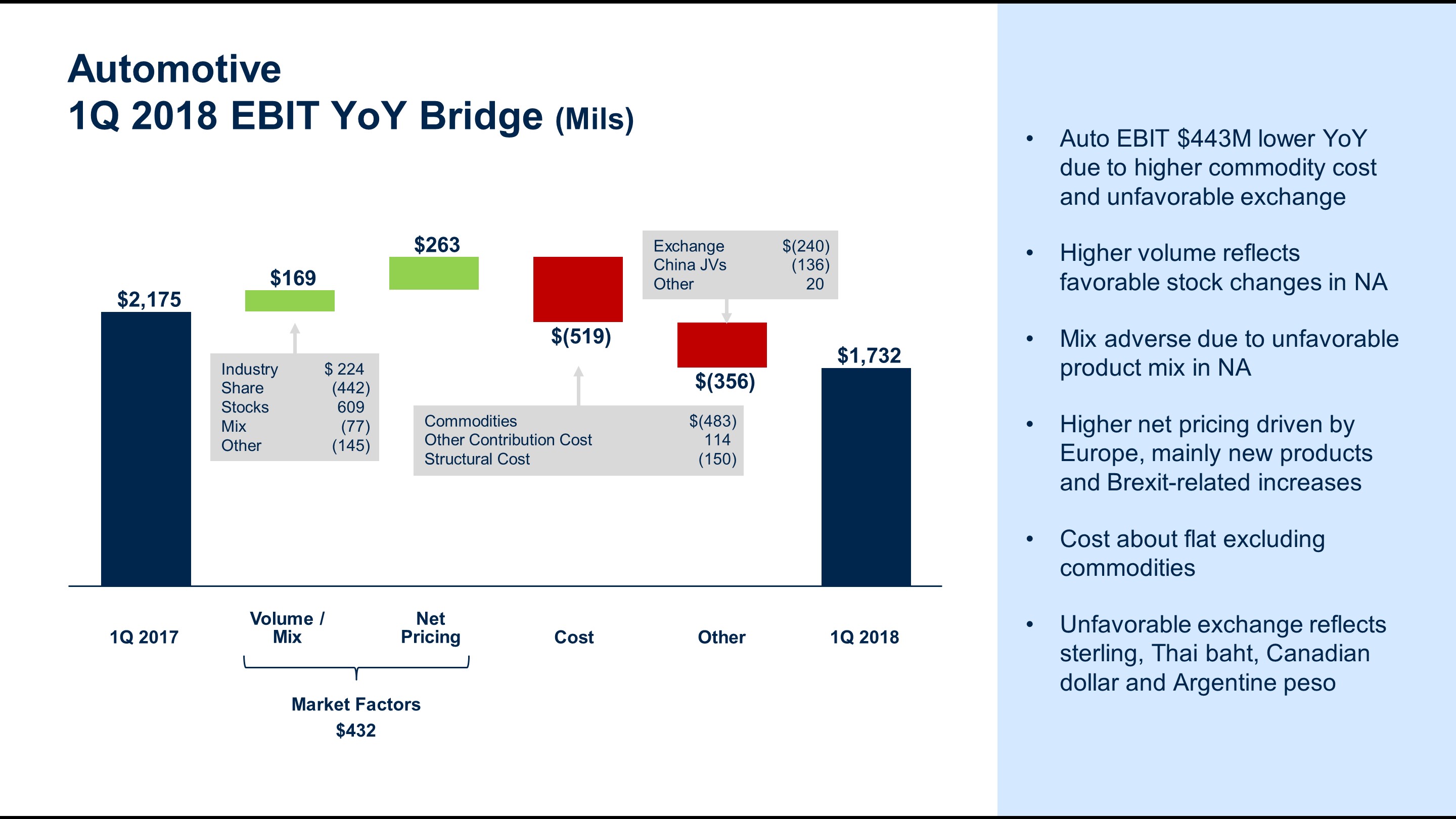
37
Item 2. Management's Discussion and Analysis of Financial Condition and Results of Operations (Continued)
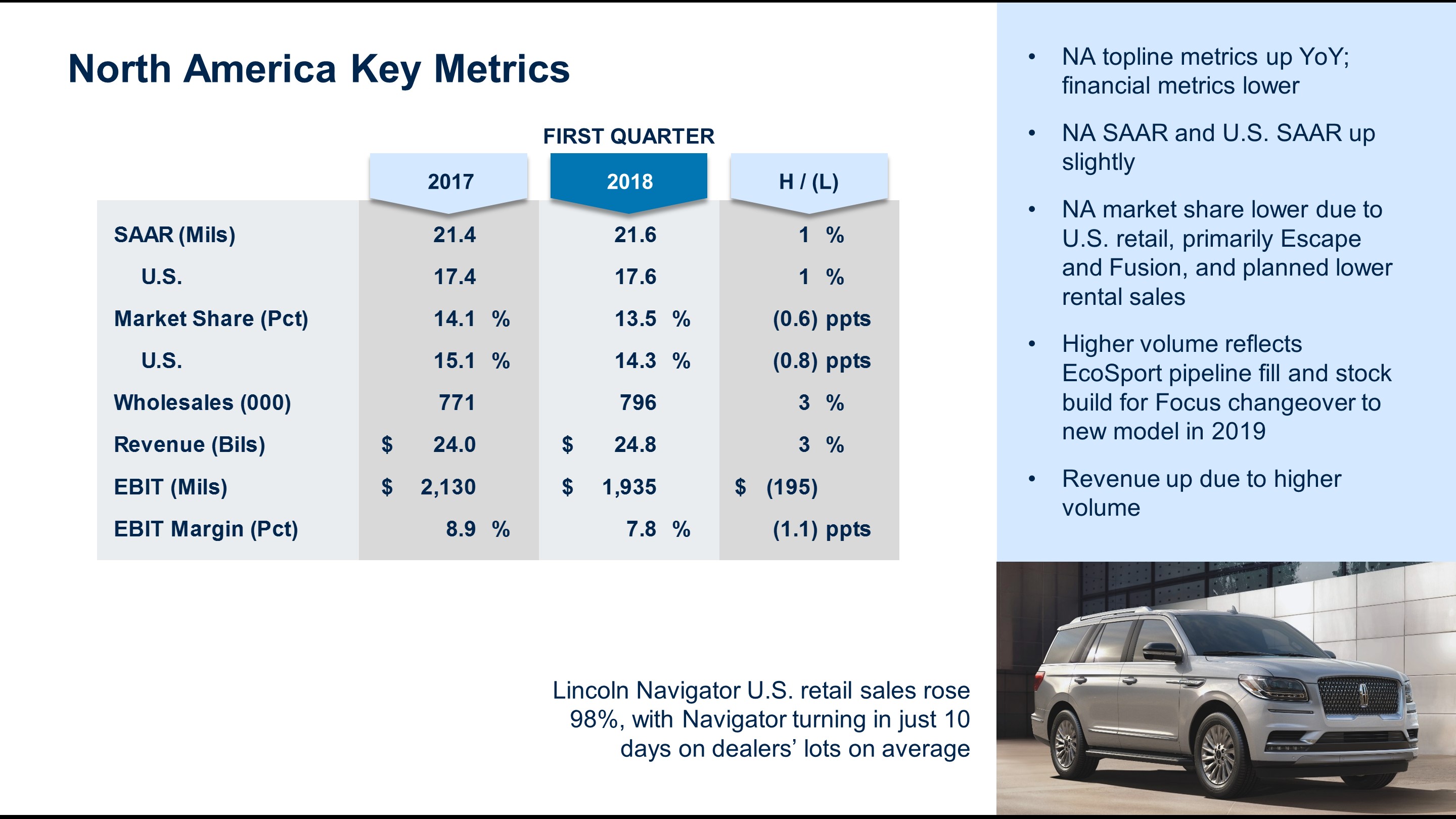
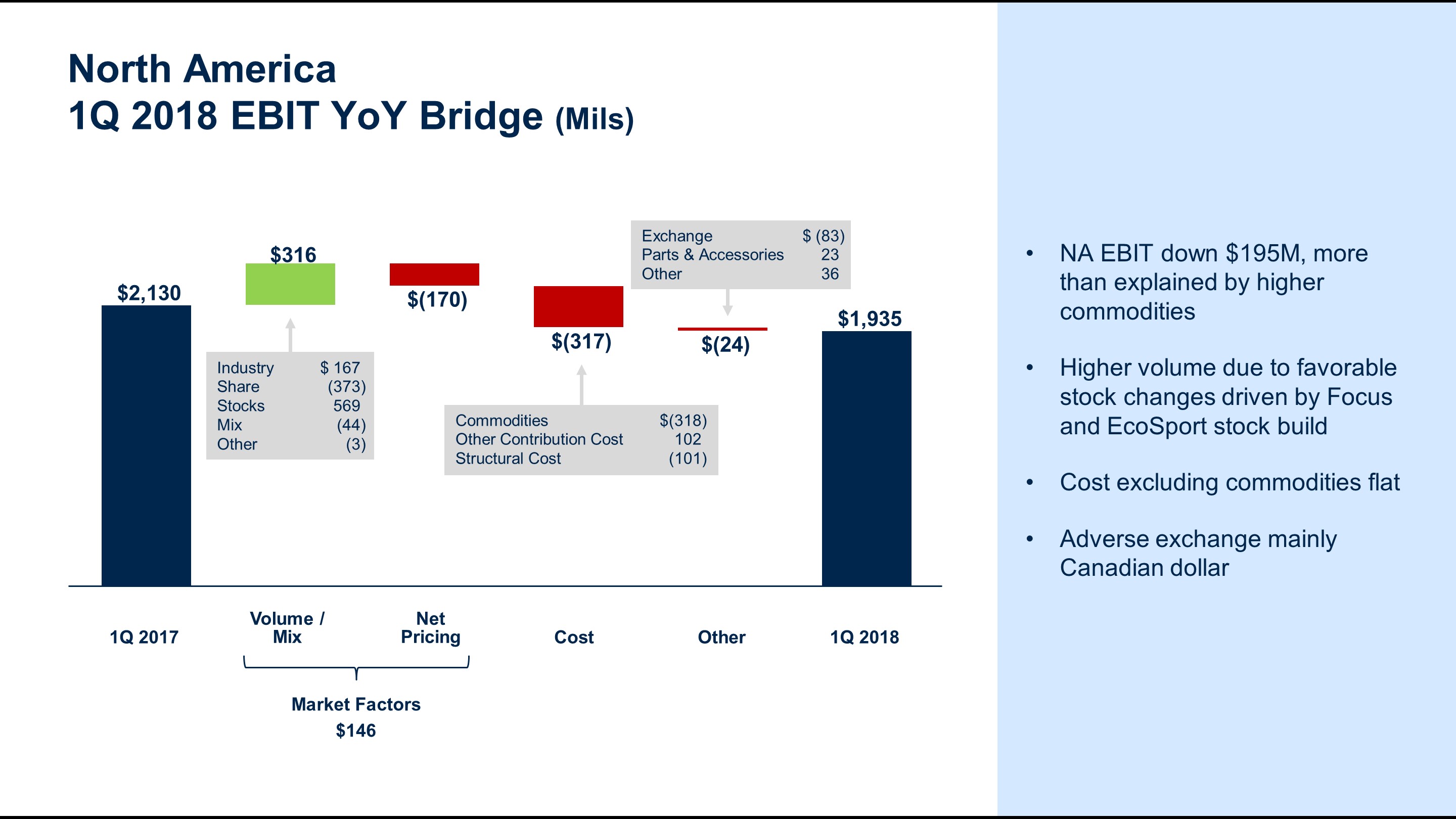
38
Item 2. Management's Discussion and Analysis of Financial Condition and Results of Operations (Continued)
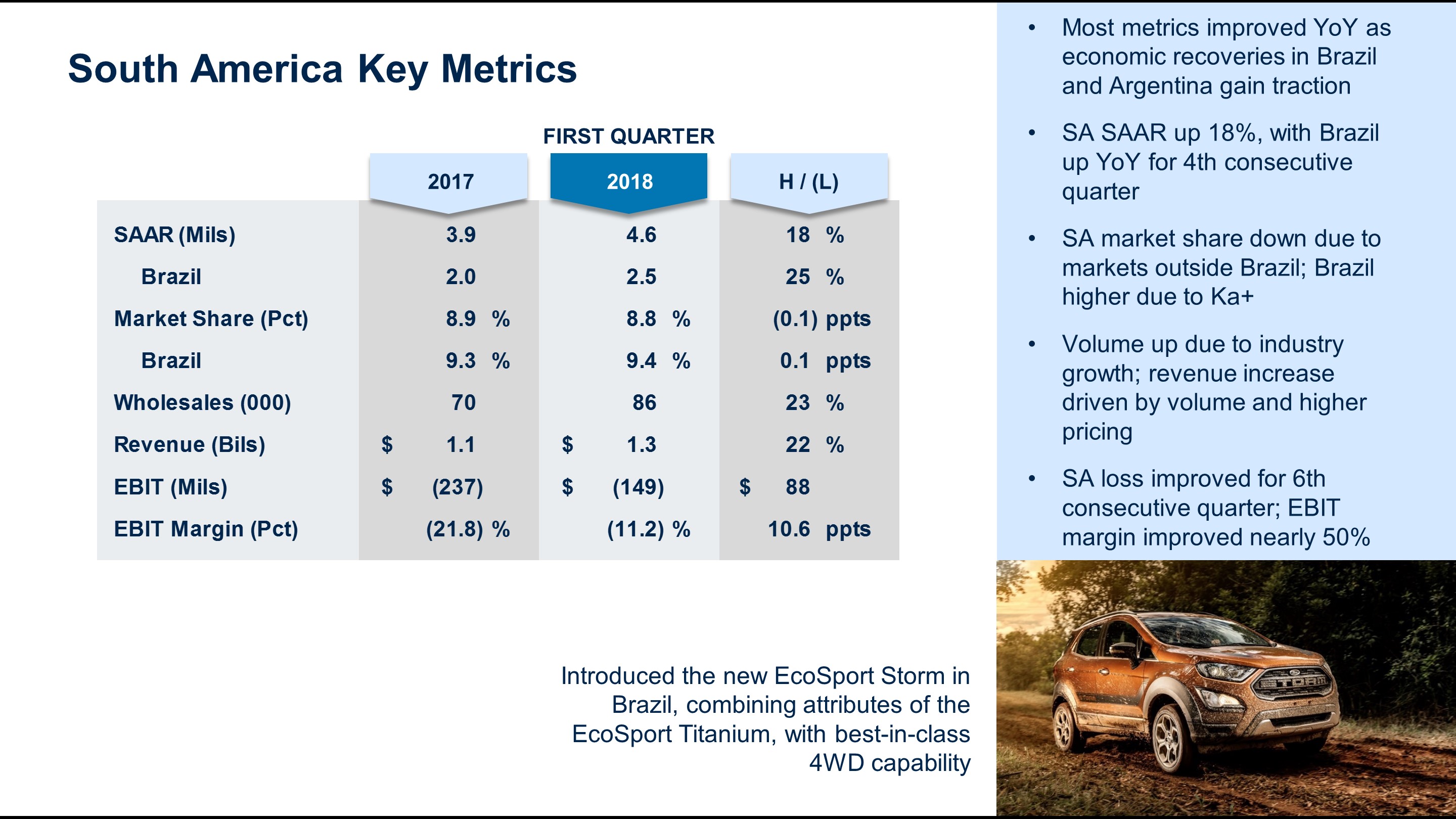
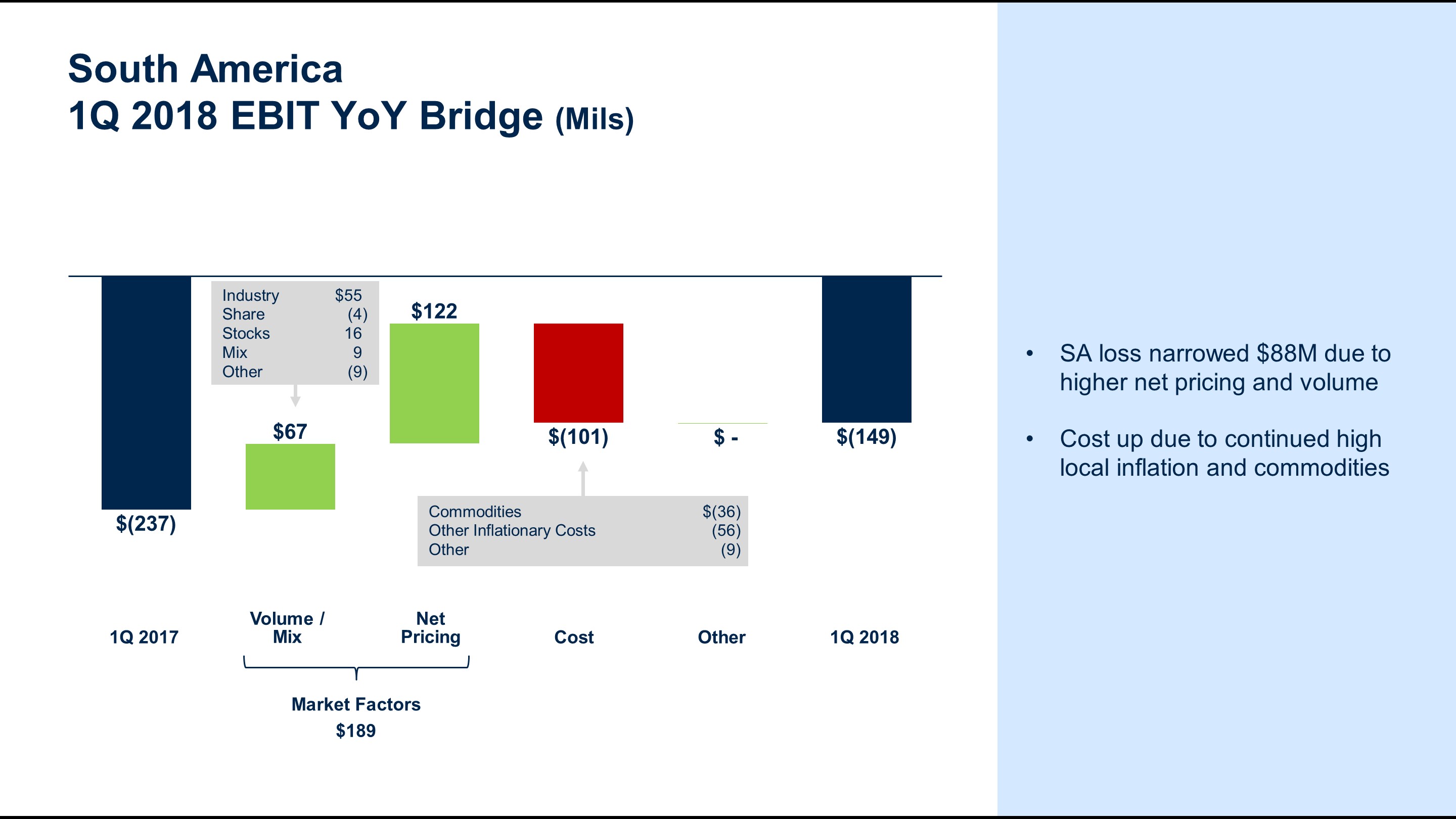
39
Item 2. Management's Discussion and Analysis of Financial Condition and Results of Operations (Continued)
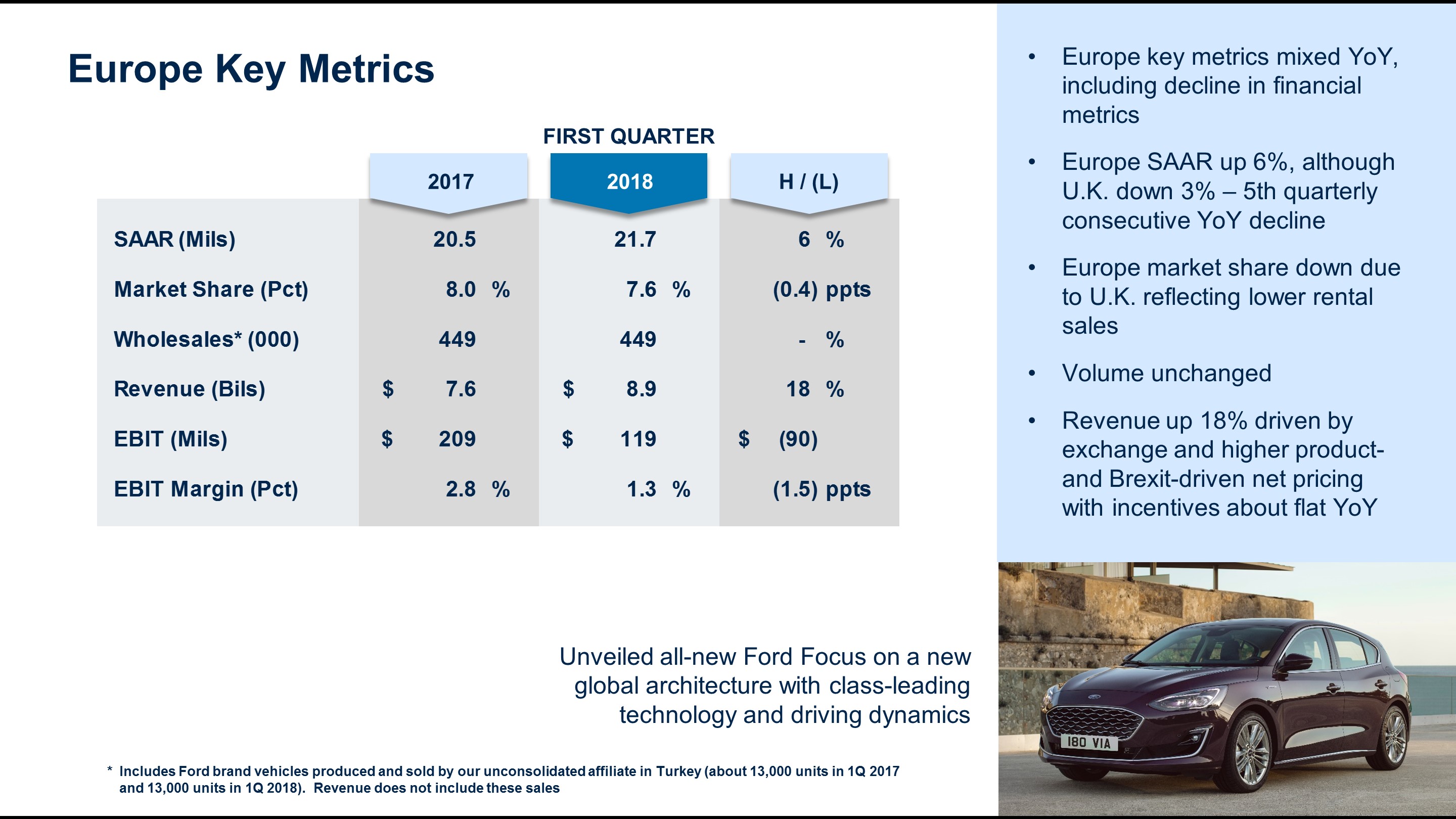
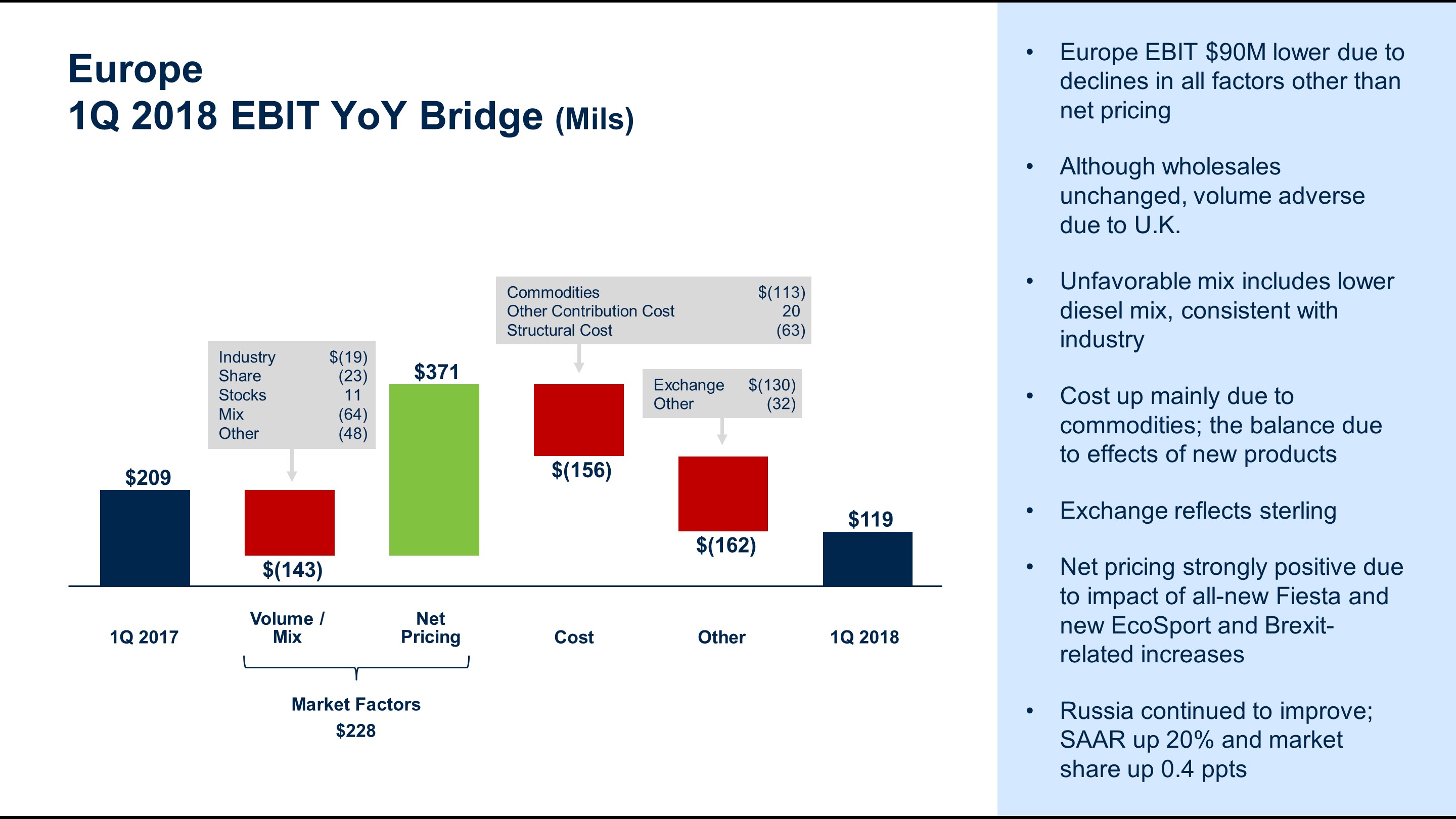
40
Item 2. Management's Discussion and Analysis of Financial Condition and Results of Operations (Continued)
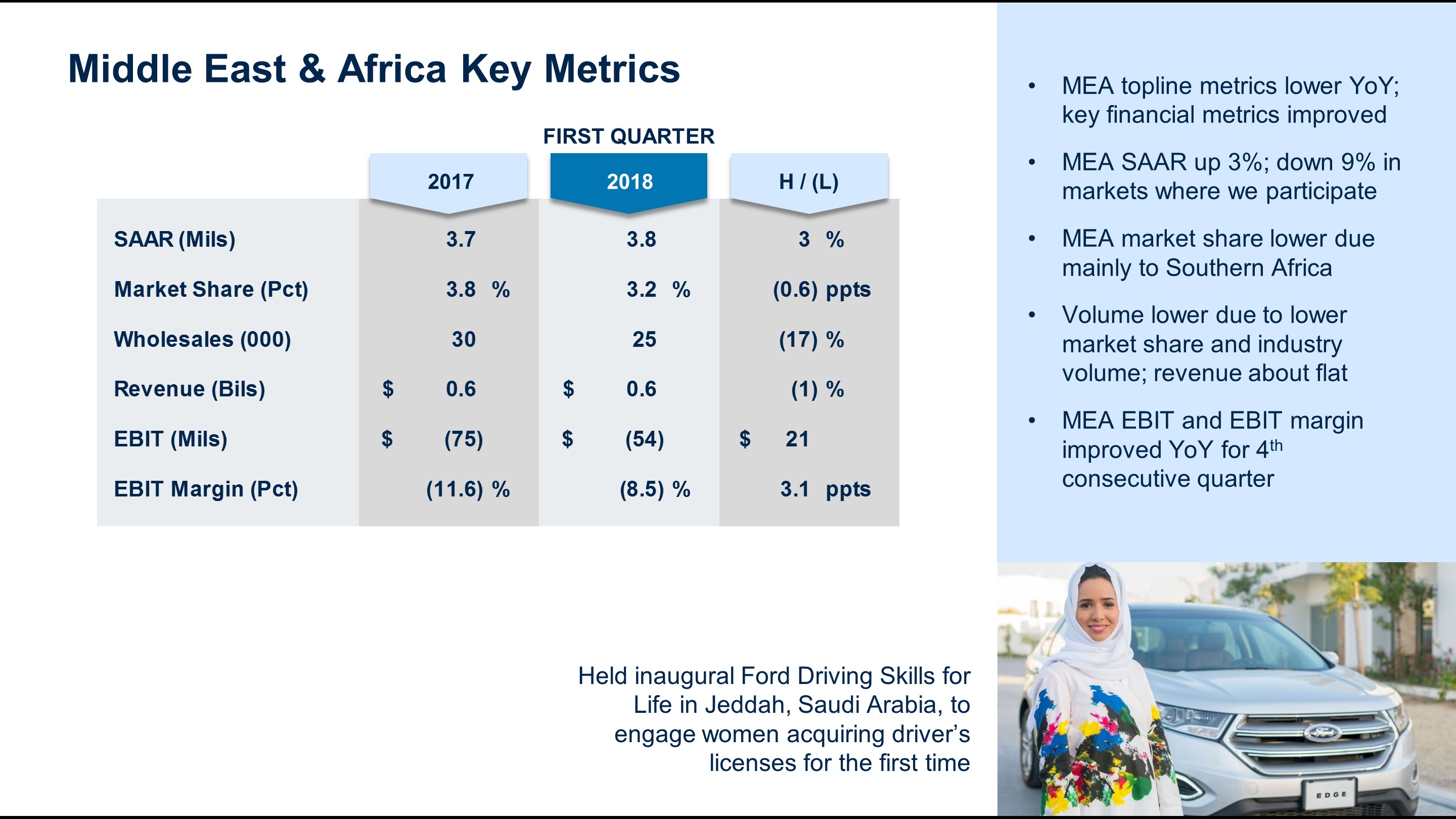
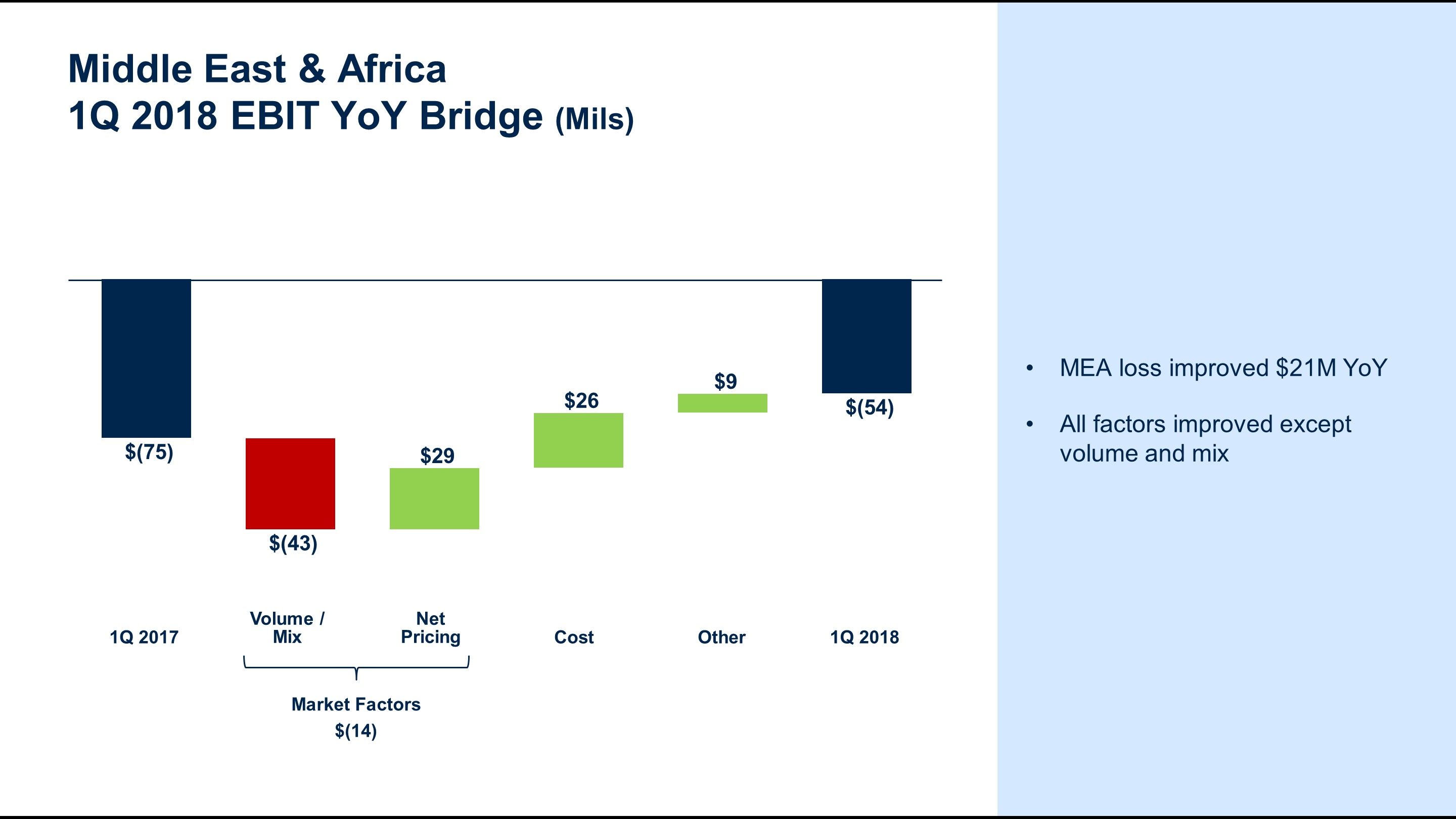
41
Item 2. Management's Discussion and Analysis of Financial Condition and Results of Operations (Continued)
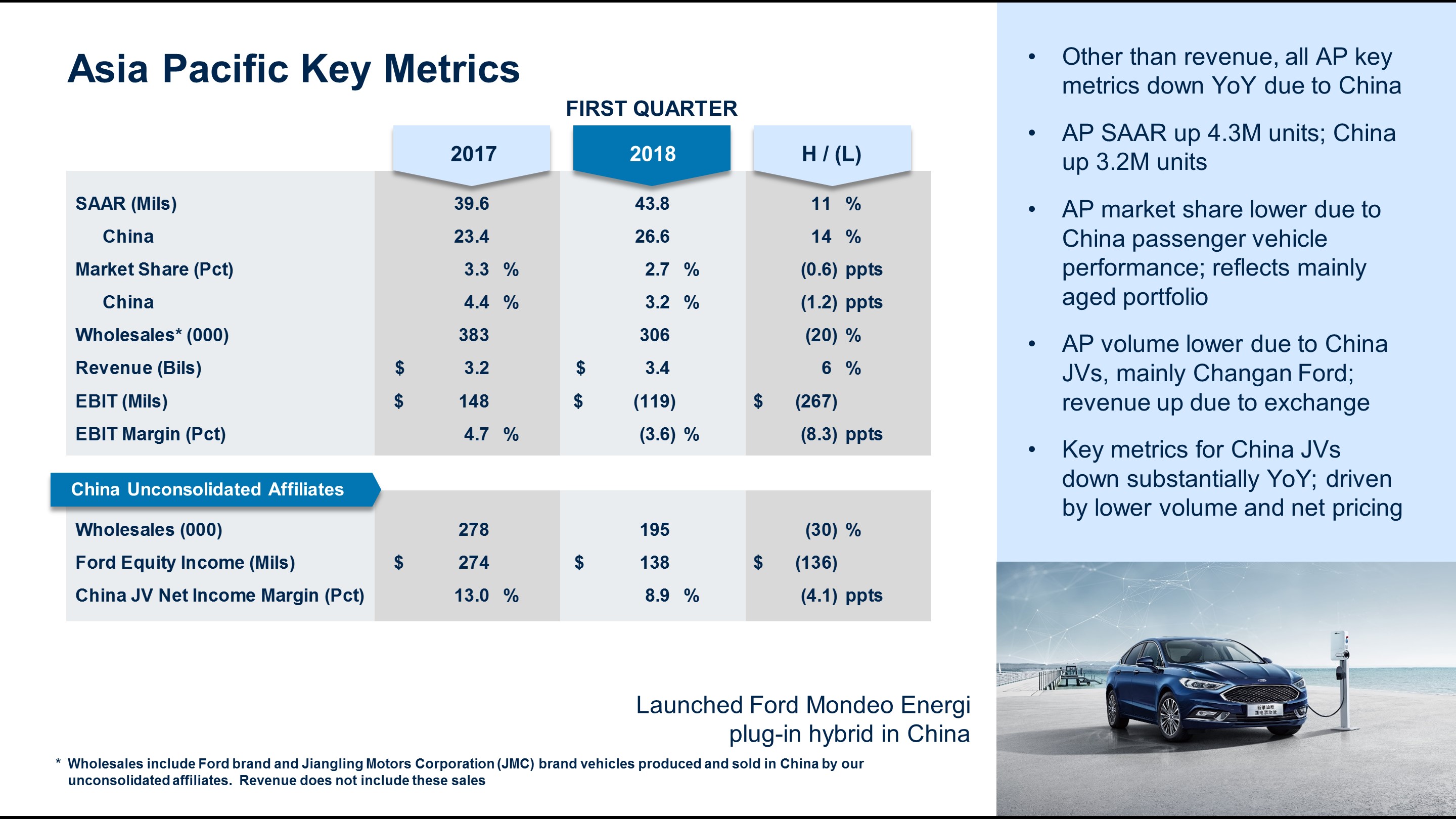
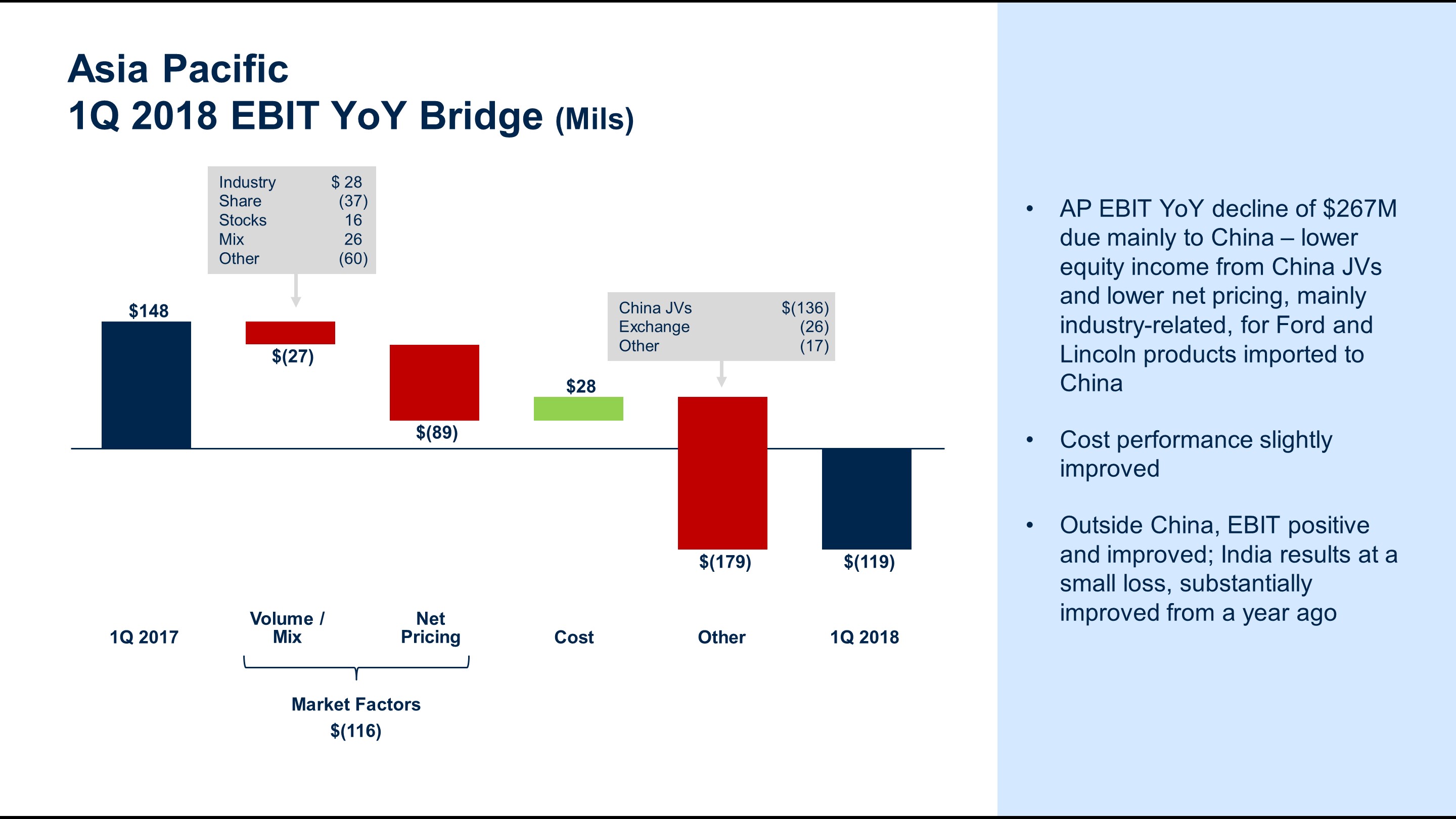
42
Item 2. Management's Discussion and Analysis of Financial Condition and Results of Operations (Continued)
Mobility Segment
Our Mobility segment primarily includes development costs related to our autonomous vehicles and our investment in mobility through Ford Smart Mobility LLC ("FSM"). FSM designs and builds mobility services on its own, and collaborates with start-ups and tech companies.
The chart below shows the Mobility segment's first quarter 2018 EBIT compared with first quarter 2017.
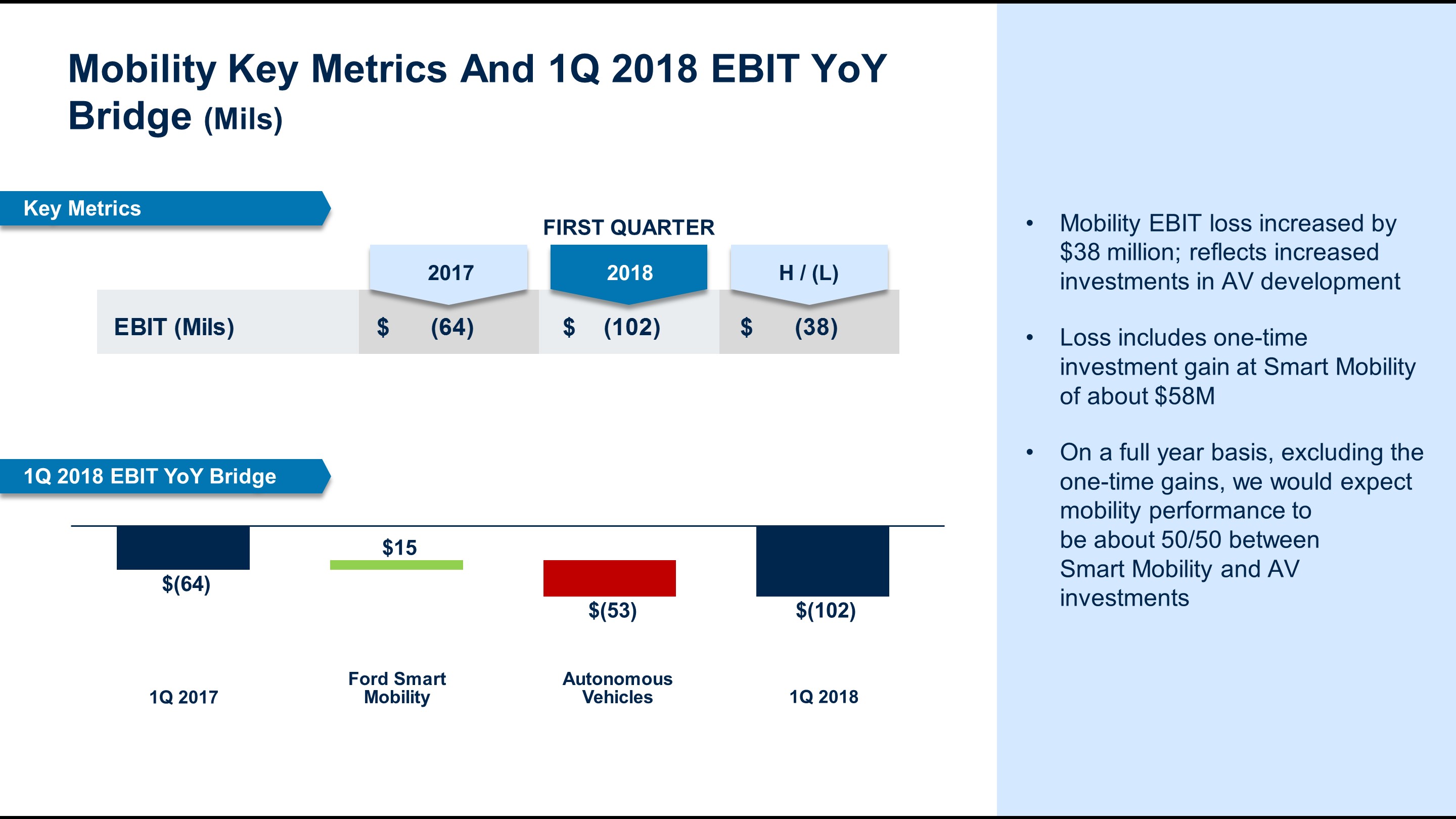
43
Item 2. Management's Discussion and Analysis of Financial Condition and Results of Operations (Continued)
Ford Credit Segment
In general, we measure year-over-year changes in Ford Credit's EBT using the causal factors listed below:
• | Volume and Mix: |
◦ | Volume primarily measures changes in net financing margin driven by changes in average managed receivables at prior period financing margin yield (defined below in financing margin) at prior period exchange rates. Volume changes are primarily driven by the volume of new and used vehicle sales and leases, the extent to which Ford Credit purchases retail installment sale and lease contracts, the extent to which Ford Credit provides wholesale financing, the sales price of the vehicles financed, the level of dealer inventories, Ford-sponsored special financing programs available exclusively through Ford Credit, and the availability of cost-effective funding for the purchase of retail installment sale and lease contracts and to provide wholesale financing |
◦ | Mix primarily measures changes in net financing margin driven by period over period changes in the composition of Ford Credit's average managed receivables by product and by country or region |
• Financing Margin:
◦ | Financing margin variance is the period-to-period change in financing margin yield multiplied by the present period average managed receivables at prior period exchange rates. This calculation is performed at the product and country level and then aggregated. Financing margin yield equals revenue, less interest expense and scheduled depreciation for the period, divided by average managed receivables for the same period |
◦ | Financing margin changes are driven by changes in revenue and interest expense. Changes in revenue are primarily driven by the level of market interest rates, cost assumptions in pricing, mix of business, and competitive environment. Changes in interest expense are primarily driven by the level of market interest rates, borrowing spreads, and asset-liability management |
• | Credit Loss: |
◦ | Credit loss is the change in the provision for credit losses at prior period exchange rates. For analysis purposes, management splits the provision for credit losses into net charge-offs and the change in the allowance for credit losses |
◦ | Net charge-off changes are primarily driven by the number of repossessions, severity per repossession, and recoveries. Changes in the allowance for credit losses are primarily driven by changes in historical trends in credit losses and recoveries, changes in the composition and size of Ford Credit's present portfolio, changes in trends in historical used vehicle values, and changes in economic conditions. For additional information, refer to the "Critical Accounting Estimates - Allowance for Credit Losses" section of Item 7 of Part II of our 2017 Form 10-K Report |
• | Lease Residual: |
◦ | Lease residual measures changes to residual performance at prior period exchange rates. For analysis purposes, management splits residual performance primarily into residual gains and losses, and the change in accumulated supplemental depreciation |
◦ | Residual gain and loss changes are primarily driven by the number of vehicles returned to Ford Credit and sold, and the difference between the auction value and the depreciated value (which includes both base and accumulated supplemental depreciation) of the vehicles sold. Changes in accumulated supplemental depreciation are primarily driven by changes in Ford Credit's estimate of the expected auction value at the end of the lease term, and changes in the estimate of the number of vehicles that will be returned to it and sold. For additional information, refer to the "Critical Accounting Estimates - Accumulated Depreciation on Vehicles Subject to Operating Leases" section of Item 7 of Part II of our 2017 Form 10-K Report |
• | Exchange: |
◦ | Reflects changes in EBT driven by the effects of converting functional currency income to U.S. dollars |
• | Other: |
◦ | Primarily includes operating expenses, other revenue, and insurance expenses at prior period exchange rates |
◦ | Changes in operating expenses are primarily driven by salaried personnel costs, facilities costs, and costs associated with the origination and servicing of customer contracts |
◦ | In general, other revenue changes are primarily driven by changes in earnings related to market valuation adjustments to derivatives (primarily related to movements in interest rates) and other miscellaneous items |
44
Item 2. Management's Discussion and Analysis of Financial Condition and Results of Operations (Continued)
In addition, the following definitions and calculations apply to Ford Credit when used in this report:
• | Cash (as shown on the Funding Structure, Liquidity Sources, and Leverage charts) – Cash, cash equivalents, and marketable securities, excluding amounts related to insurance activities |
• | Earnings Before Taxes (EBT ) – Reflects Ford Credit's income before income taxes |
• | Return on Equity (ROE ) (as shown on the Key Metrics chart) – Reflects return on equity calculated by annualizing net income for the period and dividing by average equity for the period |
• | Securitizations (as shown on the Public Term Funding Plan chart) – Public securitizations, Rule 144A offerings sponsored by Ford Motor Credit, and widely distributed offerings by Ford Credit Canada |
• | Term Asset-Backed Securities (as shown on the Funding Structure chart) – Obligations issued in securitization transactions that are payable only out of collections on the underlying securitized assets and related enhancements |
• | Total Debt (as shown on the Leverage chart) – Debt on Ford Credit's balance sheet. Includes debt issued in securitizations and payable only out of collections on the underlying securitized assets and related enhancements. Ford Credit holds the right to receive the excess cash flows not needed to pay the debt issued by, and other obligations of, the securitization entities that are parties to those securitization transactions |
• | Total Net Receivables (as shown on the Total Net Receivables Reconciliation to Managed Receivables chart) – Includes finance receivables (retail and wholesale) sold for legal purposes and net investment in operating leases included in securitization transactions that do not satisfy the requirements for accounting sale treatment. These receivables and operating leases are reported on Ford Credit's balance sheet and are available only for payment of the debt issued by, and other obligations of, the securitization entities that are parties to those securitization transactions; they are not available to pay the other obligations of Ford Credit or the claims of Ford Credit's other creditors |
45
Item 2. Management's Discussion and Analysis of Financial Condition and Results of Operations (Continued)
The charts below detail first quarter 2018 key metrics and the change in first quarter 2018 EBT compared with first quarter 2017 by causal factor for the Ford Credit segment.
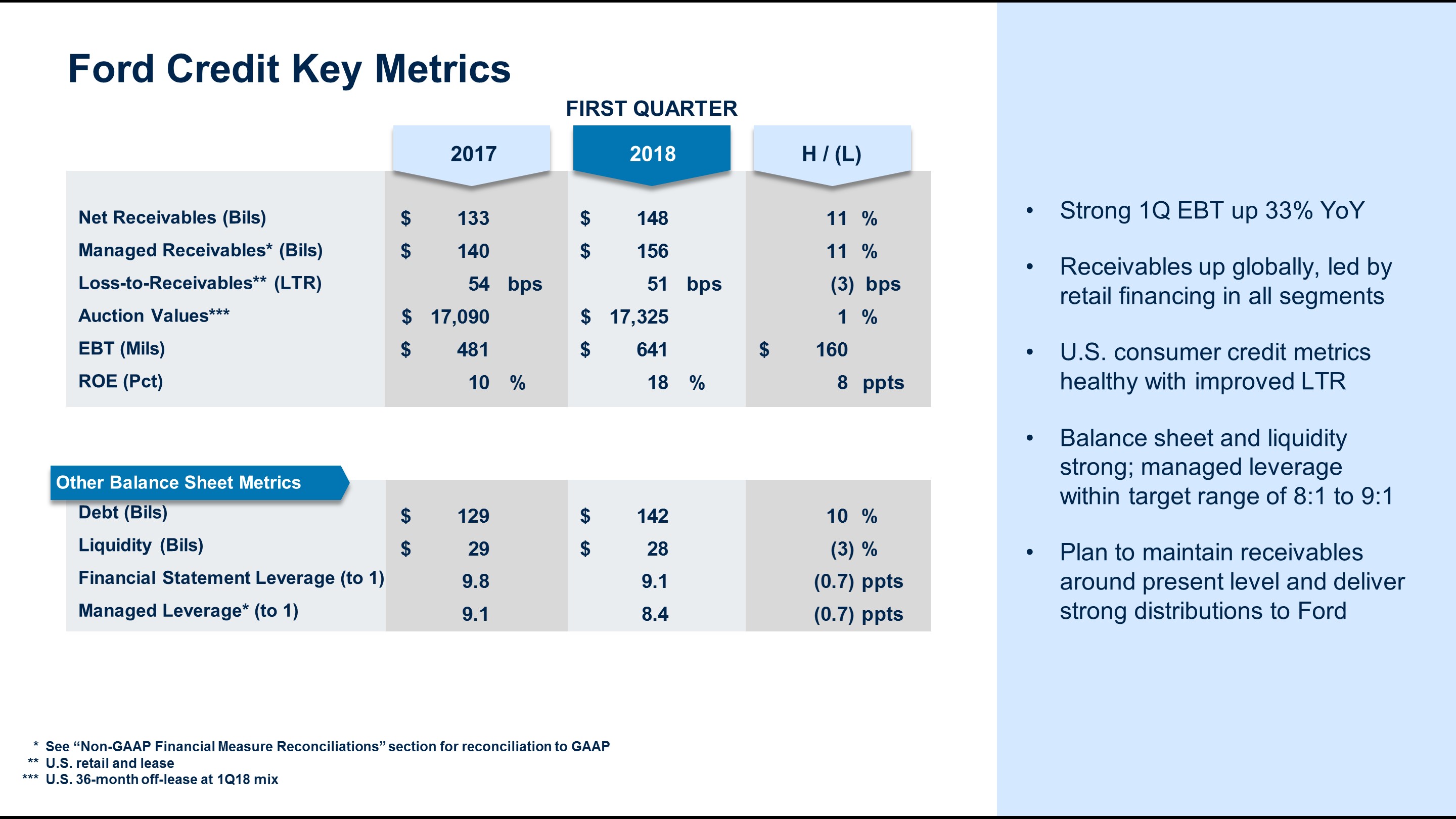
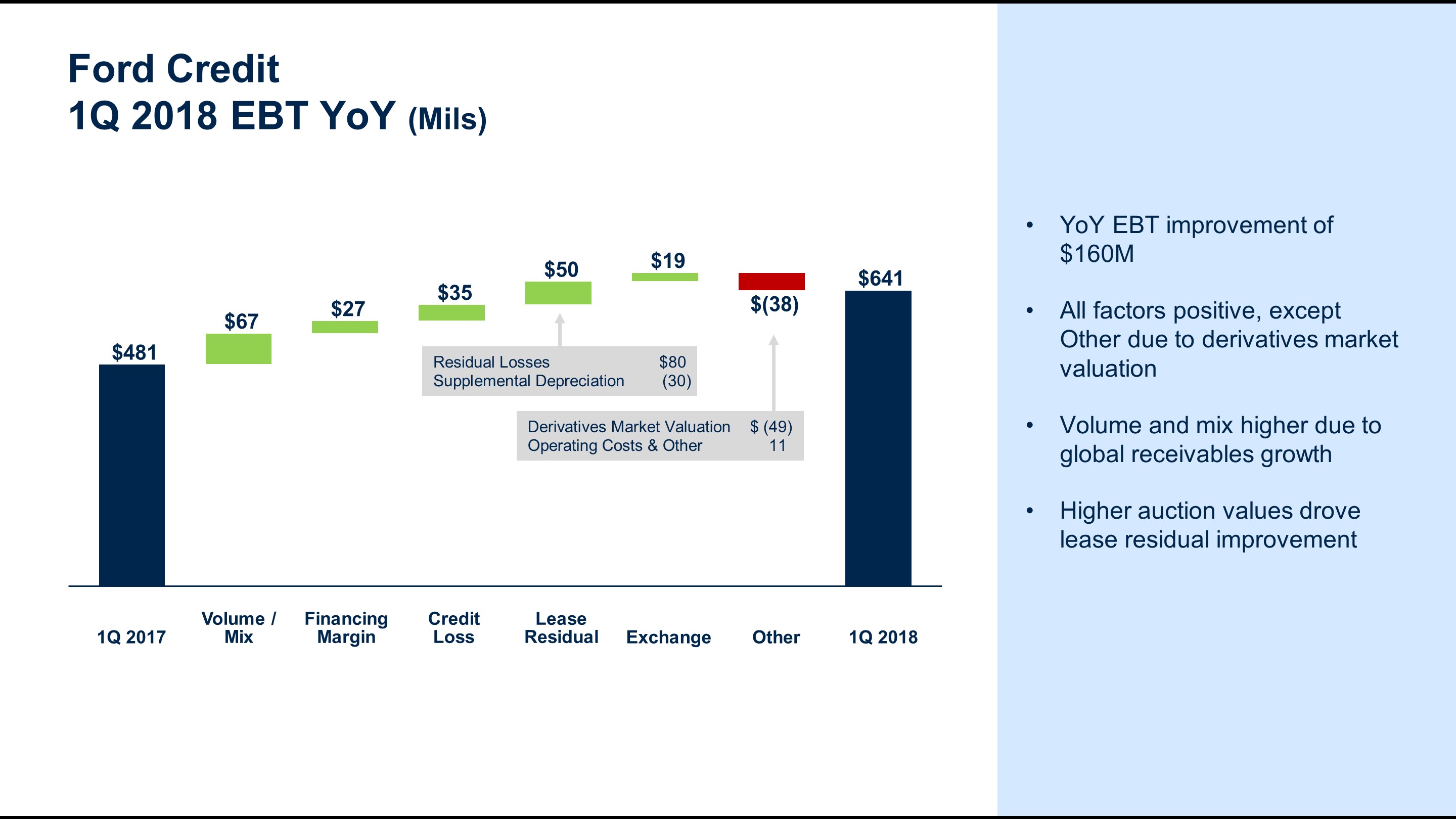
46
Item 2. Management's Discussion and Analysis of Financial Condition and Results of Operations (Continued)
Corporate Other
Corporate Other primarily includes corporate governance costs, interest income (excluding interest earned on our extended service contract portfolio that is included in our Automotive segment) and portfolio gains and losses from our cash, cash equivalents and marketable securities, and foreign exchange derivatives gains and losses associated with intercompany lending. Corporate governance costs are primarily administrative expenses supporting oversight or stewardship on behalf of the global enterprise and not allocated to specific business units or segments. This includes setting and directing global policy, establishment of global systems and processes, and promotion of the Company as a whole. Our first quarter 2018 Corporate Other results were a loss of $86 million, a $14 million greater loss compared with a year ago. The non-recurrence of gains on cash equivalents and marketable securities more than explains the greater loss.
Interest on Debt
Interest on Debt consists of interest expense on Automotive and other debt. First quarter 2018 interest expense on Automotive and other debt was $289 million, $4 million lower than a year ago.
Special Items
In Note 18 of the Notes to the Financial Statements, special items are reflected as a separate reconciling item, as opposed to being allocated among the Automotive segment, Mobility segment, and Ford Credit segment. This reflects the fact that management excludes these items from its review of operating segment results for purposes of measuring segment profitability and allocating resources.
Our pre-tax and tax special items were as follows:
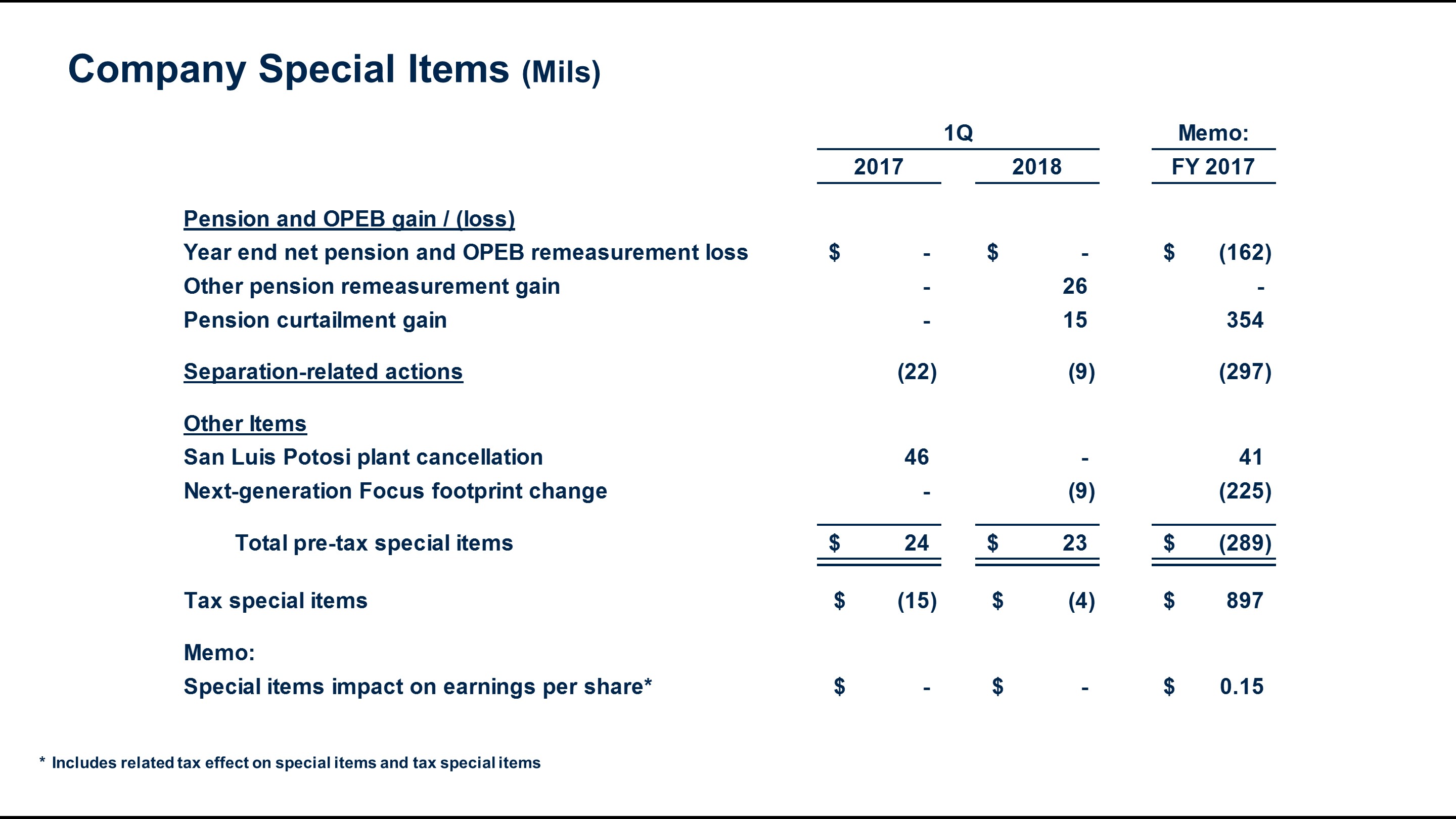
Taxes
Our tax provision in first quarter 2018 was $174 million, resulting in an effective tax rate of 9.1%. The effective tax rate includes a $235 million benefit for non-U.S. capital loss carryforwards expected to be realized in the foreseeable future. Our first quarter 2018 adjusted effective tax rate, which excludes special items, was 9.0%.
47
Item 2. Management's Discussion and Analysis of Financial Condition and Results of Operations (Continued)
LIQUIDITY AND CAPITAL RESOURCES
Company excluding Ford Credit
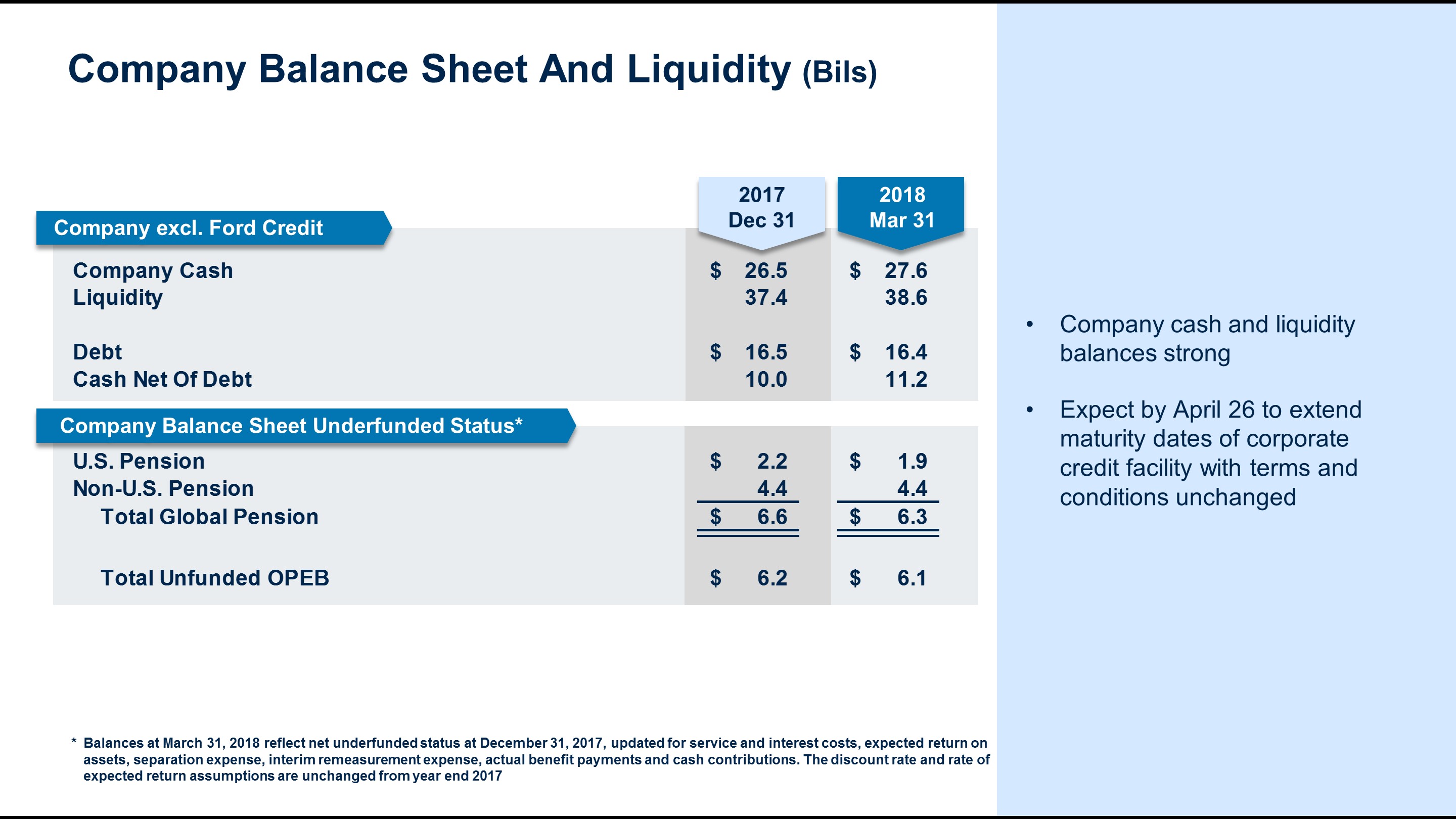
Liquidity . One of our key priorities is to maintain a strong balance sheet, while at the same time having resources available to invest in and grow our business. Based on our planning assumptions, we believe we have sufficient liquidity and capital resources to continue to invest in new products and services, pay our debts and obligations as and when they come due, pay a sustainable regular dividend at the current level, and provide protection within an uncertain global economic environment.
Our key balance sheet metrics include company cash, cash equivalents, marketable securities and restricted cash, excluding Ford Credit's cash, cash equivalents, and marketable securities (collectively "Company cash"), Company liquidity, which includes Company cash and total available committed credit lines, and cash net of debt.
At March 31, 2018 , we had $27.6 billion of Company cash, with 84% held by consolidated entities domiciled in the United States. We target to have an average ongoing Company cash balance of about $20 billion. We expect to have periods when we will be above or below this amount due to: (i) future cash flow expectations, such as for investments in future opportunities, capital investments, debt maturities, pension contributions, or restructuring requirements, (ii) short-term timing differences, and (iii) changes in the global economic environment.
48
Item 2. Management's Discussion and Analysis of Financial Condition and Results of Operations (Continued)
Our Company cash investments primarily include U.S. Department of Treasury obligations, federal agency securities, bank time deposits with investment-grade institutions, corporate investment-grade securities, commercial paper rated A-1/P-1 or higher, and debt obligations of a select group of non-U.S. governments, non-U.S. governmental agencies, and supranational institutions. The average maturity of these investments is approximately one year and adjusted based on market conditions and liquidity needs. We monitor our Company cash levels and average maturity on a daily basis.
In addition to our target Company cash balance, we also target to maintain a corporate credit facility, discussed below, for our Automotive business of about $10 billion to protect against exogenous shocks. We assess the appropriate long-term target for total Company liquidity, which includes Company cash and the Automotive portion of the corporate credit facility, to be about $30 billion, which is an amount we believe is sufficient to support our business priorities and to protect our business. At March 31, 2018 , we had $38.6 billion of Company liquidity. We may reduce our Company cash and liquidity targets over time, based on improved operating performance and changes in our risk profile.
Changes in Company Cash. Beginning in 2018, we are reporting Company operating cash flow, which includes Automotive, Mobility, Corporate Other, and Interest on Debt cash flows, as well as Ford Credit distributions. Prior to 2018, Ford Credit distributions were reported as a non-operating cash flow.
Changes in Company cash are summarized below:
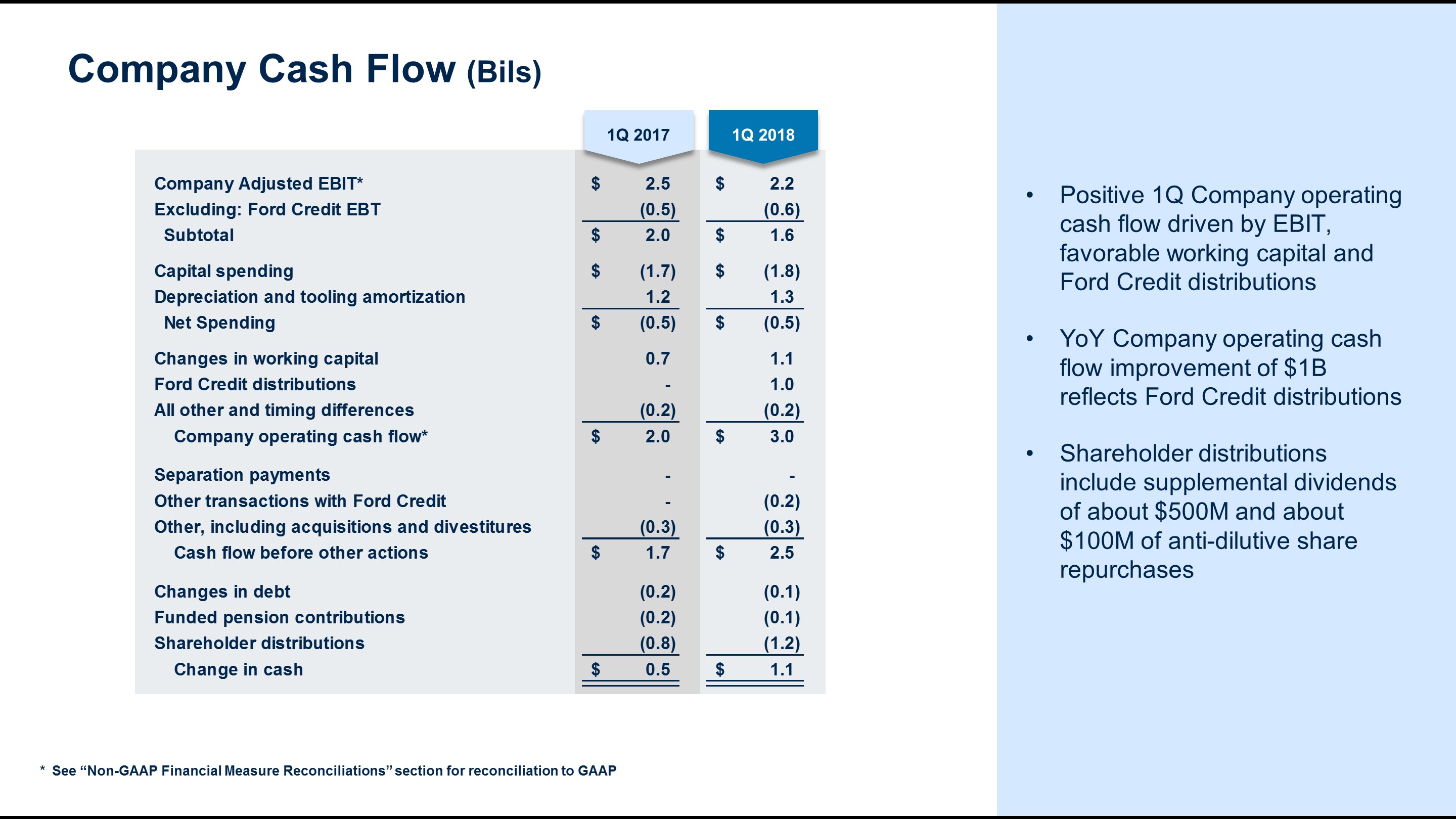
In managing our business, we classify changes in Company cash into operating and other items. Operating items include: Company adjusted EBIT excluding Ford Credit, capital spending, depreciation and tooling amortization, changes in working capital, Ford Credit distributions, and all other and timing differences. Non-operating items include: separation payments, other transactions with Ford Credit, acquisitions and divestitures, changes in Automotive debt, contributions to funded pension plans, and shareholder distributions.
First quarter 2018 Company operating cash flow was $3 billion positive, driven by Company adjusted EBIT excluding Ford Credit EBT, the seasonal impact of higher production payables on working capital, and Ford Credit distributions. Company operating cash flow improved $1 billion compared with first quarter 2017, reflecting Ford Credit distributions.
49
Item 2. Management's Discussion and Analysis of Financial Condition and Results of Operations (Continued)
Capital spending was $1.8 billion in the first quarter of 2018 . Our outlook for full year capital spending is expected to peak at about $7.5 billion in 2018 and decline to about $7 billion annually starting in 2020.
Shareholder distributions were about $1.2 billion in the first quarter of 2018 , including a supplemental dividend of about $500 million and anti-dilutive share repurchases of about $100 million. We expect full year distributions of about $3 billion.
With respect to "Changes in working capital," in general we carry relatively low Automotive segment trade receivables compared with our trade payables because the majority of our Automotive wholesales are financed (primarily by Ford Credit) immediately upon sale of vehicles to dealers, which generally occurs shortly after being produced. In addition, our inventories are lean because we build to order, not for inventory. In contrast, our Automotive trade payables are based primarily on industry-standard production supplier payment terms generally ranging between 30 days to 45 days. As a result, our cash flow tends to improve as wholesale volumes increase, but can deteriorate significantly when wholesale volumes drop sharply. These working capital balances generally are subject to seasonal changes that can impact cash flow. For example, we typically experience cash flow timing differences associated with inventories and payables due to our annual summer and December shutdown periods, when production, and therefore inventories and wholesale volumes, are usually at their lowest levels, while payables continue to come due and be paid. The net impact of this typically results in cash outflows from changes in our working capital balances during these shutdown periods.
Available Credit Lines . Total committed Company credit lines excluding Ford Credit at March 31, 2018 were $12 billion, consisting of $10.4 billion of our corporate credit facility and $1.6 billion of local credit facilities. At March 31, 2018 , the utilized portion of the corporate credit facility was about $35 million, representing amounts utilized for letters of credit. At March 31, 2018 , the utilized portion of the local credit facilities was about $1.1 billion.
Lenders under our corporate credit facility have commitments to us totaling $13.4 billion, with 75% of the commitments maturing on April 30, 2022 and 25% of the commitments maturing on April 30, 2020. We have allocated $3 billion of commitments to Ford Credit on an irrevocable and exclusive basis to support its growth and liquidity. We would guarantee any borrowings by Ford Credit under the corporate credit facility.
The corporate credit facility is unsecured and free of material adverse change conditions to borrowing, restrictive financial covenants (for example, interest or fixed charge coverage ratio, debt-to-equity ratio, and minimum net worth requirements), and credit rating triggers that could limit our ability to obtain funding. The corporate credit facility contains a liquidity covenant that requires us to maintain a minimum of $4 billion in aggregate of domestic cash, cash equivalents, and loaned and marketable securities and/or availability under the facility. If our senior, unsecured, long-term debt does not maintain at least two investment grade ratings from Fitch, Moody's, and S&P (each as defined under "Credit Ratings" below), the guarantees of certain subsidiaries will be required.
We are in the process of amending our corporate credit facility, with the closing scheduled to occur on April 26, 2018. When complete, we expect to maintain total commitments of $13.4 billion, extend the respective maturity dates by one year, and maintain the $3 billion allocation to Ford Credit.
Debt. At March 31, 2018 , Company debt excluding Ford Credit was $16.4 billion and Automotive debt was $15.8 billion. Both balances were about $100 million lower than December 31, 2017 .
Leverage. We manage Automotive debt levels with a leverage framework to maintain strong, investment grade credit ratings through a normal business cycle. The leverage framework includes a ratio of Automotive debt, underfunded pension liabilities, operating leases, and other adjustments, divided by Company adjusted EBIT, excluding Ford Credit EBT, and further adjusted for depreciation, amortization, and other adjustments. Ford Credit's leverage is calculated as a separate business as described in the Liquidity - Ford Credit section of Item 2. Ford Credit is self-funding and its debt, which is used to fund its operations, is separate from our Automotive debt.
50
Item 2. Management's Discussion and Analysis of Financial Condition and Results of Operations (Continued)
Ford Credit Segment
Funding Overview. Ford Credit's primary funding and liquidity objective is to be well capitalized with a strong, investment grade balance sheet and ample liquidity to support its financing activities and growth under a variety of market conditions, including short-term and long-term market disruptions. Ford Credit's funding strategy remains focused on diversification, and it plans to continue accessing a variety of markets, channels, and investors.
Ford Credit's liquidity profile continues to be diverse, robust, and focused on maintaining liquidity levels that meet its business and funding requirements. Ford Credit annually stress tests its balance sheet and liquidity to ensure that it continues to meet its financial obligations through economic cycles.
Funding Portfolio. The chart below shows the trends in funding for Ford Credit's managed receivables:
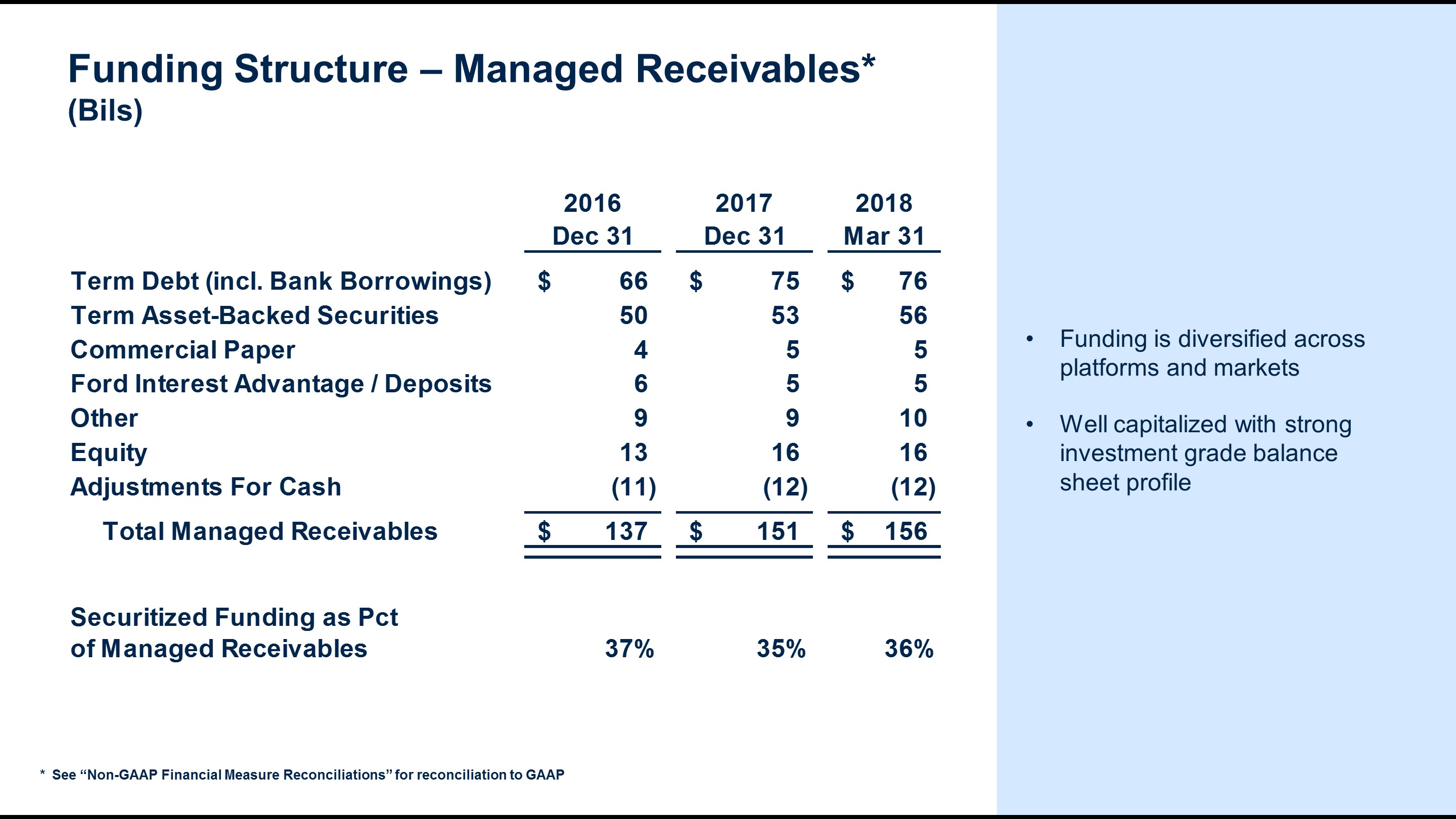
Managed receivables of $156 billion as of March 31, 2018, were funded primarily with term debt and term asset-backed securities. Securitized funding as a percent of managed receivables was 36%. Ford Credit expects the mix of securitized funding to remain around 35%. The calendarization of the funding plan will result in quarterly fluctuations of the securitized funding percentage.
51
Item 2. Management's Discussion and Analysis of Financial Condition and Results of Operations (Continued)
Public Term Funding Plan. The following chart shows Ford Credit's issuances for full-year 2016 and 2017, planned issuances for full-year 2018, and its global public term funding issuances through April 24, 2018, excluding short-term funding programs:
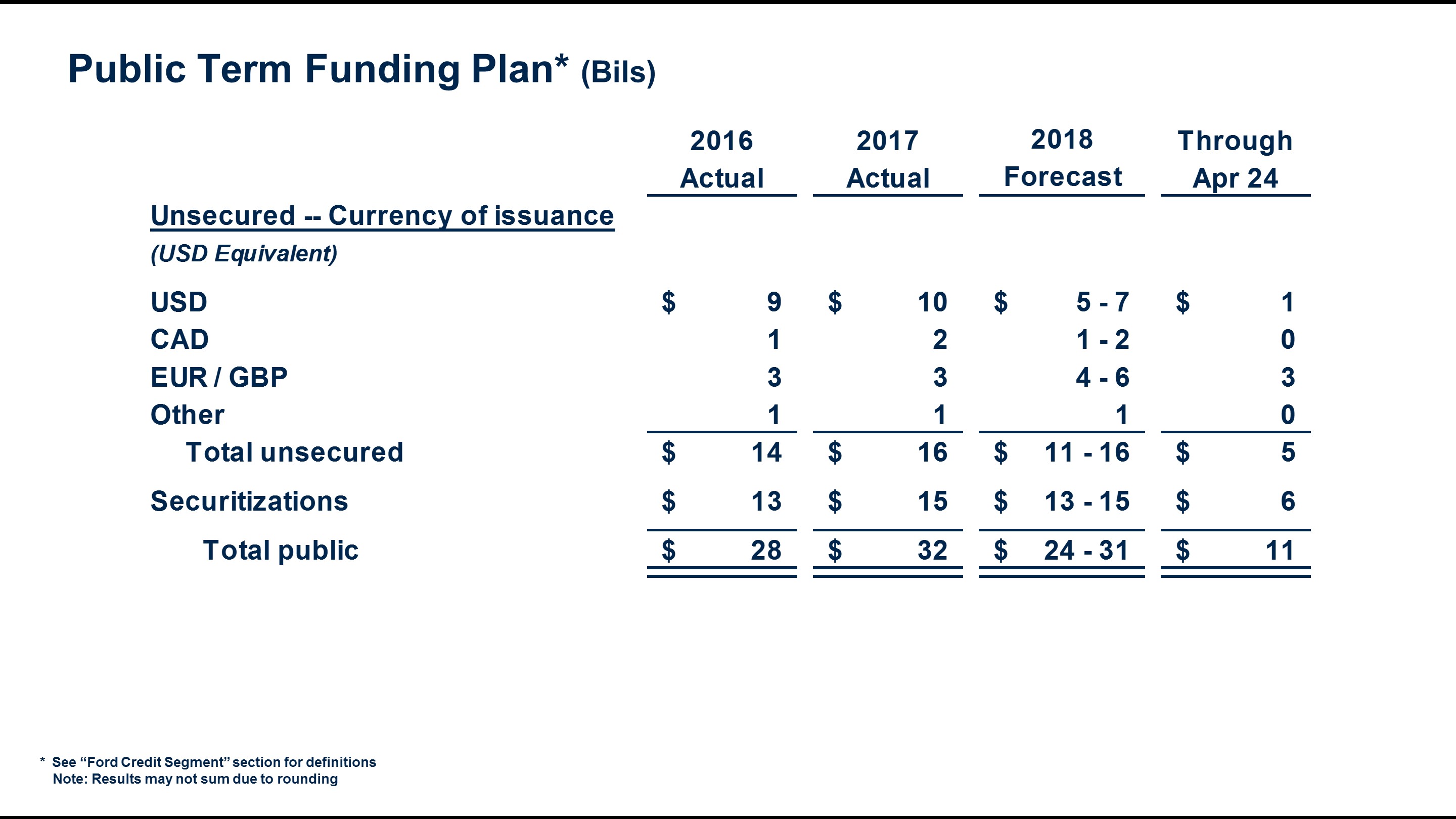
Ford Credit's total unsecured public term funding plan is categorized by currency of issuance. Ford Credit plans to issue its European debt from the United States. For 2018, Ford Credit projects full-year public term funding in the range of $24 billion to $31 billion. The range is lower than the prior forecast reflecting higher utilization of private ABS facilities to align to Ford Credit's liquidity target and lower receivables growth. As noted, Ford Credit plans to maintain its managed receivables level for the foreseeable future at about the same level as at the end of first quarter 2018. Through April 24, 2018, Ford Credit has completed $11 billion of public term issuances.
52
Item 2. Management's Discussion and Analysis of Financial Condition and Results of Operations (Continued)
Liquidity. The following chart shows Ford Credit's liquidity sources and utilization:
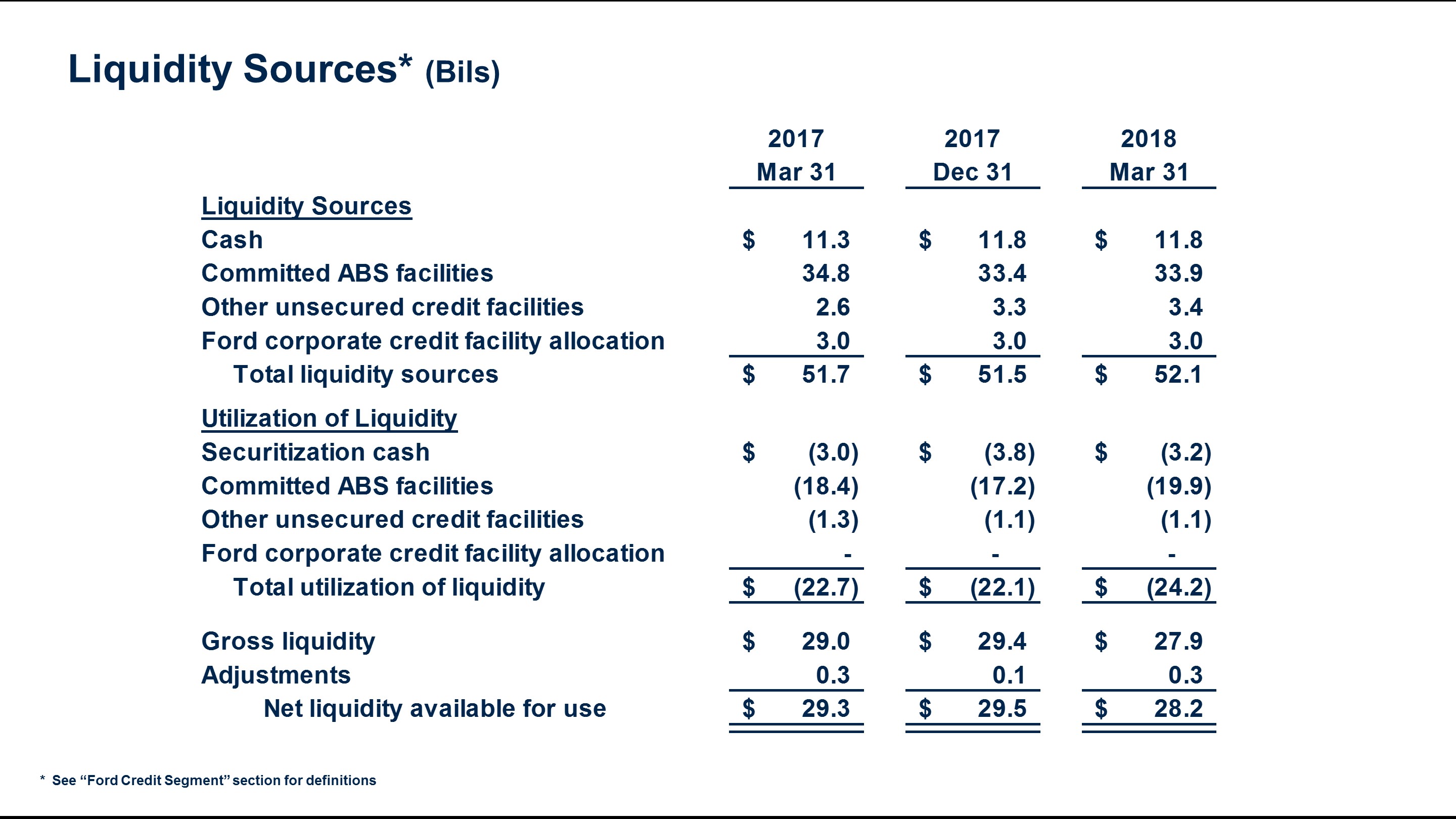
Ford Credit's liquidity available for use will fluctuate quarterly based on factors including near-term debt maturities, receivable growth, and timing of funding transactions. Ford Credit targets liquidity of at least $25 billion. At March 31, 2018, Ford Credit's liquidity available for use was $1.3 billion lower than at year-end 2017 and $1.1 billion lower than at March 31, 2017.
Ford Credit's sources of liquidity include cash, committed asset-backed facilities, unsecured credit facilities, and the corporate credit facility allocation.
53
Item 2. Management's Discussion and Analysis of Financial Condition and Results of Operations (Continued)
Leverage. Ford Credit uses leverage, or the debt-to-equity ratio, to make various business decisions, including evaluating and establishing pricing for finance receivable and operating lease financing, and assessing its capital structure.
The chart below shows the calculation of Ford Credit's financial statement leverage and managed leverage:
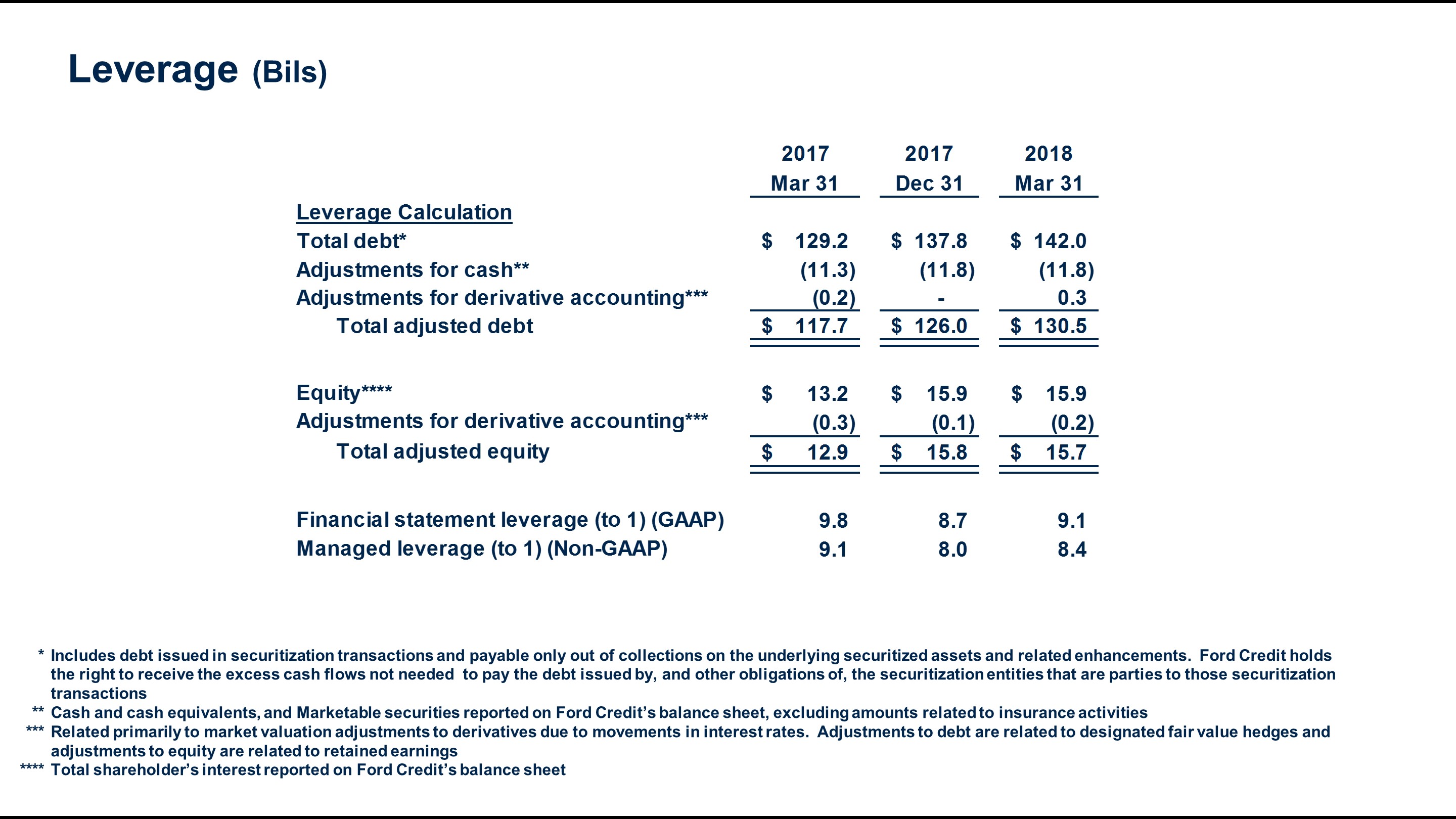
Ford Credit plans its managed leverage by considering prevailing market conditions and the risk characteristics of its business. At March 31, 2018, Ford Credit's financial statement leverage was 9.1:1, and its managed leverage was 8.4:1. Ford Credit targets managed leverage in the range of 8:1 to 9:1.
Total Company
Pension Plans - Underfunded Balances. As of March 31, 2018 , our total Company pension underfunded status reported on our balance sheet was $6.3 billion and reflects the net underfunded status at December 31, 2017 , updated for service and interest cost, expected return on assets, separation expense, interim remeasurement expense, actual benefit payments, and cash contributions. The discount rate and rate of expected return assumptions are unchanged from year-end 2017, and the reported number does not reflect the impact from any change in interest rates or asset returns since year-end 2017.
Based on our planning assumptions for asset returns, discount rates, and contributions, we expect our funded status to improve at year-end 2018 compared to the end of 2017.
54
Item 2. Management's Discussion and Analysis of Financial Condition and Results of Operations (Continued)
CREDIT RATINGS
Our short-term and long-term debt is rated by four credit rating agencies designated as nationally recognized statistical rating organizations ("NRSROs") by the U.S. Securities and Exchange Commission:
• DBRS Limited ("DBRS");
• Fitch Ratings, Inc. ("Fitch");
• Moody's Investors Service, Inc. ("Moody's"); and
• S&P Global Ratings ("S&P").
In several markets, locally-recognized rating agencies also rate us. A credit rating reflects an assessment by the rating agency of the credit risk associated with a corporate entity or particular securities issued by that entity. Rating agencies' ratings of us are based on information provided by us and other sources. Credit ratings are not recommendations to buy, sell, or hold securities, and are subject to revision or withdrawal at any time by the assigning rating agency. Each rating agency may have different criteria for evaluating company risk and, therefore, ratings should be evaluated independently for each rating agency.
There have been no rating actions taken by these NRSROs since the filing of our 2017 Form 10-K Report.
The following chart summarizes certain of the credit ratings and outlook presently assigned by these four NRSROs:
| NRSRO RATINGS | ||||||||||||
| Ford |
| Ford Credit |
| NRSROs | ||||||||
| Issuer Default / Corporate / Issuer Rating |
| Long-Term Senior Unsecured |
| Outlook / Trend |
| Long-Term Senior Unsecured |
| Short-Term Unsecured |
| Outlook / Trend |
| Minimum Long-Term Investment Grade Rating |
DBRS | BBB |
| BBB |
| Stable |
| BBB |
| R-2M |
| Stable |
| BBB (low) |
Fitch | BBB |
| BBB |
| Stable |
| BBB |
| F2 |
| Stable |
| BBB- |
Moody's | N/A |
| Baa2 |
| Negative |
| Baa2 |
| P-2 |
| Negative |
| Baa3 |
S&P | BBB |
| BBB |
| Stable |
| BBB |
| A-2 |
| Stable |
| BBB- |
55
Item 2. Management's Discussion and Analysis of Financial Condition and Results of Operations (Continued)
OUTLOOK
Based on the current economic environment, our Company guidance for 2018 includes the following:
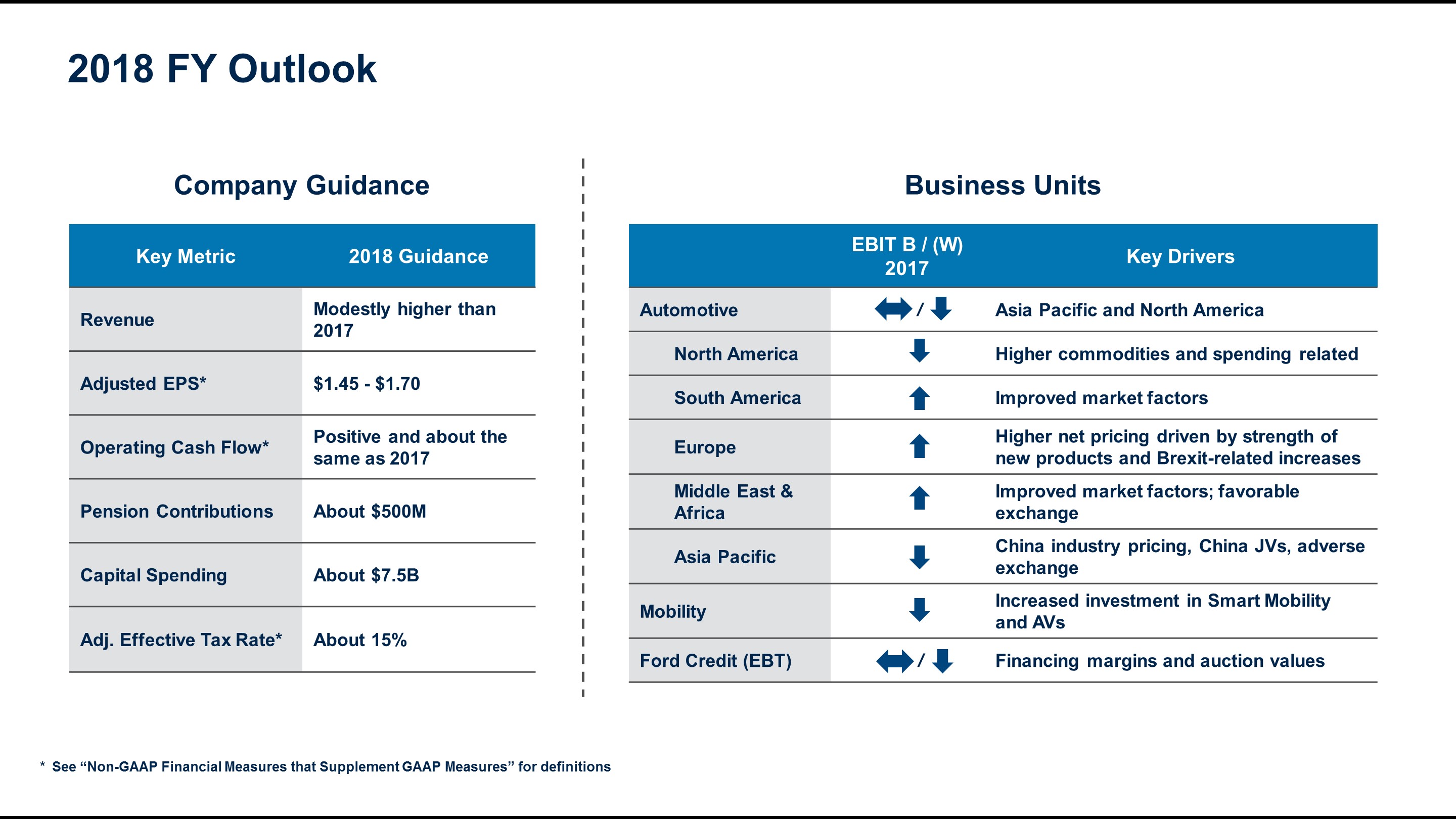
Looking at the full year, our Company guidance reflects the following:
• | Company revenue to be modestly higher than 2017; |
• | Company adjusted EPS to be in a range of $1.45 to $1.70; |
• | Company operating cash flow to be positive and about the same as 2017; |
• | Pension contributions of about $500 million; |
• | Capital spending of about $7.5 billion; and |
• | An adjusted effective tax rate of about 15% |
In addition:
• | For the full year, we are guiding to lower EBIT in North America due to higher commodity cost and higher spending to support future growth. |
• | We expect to incur a loss in Asia Pacific again in the second quarter of 2018, with profits returning in the second half of the year as we begin to launch 16 new products. For the full year, EBIT will be lower driven by our first-half performance, with the run rate of the business strengthening through the fourth quarter. |
• | For the full year, we expect EBIT in Europe to improve from 2017 levels due to a heavy mix of new products, which should drive strongly higher net pricing. From the end of 2017 through 2019, Europe will benefit from an 88% volume-weighted mix of all-new or significantly new products. |
• | For the full year, we expect Ford Credit EBT to be flat-to-lower than 2017 as we continue to plan for lower financing margins due to rising interest rates. While we expect auction values to trend better than our initial expectations, we expect them to be down slightly year-over-year. |
56
Item 2. Management's Discussion and Analysis of Financial Condition and Results of Operations (Continued)
NON-GAAP FINANCIAL MEASURE RECONCILIATIONS
The following charts show our Non-GAAP financial measure reconciliations for: Adjusted EBIT, Adjusted Earnings Per Share, Adjusted Effective Tax Rate, Company Operating Cash Flow, and Ford Credit Managed Receivables. The GAAP reconciliation for Ford Credit Managed Leverage can be found in the Ford Credit Segment section of "Liquidity and Capital Resources."
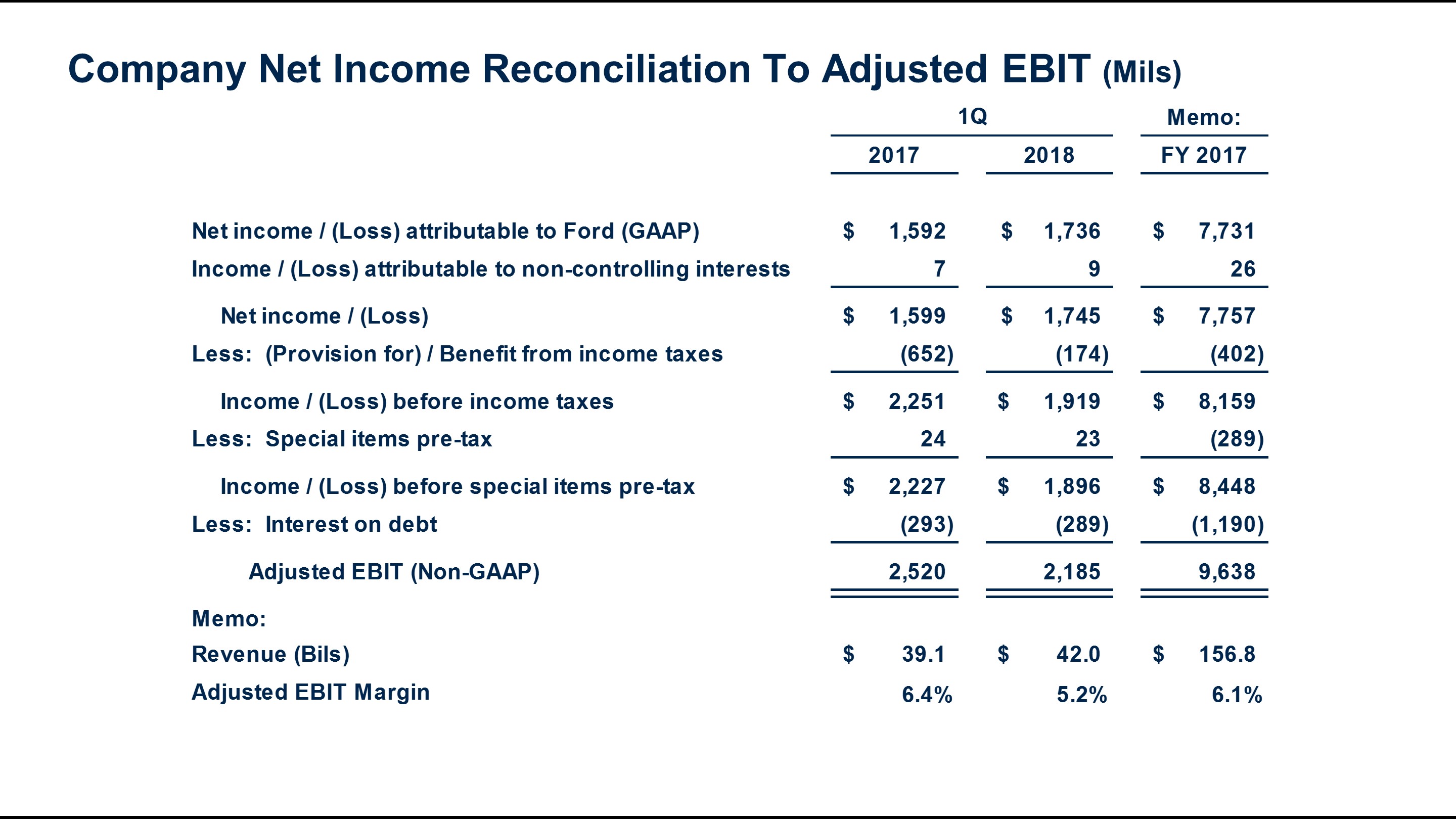
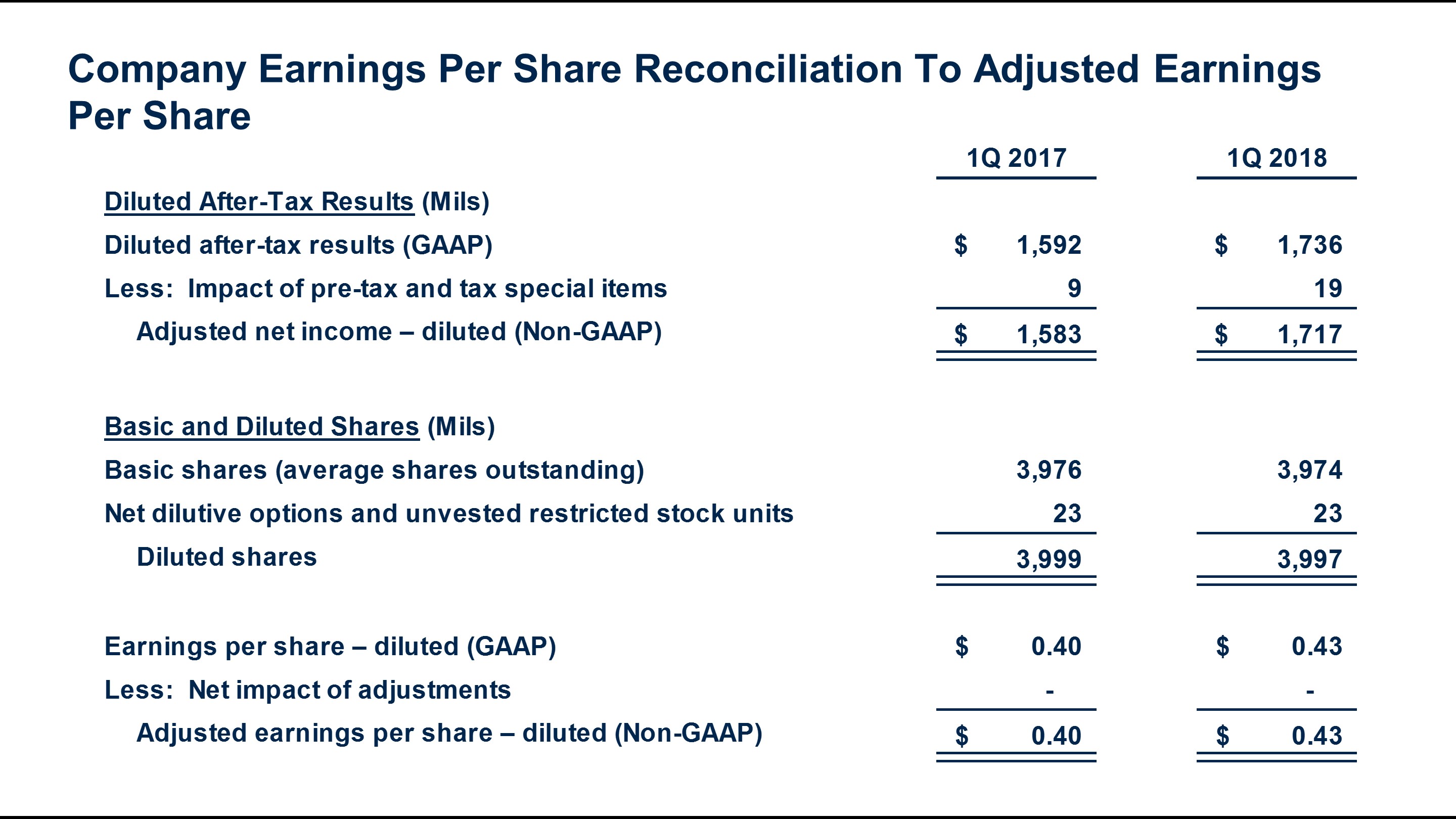
57
Item 2. Management's Discussion and Analysis of Financial Condition and Results of Operations (Continued)
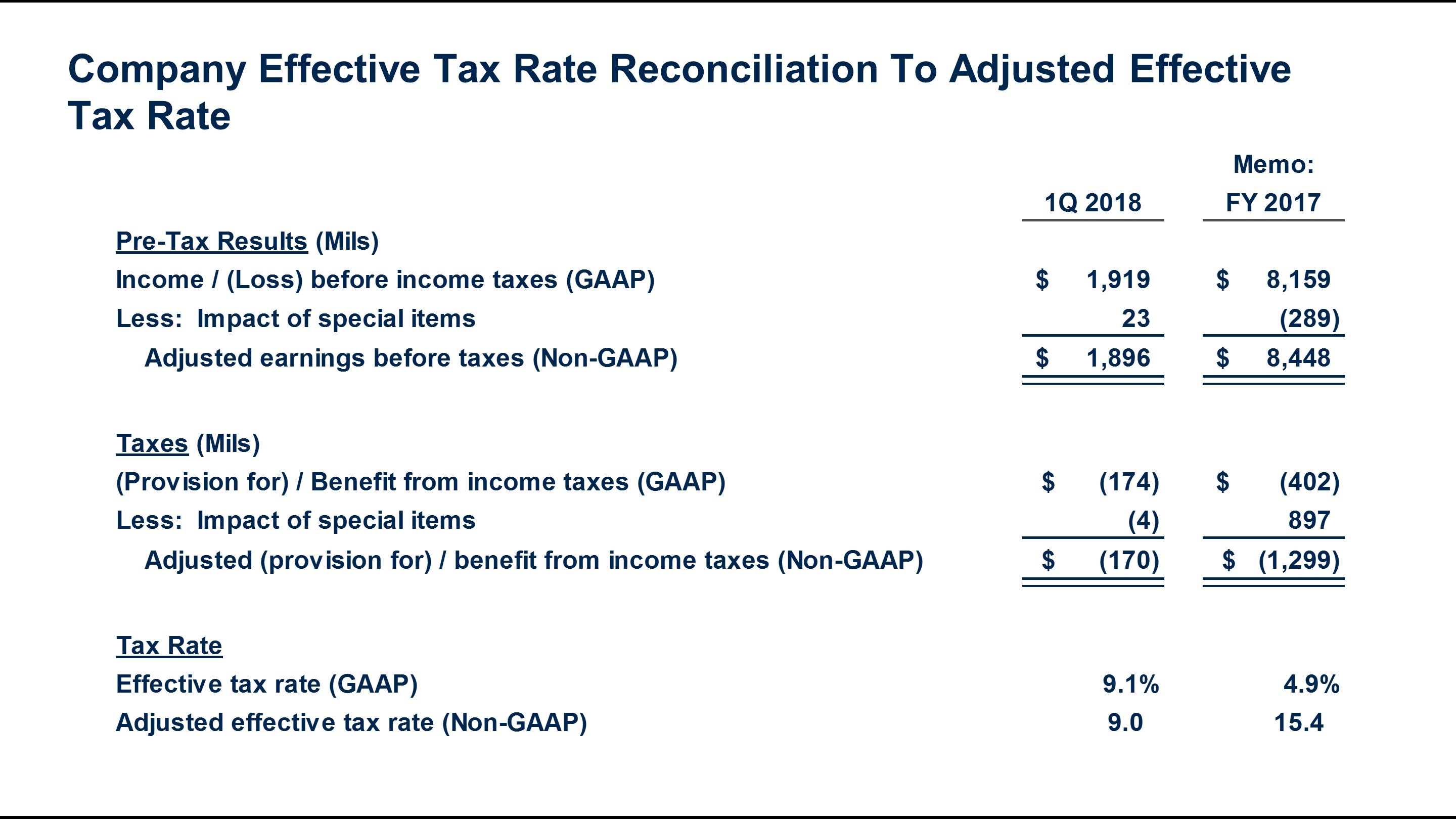
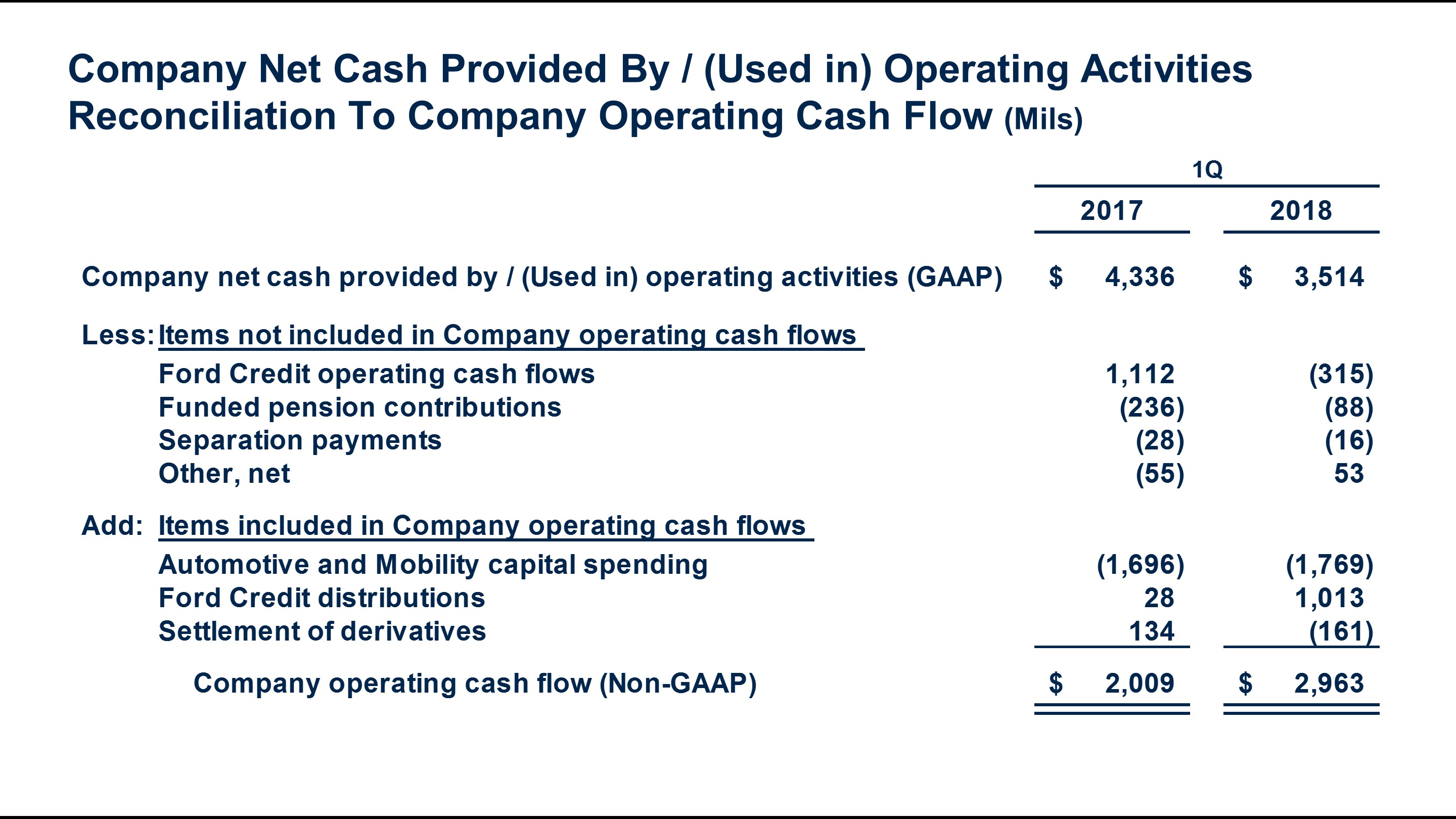
58
Item 2. Management's Discussion and Analysis of Financial Condition and Results of Operations (Continued)
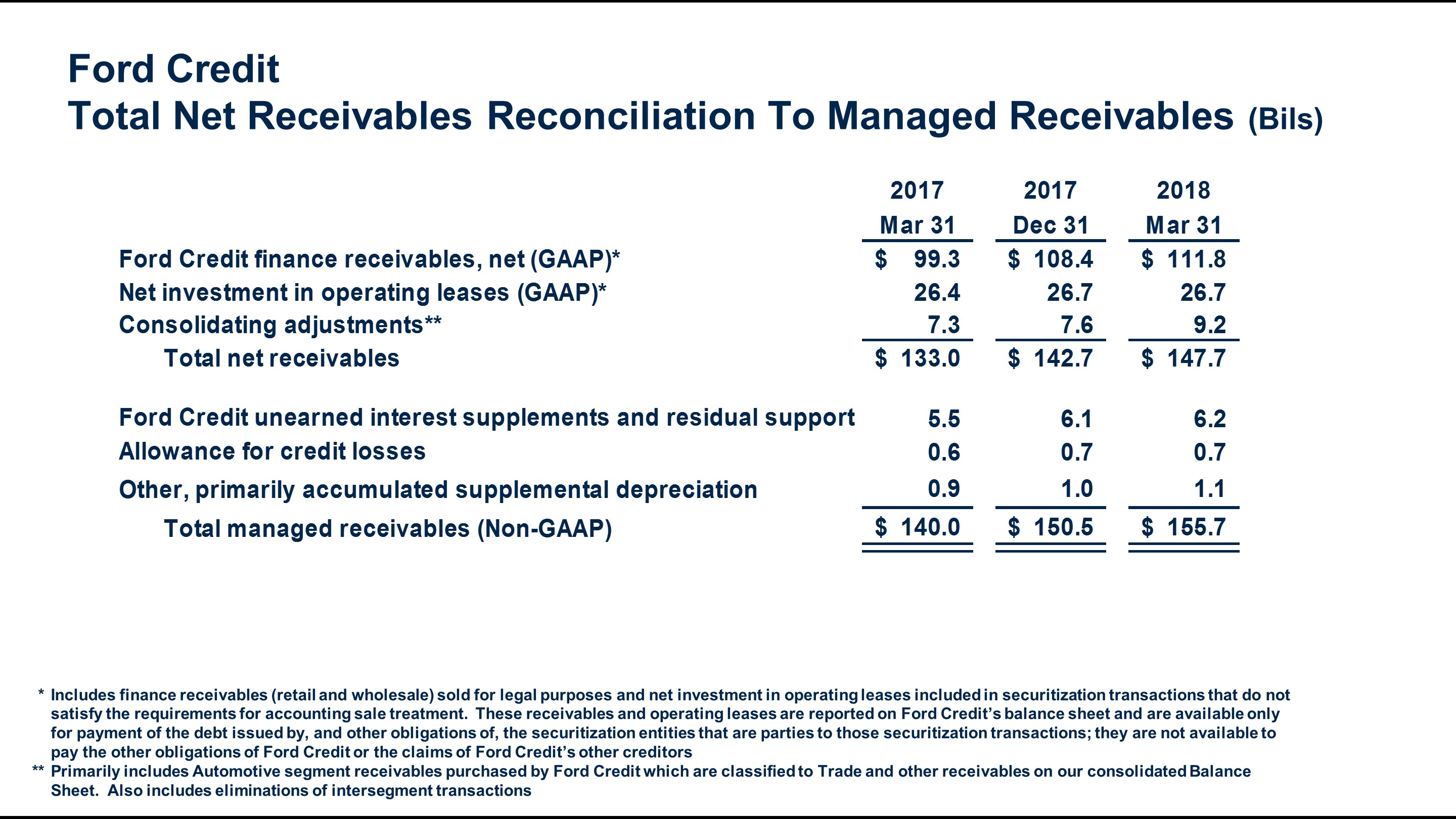
59
Item 2. Management's Discussion and Analysis of Financial Condition and Results of Operations (Continued)
Supplemental Information
The tables below provide supplemental consolidating financial information, other financial information, and U.S. sales by type. Company excluding Ford Credit includes our Automotive and Mobility reportable segments, Corporate Other, Interest on Debt, and Special Items. Eliminations, where presented, primarily represent eliminations of intersegment transactions and deferred tax netting.
Selected Income Statement Information. The following table provides supplemental income statement information (in millions):
|
| For the period ended March 31, 2018 | ||||||||||||||||||||||
|
| First Quarter | ||||||||||||||||||||||
|
| Company excluding Ford Credit |
|
|
|
| ||||||||||||||||||
|
| Automotive |
| Mobility |
| Other (a) |
| Subtotal |
| Ford Credit |
| Consolidated | ||||||||||||
Revenues |
| $ | 39,012 | |
| $ | 4 | |
| $ | - | |
| $ | 39,016 | |
| $ | 2,943 | |
| $ | 41,959 | |
Total costs and expenses | 38,146 | |
| 164 | |
| 190 | |
| 38,500 | |
| 2,338 | |
| 40,838 | | |||||||
Interest expense on Automotive debt | - | |
| - | |
| 275 | |
| 275 | |
| - | |
| 275 | | |||||||
Interest expense on Other debt | - | |
| - | |
| 14 | |
| 14 | |
| - | |
| 14 | | |||||||
Other income/(loss), net | 648 | |
| 58 | |
| 127 | |
| 833 | |
| 30 | |
| 863 | | |||||||
Equity in net income of affiliated companies | 218 | |
| - | |
| - | |
| 218 | |
| 6 | |
| 224 | | |||||||
Income/(loss) before income taxes | 1,732 | |
| (102 | ) |
| (352 | ) |
| 1,278 | |
| 641 | |
| 1,919 | | |||||||
Provision for/(Benefit from) income taxes | 345 | |
| (25 | ) |
| (86 | ) |
| 234 | |
| (60 | ) |
| 174 | | |||||||
Net income/(Loss) | 1,387 | |
| (77 | ) |
| (266 | ) |
| 1,044 | |
| 701 | |
| 1,745 | | |||||||
Less: Income/(Loss) attributable to noncontrolling interests | 9 | |
| - | |
| - | |
| 9 | |
| - | |
| 9 | | |||||||
Net income/(Loss) attributable to Ford Motor Company | $ | 1,378 | |
| $ | (77 | ) |
| $ | (266 | ) |
| $ | 1,035 | |
| $ | 701 | |
| $ | 1,736 | | |
(a) Other includes Corporate Other, Interest on Debt, and Special Items
60
Item 2. Management's Discussion and Analysis of Financial Condition and Results of Operations (Continued)
Selected Balance Sheet Information. The following tables provide supplemental balance sheet information (in millions):
|
| March 31, 2018 | ||||||||||||||
Assets |
| Company excluding Ford Credit |
| Ford Credit |
| Eliminations |
| Consolidated | ||||||||
Cash and cash equivalents |
| $ | 9,174 | |
| $ | 8,766 | |
| $ | - | |
| $ | 17,940 | |
Marketable securities |
| 18,423 | |
| 3,708 | |
| - | |
| 22,131 | | ||||
Ford Credit finance receivables, net |
| - | |
| 54,680 | |
| - | |
| 54,680 | | ||||
Trade and other receivables, less allowances |
| 4,281 | |
| 8,105 | |
| - | |
| 12,386 | | ||||
Inventories |
| 12,371 | |
| - | |
| - | |
| 12,371 | | ||||
Other assets |
| 2,563 | |
| 1,193 | |
| - | |
| 3,756 | | ||||
Receivable from other segments |
| 441 | |
| 1,647 | |
| (2,088 | ) |
| - | | ||||
Total current assets |
| 47,253 | |
| 78,099 | |
| (2,088 | ) |
| 123,264 | | ||||
|
|
|
|
|
|
|
|
| ||||||||
Ford Credit finance receivables, net |
| - | |
| 57,121 | |
| - | |
| 57,121 | | ||||
Net investment in operating leases |
| 1,616 | |
| 26,715 | |
| - | |
| 28,331 | | ||||
Net property |
| 35,937 | |
| 181 | |
| - | |
| 36,118 | | ||||
Equity in net assets of affiliated companies |
| 3,096 | |
| 117 | |
| - | |
| 3,213 | | ||||
Deferred income taxes |
| 12,702 | |
| 239 | |
| (2,304 | ) |
| 10,637 | | ||||
Other assets |
| 6,938 | |
| 1,608 | |
| - | |
| 8,546 | | ||||
Receivable from other segments |
| 1 | |
| 502 | |
| (503 | ) |
| - | | ||||
Total assets |
| $ | 107,543 | |
| $ | 164,582 | |
| $ | (4,895 | ) |
| $ | 267,230 | |
Liabilities |
| Company excluding Ford Credit |
| Ford Credit |
| Eliminations |
| Consolidated | ||||||||
Payables |
| $ | 24,126 | |
| $ | 1,354 | |
| $ | - | |
| $ | 25,480 | |
Other liabilities and deferred revenue |
| 19,989 | |
| 1,426 | |
| - | |
| 21,415 | | ||||
Automotive debt payable within one year |
| 3,751 | |
| - | |
| - | |
| 3,751 | | ||||
Ford Credit debt payable within one year |
| - | |
| 49,232 | |
| - | |
| 49,232 | | ||||
Payable to other segments |
| 2,088 | |
| - | |
| (2,088 | ) |
| - | | ||||
Total current liabilities |
| 49,954 | |
| 52,012 | |
| (2,088 | ) |
| 99,878 | | ||||
|
|
|
|
|
|
|
|
| ||||||||
Other liabilities and deferred revenue |
| 23,417 | |
| 1,428 | |
| - | |
| 24,845 | | ||||
Automotive long-term debt |
| 12,071 | |
| - | |
| - | |
| 12,071 | | ||||
Ford Credit long-term debt |
| - | |
| 92,681 | |
| - | |
| 92,681 | | ||||
Other long-term debt |
| 599 | |
| - | |
| - | |
| 599 | | ||||
Deferred income taxes |
| 150 | |
| 2,776 | |
| (2,304 | ) |
| 622 | | ||||
Payable to other segments |
| 503 | |
| - | |
| (503 | ) |
| - | | ||||
Total liabilities |
| $ | 86,694 | |
| $ | 148,897 | |
| $ | (4,895 | ) |
| $ | 230,696 | |
61
Item 2. Management's Discussion and Analysis of Financial Condition and Results of Operations (Continued)
Selected Cash Flow Information. The following tables provide supplemental cash flow information (in millions):
|
| For the period ended March 31, 2018 | ||||||||||||||
|
| First Quarter | ||||||||||||||
Cash flows from operating activities |
| Company excluding Ford Credit |
| Ford Credit |
| Eliminations |
| Consolidated | ||||||||
Net cash provided by/(used in) operating activities |
| $ | 3,829 | |
| $ | (315 | ) |
| $ | - | |
| $ | 3,514 | |
Cash flows from investing activities |
| Company excluding Ford Credit |
| Ford Credit |
| Eliminations |
| Consolidated | ||||||||
Capital spending |
| $ | (1,769 | ) |
| $ | (10 | ) |
| $ | - | |
| $ | (1,779 | ) |
Acquisitions of finance receivables and operating leases |
| - | |
| (15,683 | ) |
| - | |
| (15,683 | ) | ||||
Collections of finance receivables and operating leases |
| - | |
| 12,956 | |
| - | |
| 12,956 | | ||||
Purchases of equity and debt securities |
| (5,580 | ) |
| (2,287 | ) |
| - | |
| (7,867 | ) | ||||
Sales and maturities of equity and debt securities |
| 4,618 | |
| 1,422 | |
| - | |
| 6,040 | | ||||
Settlements of derivatives |
| (161 | ) |
| 100 | |
| - | |
| (61 | ) | ||||
Other |
| (150 | ) |
| - | |
| - | |
| (150 | ) | ||||
Investing activity (to)/from other segments |
| 1,024 | |
| 153 | |
| (1,177 | ) |
| - | | ||||
Net cash provided by/(used in) investing activities |
| $ | (2,018 | ) |
| $ | (3,349 | ) |
| $ | (1,177 | ) |
| $ | (6,544 | ) |
Cash flows from financing activities |
| Company excluding Ford Credit |
| Ford Credit |
| Eliminations |
| Consolidated | ||||||||
Cash dividends |
| $ | (1,113 | ) |
| $ | - | |
| $ | - | |
| $ | (1,113 | ) |
Purchases of common stock |
| (89 | ) |
| - | |
| - | |
| (89 | ) | ||||
Net changes in short-term debt |
| (128 | ) |
| (781 | ) |
| - | |
| (909 | ) | ||||
Proceeds from issuance of other debt |
| 174 | |
| 16,779 | |
| - | |
| 16,953 | | ||||
Principal payments on other debt |
| (204 | ) |
| (12,156 | ) |
| - | |
| (12,360 | ) | ||||
Other |
| (39 | ) |
| (29 | ) |
| - | |
| (68 | ) | ||||
Financing activity to/(from) other segments |
| (153 | ) |
| (1,024 | ) |
| 1,177 | |
| - | | ||||
Net cash provided by/(used in) financing activities |
| $ | (1,552 | ) |
| $ | 2,789 | |
| $ | 1,177 | |
| $ | 2,414 | |
|
|
|
|
|
|
|
|
| ||||||||
Effect of exchange rate changes on cash, cash equivalents, and restricted cash | $ | 9 | |
| $ | 106 | |
| $ | - | |
| $ | 115 | | |
62
Item 2. Management's Discussion and Analysis of Financial Condition and Results of Operations (Continued)
Selected Other Information.
Cost of sales and Selling, administrative, and other expenses for the first quarter of 2018 were $38.5 billion, an increase of $3 billion compared with the first quarter of 2017. The detail for the change is shown below (in billions):
| 2018 Lower/(Higher) 2017 | ||
| First Quarter | ||
Volume and mix, exchange, and other | $ | (2.4 | ) |
Contribution costs |
| ||
Material excluding commodities | (0.1 | ) | |
Commodities | (0.5 | ) | |
Freight and other | - | | |
Warranty | 0.3 | | |
Structural costs | (0.2 | ) | |
Special items | (0.1 | ) | |
Total | $ | (3.0 | ) |
Equity. At March 31, 2018 , total equity attributable to Ford was $36.4 billion, an increase of about $800 million compared with December 31, 2017 . The detail for this change is shown below (in billions):
| Increase/ (Decrease) | ||
Net income | $ | 1.7 | |
Shareholder distributions | (1.2 | ) | |
Other comprehensive income | 0.3 | | |
Total | $ | 0.8 | |
U.S. Sales by Type. The following table shows first quarter 2018 U.S. sales volume and U.S. wholesales segregated by truck, SUV, and car sales. U.S. sales volume reflects transactions with (i) retail and fleet customers (as reported by dealers), (ii) governments, and (iii) Ford management. U.S. wholesales reflect sales to dealers.
| U.S. Sales |
| U.S. Wholesales | ||
Trucks | 267,860 | |
| 284,097 | |
SUVs | 202,927 | |
| 260,830 | |
Cars | 128,794 | |
| 158,016 | |
Total Vehicles | 599,581 | |
| 702,943 | |
63
Item 2. Management's Discussion and Analysis of Financial Condition and Results of Operations (Continued)
Cautionary Note on Forward-Looking Statements
Statements included or incorporated by reference herein may constitute "forward-looking statements" within the meaning of the Private Securities Litigation Reform Act of 1995. Forward-looking statements are based on expectations, forecasts, and assumptions by our management and involve a number of risks, uncertainties, and other factors that could cause actual results to differ materially from those stated, including, without limitation:
• | Ford's long-term competitiveness depends on the successful execution of fitness actions; |
• | Industry sales volume, particularly in the United States, Europe, or China, could decline if there is a financial crisis, recession, or significant geopolitical event; |
• | Ford's new and existing products and mobility services are subject to market acceptance; |
• | Ford's results are dependent on sales of larger, more profitable vehicles, particularly in the United States; |
• | Ford may face increased price competition resulting from industry excess capacity, currency fluctuations, or other factors; |
• | Fluctuations in commodity prices, foreign currency exchange rates, and interest rates can have a significant effect on results; |
• | With a global footprint, Ford's results could be adversely affected by economic, geopolitical, protectionist trade policies, or other events; |
• | Ford's production, as well as Ford's suppliers' production, could be disrupted by labor disputes, natural or man-made disasters, financial distress, production difficulties, or other factors; |
• | Ford's ability to maintain a competitive cost structure could be affected by labor or other constraints; |
• | Pension and other postretirement liabilities could adversely affect Ford's liquidity and financial condition; |
• | Economic and demographic experience for pension and other postretirement benefit plans (e.g., discount rates or investment returns) could be worse than Ford has assumed; |
• | Ford's vehicles could be affected by defects that result in delays in new model launches, recall campaigns, or increased warranty costs; |
• | Safety, emissions, fuel economy, and other regulations affecting Ford may become more stringent; |
• | Ford could experience unusual or significant litigation, governmental investigations, or adverse publicity arising out of alleged defects in products, perceived environmental impacts, or otherwise; |
• | Ford's receipt of government incentives could be subject to reduction, termination, or clawback; |
• | Operational systems, security systems, and vehicles could be affected by cyber incidents; |
• | Ford Credit's access to debt, securitization, or derivative markets around the world at competitive rates or in sufficient amounts could be affected by credit rating downgrades, market volatility, market disruption, regulatory requirements, or other factors; |
• | Ford Credit could experience higher-than-expected credit losses, lower-than-anticipated residual values, or higher-than-expected return volumes for leased vehicles; |
• | Ford Credit could face increased competition from banks, financial institutions, or other third parties seeking to increase their share of financing Ford vehicles; and |
• | Ford Credit could be subject to new or increased credit regulations, consumer or data protection regulations, or other regulations. |
We cannot be certain that any expectation, forecast, or assumption made in preparing forward-looking statements will prove accurate, or that any projection will be realized. It is to be expected that there may be differences between projected and actual results. Our forward-looking statements speak only as of the date of their initial issuance, and we do not undertake any obligation to update or revise publicly any forward-looking statement, whether as a result of new information, future events, or otherwise. For additional discussion, see "Item 1A. Risk Factors" in our 2017 Form 10-K Report, as updated by our subsequent Quarterly Reports on Form 10-Q and Current Reports on Form 8-K.
64
Item 2. Management's Discussion and Analysis of Financial Condition and Results of Operations (Continued)
ACCOUNTING STANDARDS ISSUED BUT NOT YET ADOPTED
The Financial Accounting Standards Board ("FASB") has issued the following standards, which are not expected to have a material impact (with the exception of standards 2016-02 and 2016-13) to our financial statements or financial statement disclosures:
Standard |
| Effective Date (a) | |
2018-02 | Reclassification of Certain Tax Effects from Accumulated Other Comprehensive Income |
| January 1, 2019 |
2016-02 | Leases |
| January 1, 2019 (b) (c) |
2016-13 | Credit Losses - Measurement of Credit Losses on Financial Instruments |
| January 1, 2020 (b) |
__________
(a) | Early adoption for each of the standards is permitted. |
(b) | For additional information, see Note 2 of the Notes to the Financial Statements. |
(c) | The FASB has issued the following update to the Leases standard: Accounting Standard Update ("ASU") 2018-01 (Land Easement Practical Expedient for Transition to Topic 842). We will adopt the new leases guidance effective January 1, 2019. |
REVIEW BY INDEPENDENT REGISTERED PUBLIC ACCOUNTING FIRM
The interim financial information included in this Quarterly Report on Form 10-Q for the periods ended
March 31, 2018 and 2017 has not been audited by PricewaterhouseCoopers LLP ("PwC"). In reviewing such information, PwC has applied limited procedures in accordance with professional standards for reviews of interim financial information. Readers should restrict reliance on PwC's reports on such information accordingly. PwC is not subject to the liability provisions of Section 11 of the Securities Act of 1933 for its reports on interim financial information, because such reports do not constitute "reports" or "parts" of registration statements prepared or certified by PwC within the meaning of Sections 7 and 11 of the Securities Act of 1933.
65
ITEM 3. Quantitative and Qualitative Disclosures About Market Risk.
Automotive Segment
Foreign Currency Risk. The net fair value of foreign exchange forward contracts (including adjustments for credit risk) as of March 31, 2018, was an asset of $104 million, compared with a liability of $22 million as of December 31, 2017. The potential decrease in fair value from a 10% adverse change in the underlying exchange rates, in U.S. dollar terms, was $2.8 billion at both March 31, 2018 and December 31, 2017 .
Commodity Price Risk. The net fair value of commodity forward contracts (including adjustments for credit risk) as of March 31, 2018, was a liability of $21 million, compared with an asset of $33 million at December 31, 2017 . The potential decrease in fair value from a 10% adverse change in the underlying commodity prices, in U.S. dollar terms, was $62 million at March 31, 2018, compared with $69 million at December 31, 2017 .
Ford Credit Segment
Interest Rate Risk . To provide a quantitative measure of the sensitivity of its pre-tax cash flow to changes in interest rates, Ford Credit uses interest rate scenarios that assume a hypothetical, instantaneous increase or decrease of one percentage point in all interest rates across all maturities (a "parallel shift"), as well as a base case that assumes that all interest rates remain constant at existing levels. The differences in pre-tax cash flow between these scenarios and the base case over a 12-month period represent an estimate of the sensitivity of Ford Credit's pre-tax cash flow . Under this model, Ford Credit estimates that at March 31, 2018 , all else constant, such an increase in interest rates would decrease its pre-tax cash flow by $17 million over the next 12 months, compared with an increase of $14 million at December 31, 2017 . In reality, interest rate changes are rarely instantaneous or parallel and rates could move more or less than the one percentage point assumed in Ford Credit's analysis. As a result, the actual impact to pre-tax cash flow could be higher or lower than the results detailed above.
ITEM 4. Controls and Procedures.
Evaluation of Disclosure Controls and Procedures. James P. Hackett, our Chief Executive Officer ("CEO"), and Bob Shanks, our Chief Financial Officer ("CFO"), have performed an evaluation of the Company's disclosure controls and procedures, as that term is defined in Rule 13a-15(e) of the Securities Exchange Act of 1934, as amended ("Exchange Act"), as of March 31, 2018 , and each has concluded that such disclosure controls and procedures are effective to ensure that information required to be disclosed in our periodic reports filed under the Exchange Act is recorded, processed, summarized, and reported within the time periods specified by SEC rules and forms, and that such information is accumulated and communicated to the CEO and CFO to allow timely decisions regarding required disclosures.
Changes in Internal Control Over Financial Reporting. There were no changes in internal control over financial reporting during the quarter ended March 31, 2018 that have materially affected, or are reasonably likely to materially affect, our internal control over financial reporting.
66
PART II. OTHER INFORMATION
ITEM 2. Unregistered Sales of Equity Securities and Use of Proceeds.
On February 15, 2018, we issued 8.6 million shares of Ford Common Stock valued at $96 million to certain stockholders of Autonomic, Inc. ("Autonomic") as part of the merger consideration in conjunction with Ford's acquisition of Autonomic. The issuance was made in reliance on an exemption from the registration requirements of the Securities Act of 1933, as amended, afforded by Regulation D thereunder. Each recipient of the shares represented to us that he or she was an "accredited investor" as defined in Rule 501(a) under the Securities Act, was not acquiring the shares with a view to or for sale in connection with any distribution of the shares within the meaning of the Securities Act, and had received and had access to adequate information about Ford. Approximately 8.2 million of the shares will vest over four years beginning February 2019. The remaining shares have various vesting schedules, with the first tranche vesting in May 2018. All of the shares are subject to restrictions on transfer.
In the first quarter of 2018, we repurchased shares of Ford Common Stock from our employees or directors related to certain exercises of stock options, in accordance with our various compensation plans. We also repurchased shares through a modest anti-dilutive share repurchase program to offset the dilutive effect of share-based compensation granted during 2018 and the shares issued as part of the Autonomic transaction described above. The plan authorized repurchases of up to 28.5 million shares of Ford Common Stock.
Period |
| Total Number of Shares Purchased |
| Average Price Paid per Share |
| Total Number of Shares Purchased as Part of Publicly- Announced Plans or Programs |
| Maximum Number (or Approximate Dollar Value) of Shares that May Yet Be Purchased Under the Plans or Programs | |||||
March 1, 2018 through March 31, 2018 |
| 8,015,658 | |
| $ | 11.05 | |
| - | |
| - | |
Total/Average |
| 8,015,658 | |
| $ | 11.05 | |
| - | |
| - | |
ITEM 6. Exhibits.
Designation |
| Description |
| Method of Filing |
Exhibit 10.1 |
| Annual Incentive Compensation Plan Metrics for 2018. |
| Filed with this Report. |
Exhibit 10.2 |
| Performance-Based Restricted Stock Unit Metrics for 2018. |
| Filed with this Report. |
Exhibit 12 |
| Calculation of Ratio of Earnings to Fixed Charges. |
| Filed with this Report. |
Exhibit 15 |
| Letter of PricewaterhouseCoopers LLP, dated April 25, 2018, relating to financial information. |
| Filed with this Report. |
Exhibit 18 |
| Letter of PricewaterhouseCoopers LLP, dated April 25, 2018, relating to change in accounting principle. |
| Filed with this Report. |
Exhibit 31.1 |
| Rule 15d-14(a) Certification of CEO. |
| Filed with this Report. |
Exhibit 31.2 |
| Rule 15d-14(a) Certification of CFO. |
| Filed with this Report. |
Exhibit 32.1 |
| Section 1350 Certification of CEO. |
| Furnished with this Report. |
Exhibit 32.2 |
| Section 1350 Certification of CFO. |
| Furnished with this Report. |
Exhibit 101.INS |
| XBRL Instance Document. |
| * |
Exhibit 101.SCH |
| XBRL Taxonomy Extension Schema Document. |
| * |
Exhibit 101.CAL |
| XBRL Taxonomy Extension Calculation Linkbase Document. |
| * |
Exhibit 101.LAB |
| XBRL Taxonomy Extension Label Linkbase Document. |
| * |
Exhibit 101.PRE |
| XBRL Taxonomy Extension Presentation Linkbase Document. |
| * |
Exhibit 101.DEF |
| XBRL Taxonomy Extension Definition Linkbase Document. |
| * |
__________
* Submitted electronically with this Report in accordance with the provisions of Regulation S-T.
67
SIGNATURE
Pursuant to the requirements of the Securities Exchange Act of 1934, the registrant has duly caused this report to be signed on its behalf by the undersigned thereunto duly authorized.
FORD MOTOR COMPANY
By: | /s/ John Lawler |
| John Lawler, Vice President and Controller |
| (principal accounting officer) |
|
|
Date: | April 25, 2018 |
68
